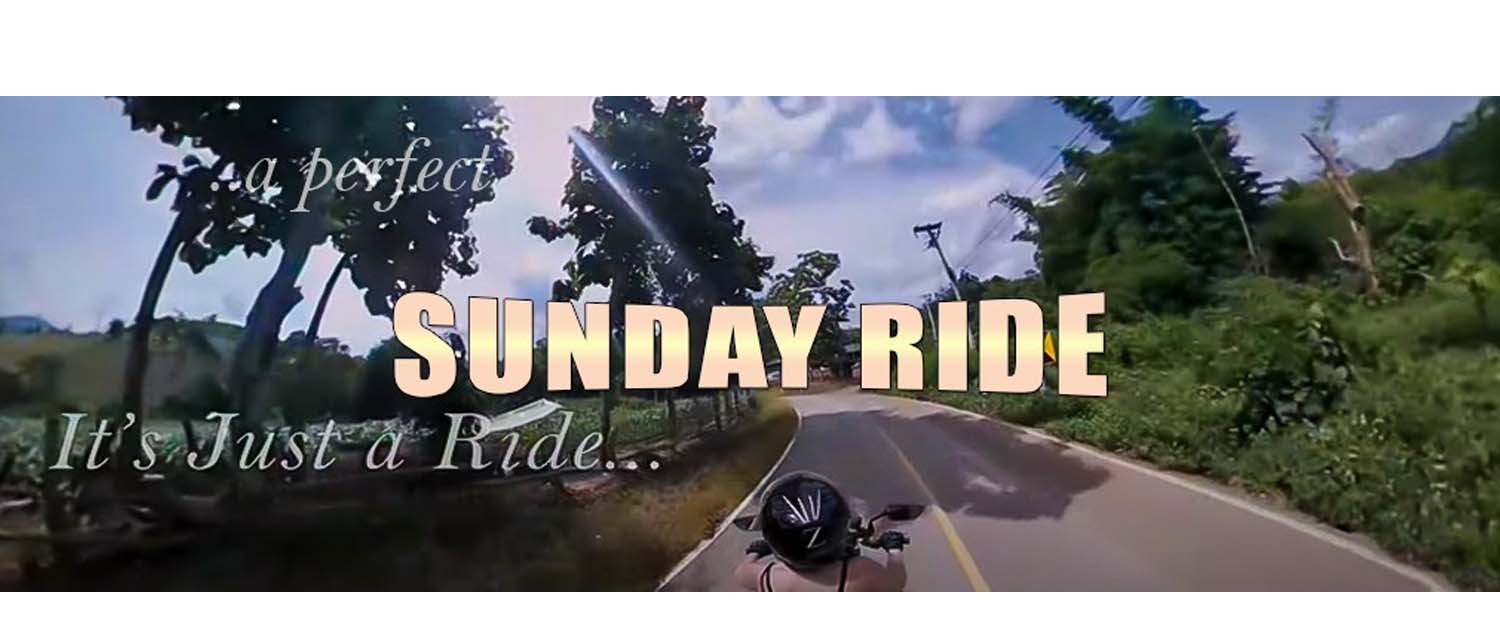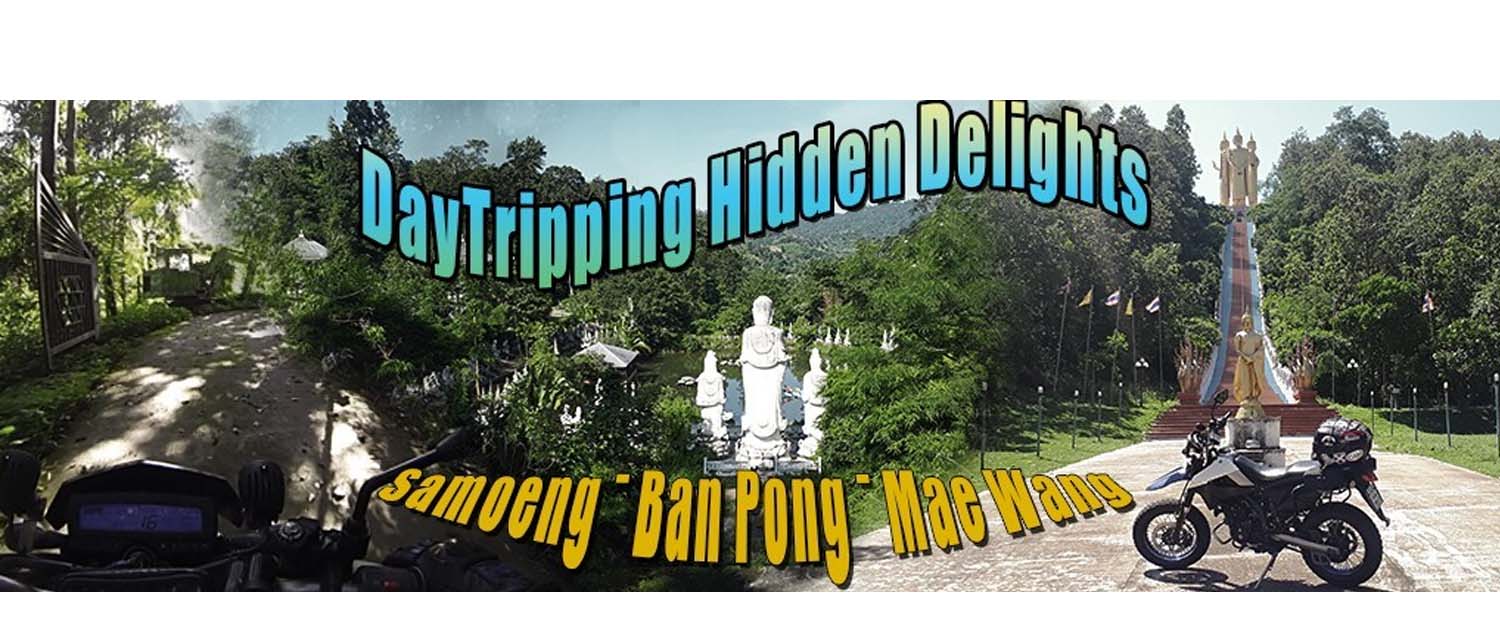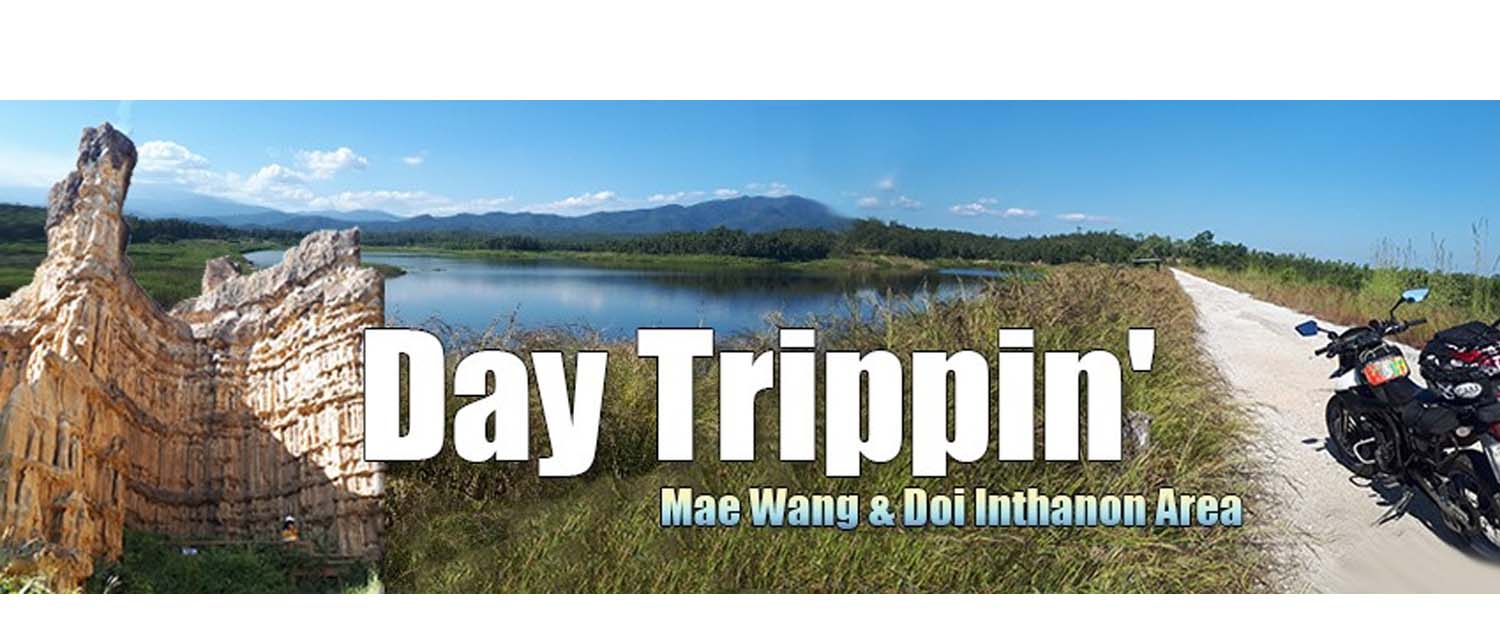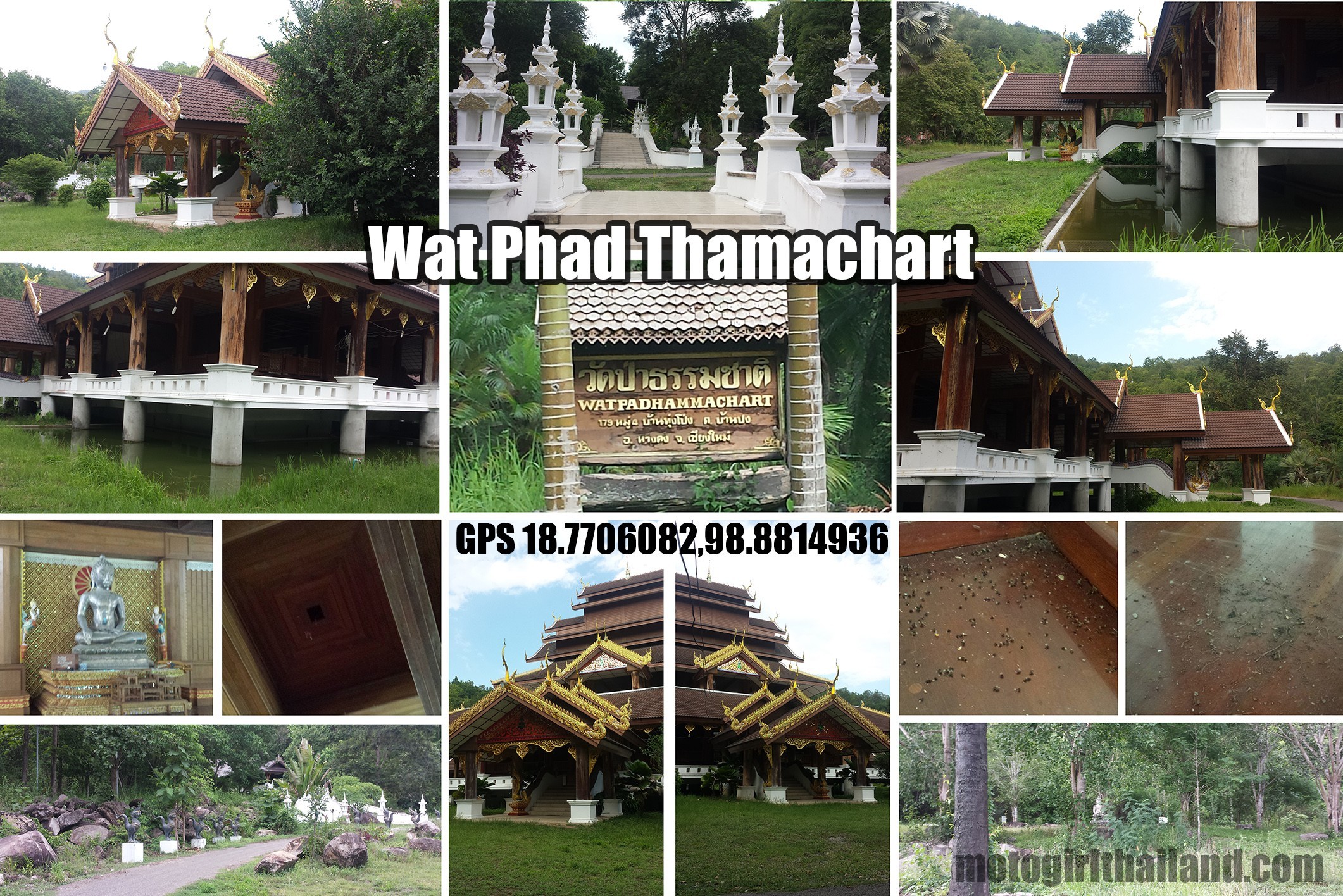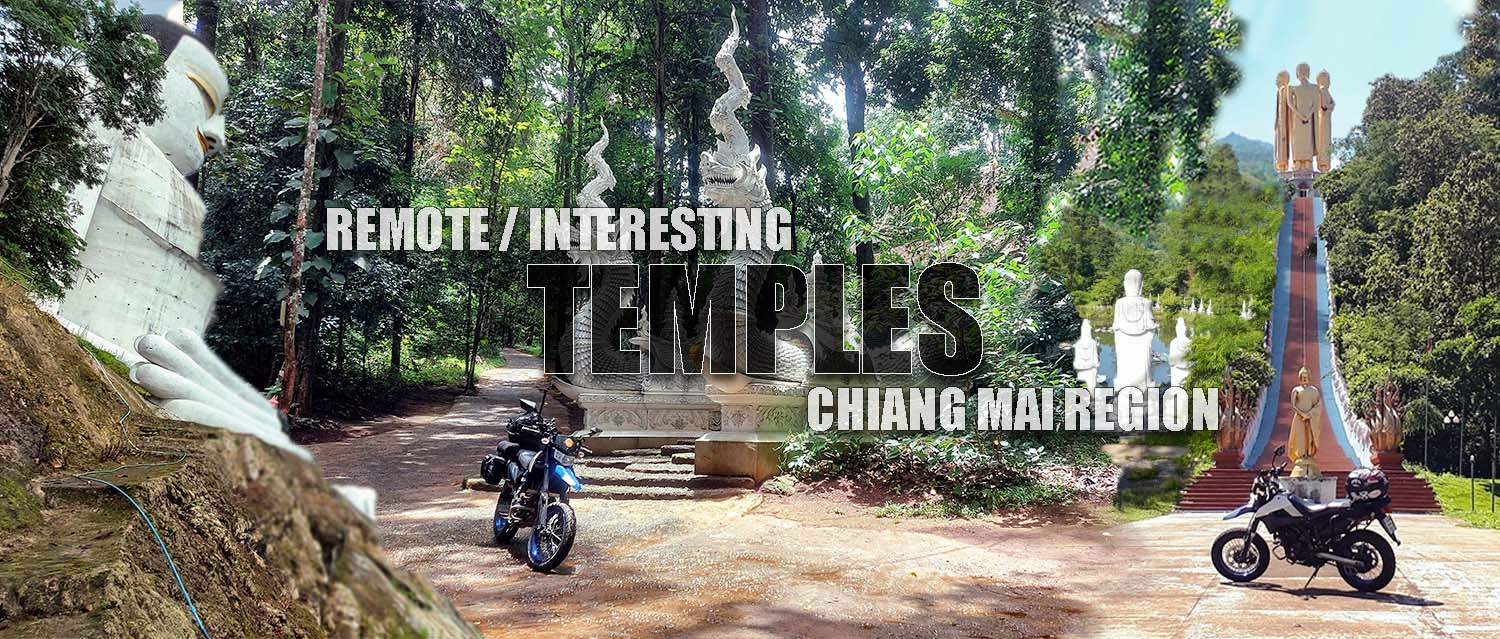
CURRENTLY BEING REWORKED – APOLOGIES FOR THE INCONVENIENCE
Venture beyond the tourist trail, and you’ll uncover a different side of Northern Thailand—a world of hidden Chiang Mai temples tucked deep in the jungle, perched on misty hillsides, or rooted in ancient legends. These 20 lesser-known temples aren’t just photo ops—they’re peaceful, often mystical spaces that offer a more intimate, authentic glimpse into the region’s spiritual and cultural soul.
1: Wat Phra That Doi Nok
The stunning พระธาตุดอยนก./ Doi Nok Pagoda (named “Bird Mountain Pagoda” due to the many birds in this peaceful area) is a sacred place for the local Tai Lui Hilltribe people of Ban Mae Sap.

Details
- Location: 60 km from the City (map)
- Opening Hours: Daily, 6:00 AM – 6:00 PM
- Entry: Free (donations welcomed)
- Best Time to Visit: Early morning during the Rainy Season and Cool Season for a chance to witness the breathtaking sea of mist and clouds. What makes the temple special is the morning mist.
- Parking: Limited parking is available on the temple grounds via a short, narrow, and steep route. From the base of the temple route, follow the steep road to find a parking spot. Alternatively, drivers and riders can park at the base of the hill and climb 1,297 steps to the pagoda.
- Food/Drinks: Nothing is available at the temple, but eateries are dotted around en route.
- Disabled Access: Whilst not specifically designed with disabilities in mind, most could probably manage if parking at the top of the temple.

What makes Wat Doi Nok truly special is the breathtaking mountain view. If you time your visit well, especially early in the morning, you may witness a magical sea of mist gently lifting to reveal the stunning landscape below. This hidden gem offers a deeply peaceful experience, perfect for visitors seeking tranquillity away from the more tourist-heavy sites of Chiang Mai.

Historical and Cultural Aspects:
Wat Phra That Doi Nok is believed to have been established over 500 years ago, though much of its history has been obscured by time. The temple’s name, “Doi Nok,” means “Mountain of Birds,” which is a fitting reference to the temple’s location in a quiet and secluded area, surrounded by nature.
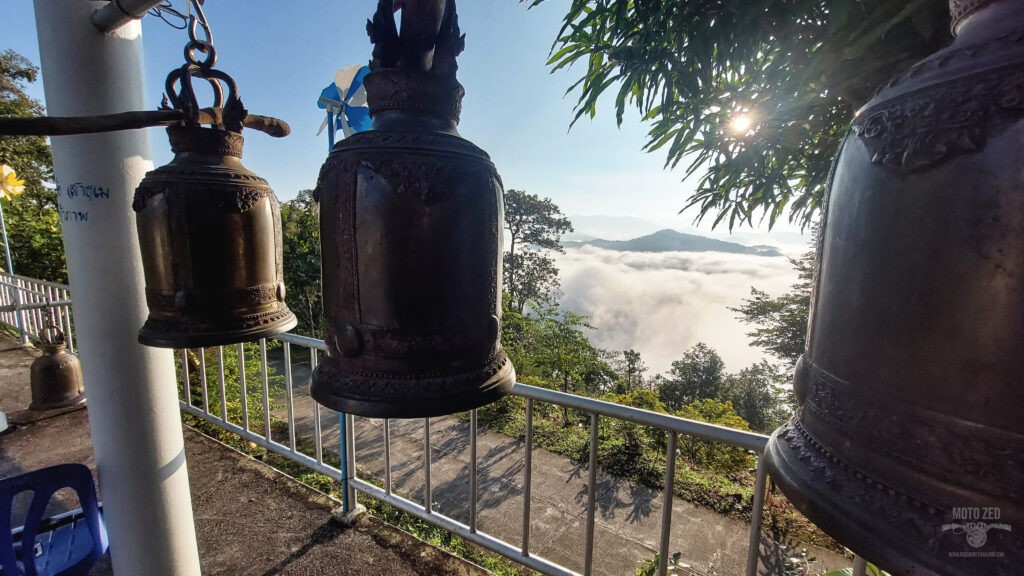
The temple is dedicated to Lord Buddha and holds a significant place for locals, who come to offer prayers and pay respects to the sacred relics housed in the temple.

Architectural Features:
Wat Phra That Doi Nok features a traditional Lanna-style design, with a chedi (stupa) at the centre, surrounded by smaller structures and shrines. The chedi, believed to house important Buddhist relics, is a focal point of the temple.
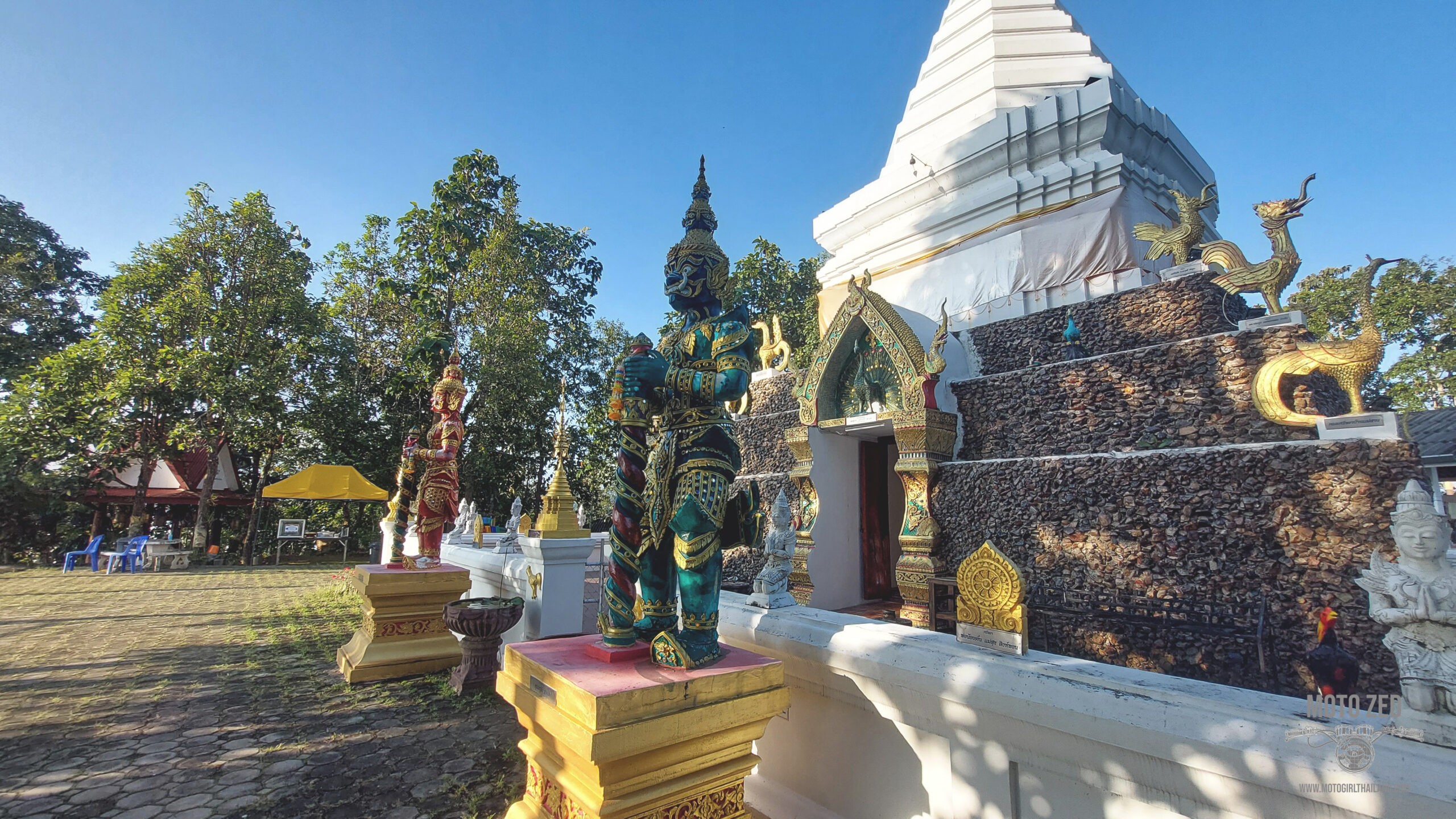
Additional Notes:
The drive/ride along the way to the temple takes you through lush forest surroundings and the natural beauty of the region. Once at the temple, you can explore the main chedi, smaller shrines, and surrounding natural areas. The peaceful ambience is perfect for meditation or contemplation.
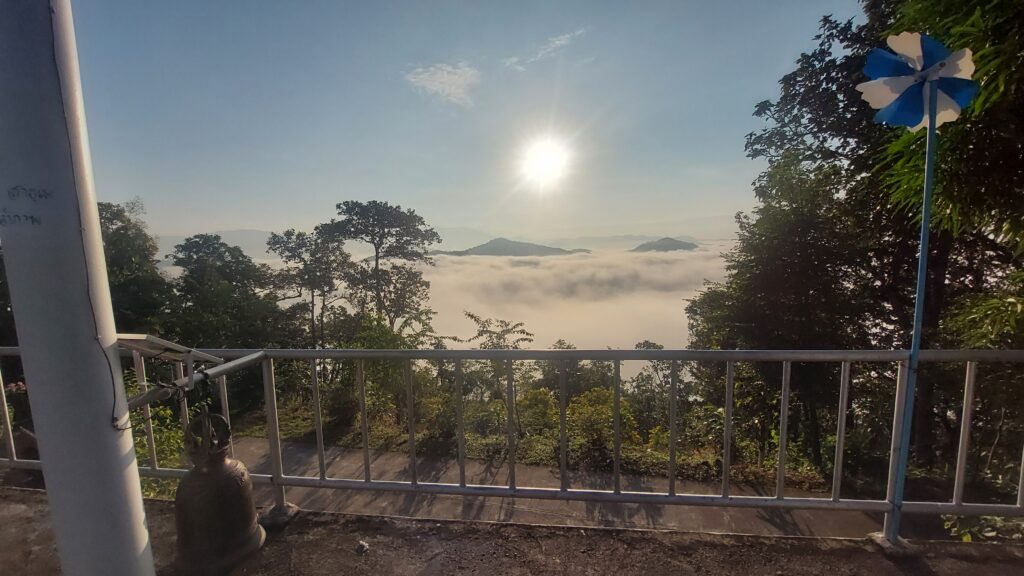
If you’re a nature lover and enjoy a more secluded, off-the-beaten-path experience, Wat Phra That Doi Nok provides an excellent opportunity to connect with both the natural world and the spiritual heritage of Chiang Mai.
2: Wat Phraphutthabat Si Roi
The sacred วัดพระพุทธบาทสี่รอย / Wat Phraphutthabat Si Roi in Mae Rim District is a revered pilgrimage site due to the four overlapping footprints of the Buddha, believed to be miraculously imprinted in stone.
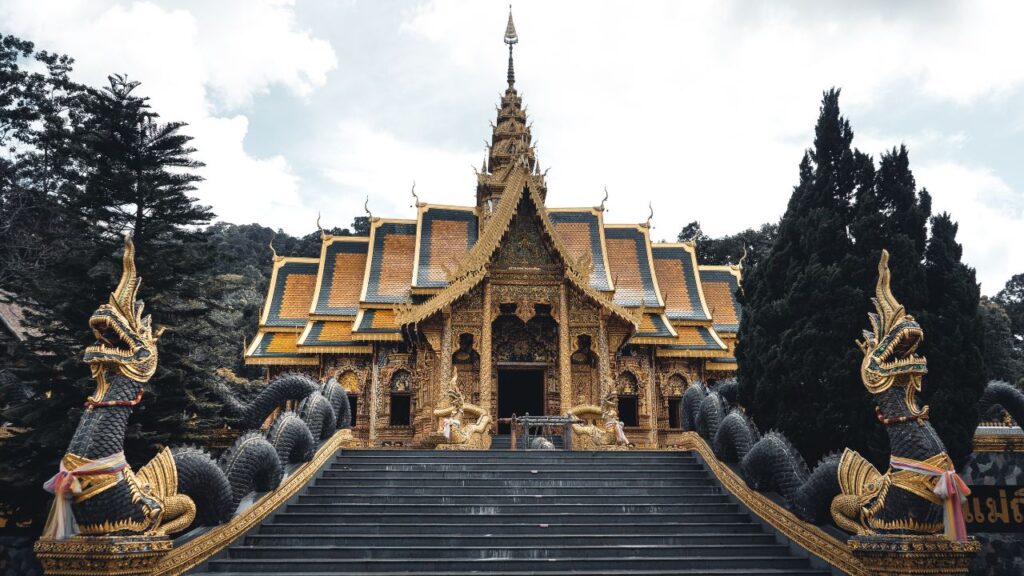
Details
- Location: 50 km from the City (map)
- Opening Hours: Daily, 6:00 AM – 6:00 PM
- Entry: Free (donations welcomed)
- Best Time to Visit: Early morning for a peaceful experience and cooler temperatures.
- Parking: Parking is available on the temple grounds.
- Food/Drinks: A cafe eatery is available on-site.
- Disabled Access: Yes
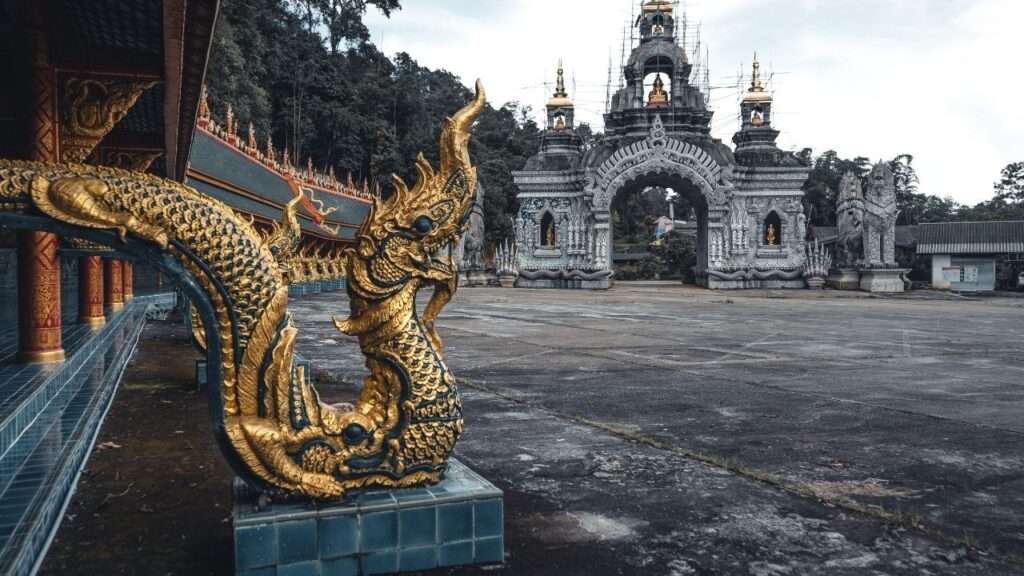
Historical and Cultural Aspects:
Wat Phraphutthabat Si Roi is steeped in spiritual lore and reverence, believed to have been established centuries ago as a sacred site marking the miraculous appearance of four Buddha footprints—stacked one atop the other—on a natural rock formation.
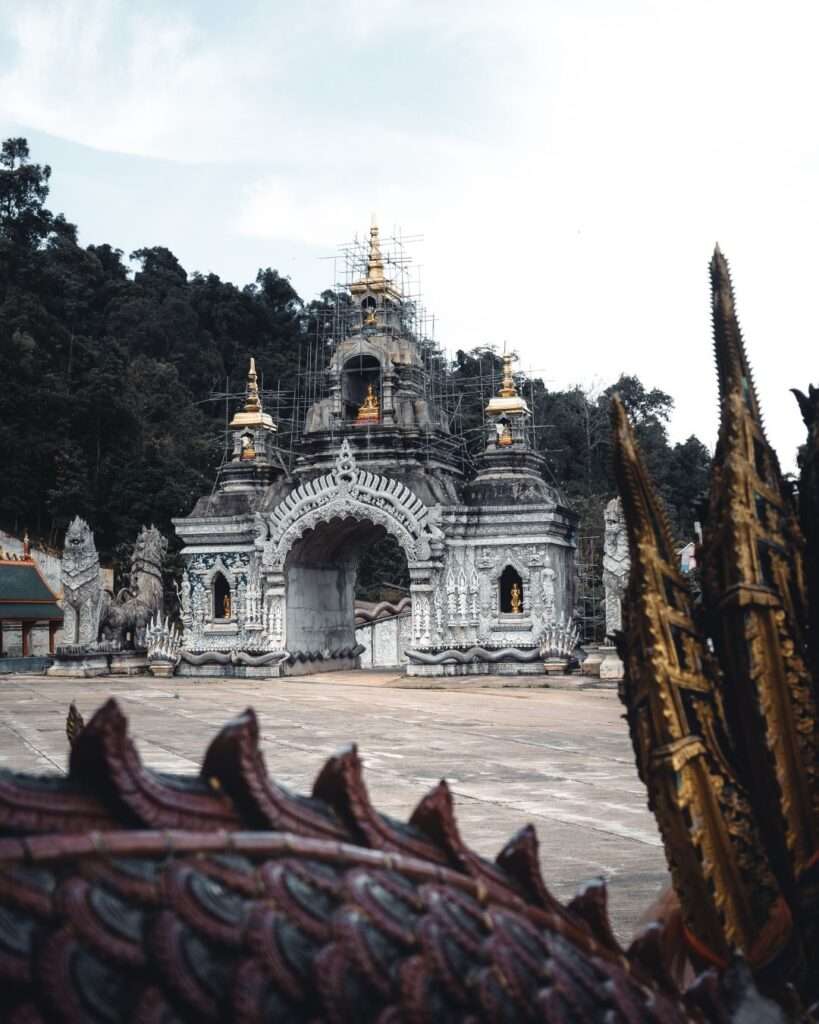
The temple’s name translates to “Temple of the Four Buddha Footprints,” and it holds deep significance for local Thai Buddhists, who journey here to make merit and pay respects. Enveloped in forested hills and serene silence, the temple’s mystical energy and spiritual importance have been preserved across generations, making it a powerful symbol of faith and tradition in the north.
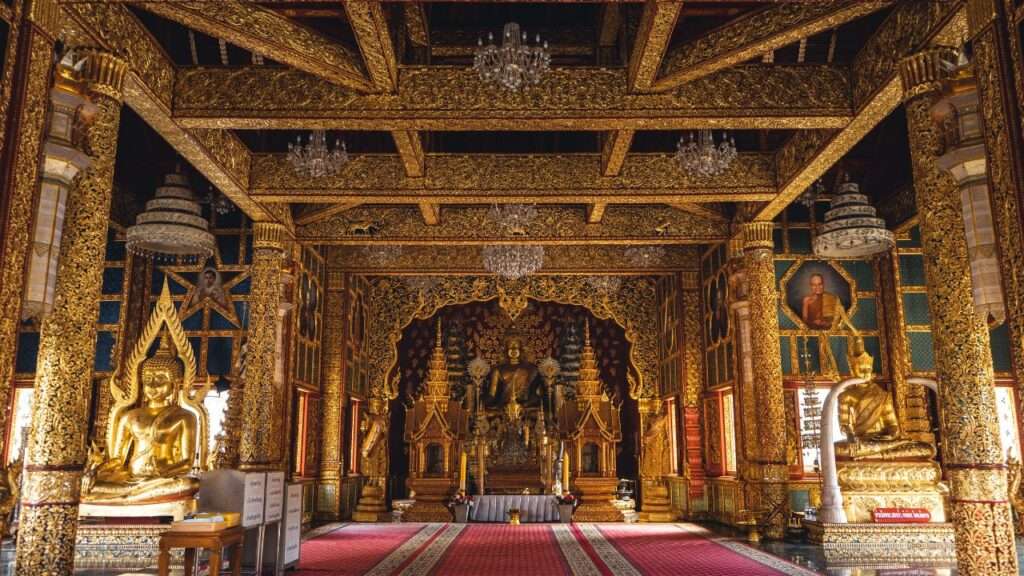
Architectural Features:
Wat Phraphutthabat Si Roi blends traditional Lanna architecture with natural surroundings, creating a serene and majestic atmosphere. The temple complex is built along the slope of a forested hillside, with intricately carved wooden pavilions, colourful murals, and ornate Naga staircases leading visitors upward to the sacred Buddha footprints.

At its heart lies a serene shrine housing the four superimposed footprints, sheltered under a beautifully decorated pavilion that highlights the temple’s spiritual and architectural grace.

Upon arrival, visitors are welcomed by a calm, spiritual atmosphere and the sound of rustling trees. Wander through the hillside temple grounds, take in the intricate Lanna architecture, enjoy a coffee or bite to eat in the cafe on-site, and follow the stairway to the revered Buddha footprints.
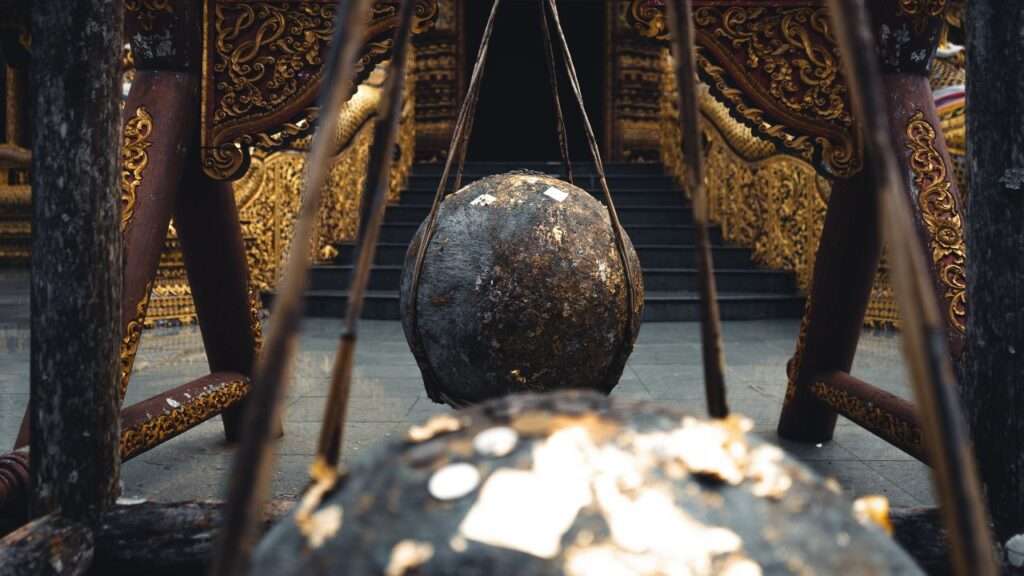
Additional Notes:
The scenic journey to Wat Phraphutthabat Si Roi is spectacular. The route winds through forested hills, quiet rural roads, and mountain landscapes.
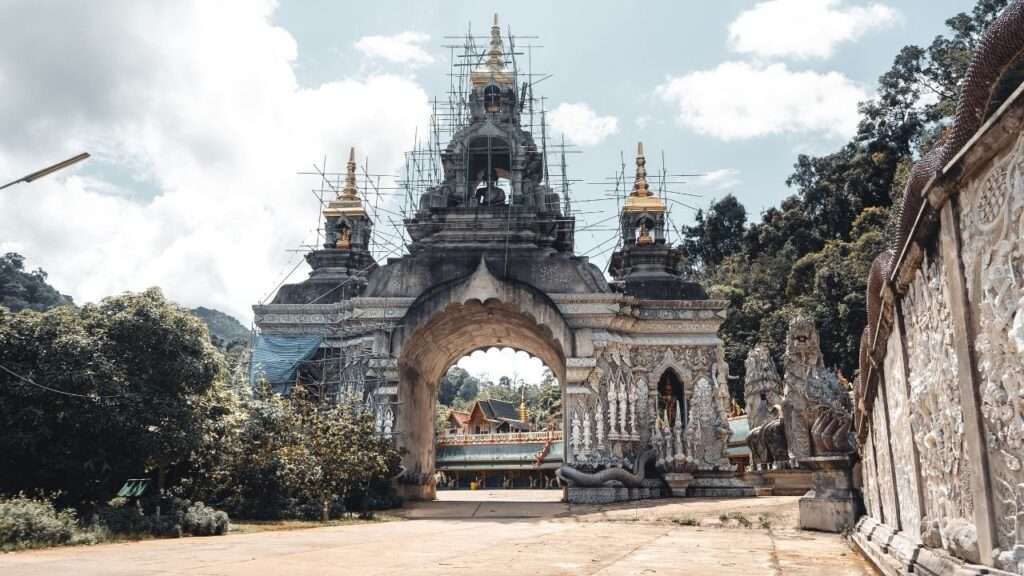
3: San Pa Gu Meditation Centre
ศูนย์ไกล่เกลี่ย สันป่ากุ / San Pa Gu Meditation Centre in Mae Rim District stands out for its harmonious blend of natural beauty and spiritual simplicity. Unlike more frequented temples, this peaceful retreat remains largely untouched by tourism, offering visitors a rare chance to experience authentic Thai meditation culture in a serene, undisturbed setting.

Details
Note: This meditation retreat has various sections. If you prefer not to walk up the steep stairway (and if you need a larger parking area), use this location. If you wish to see the beautiful stairway, the location is here.
- Location: 20 km from the City (Map)
- Opening Hours: Daily, 6:00 AM – 6:00 PM
- Entry: Free (donations welcomed)
- Best Time to Visit: Early morning for a peaceful experience and cooler temperatures.
- Parking: The parking area is at the top of the retreat (not at the base of the stairs). Stairway Location. / Main Entrance
- Food/Drinks: Noting on-site for visitors, but there are local eateries close by.
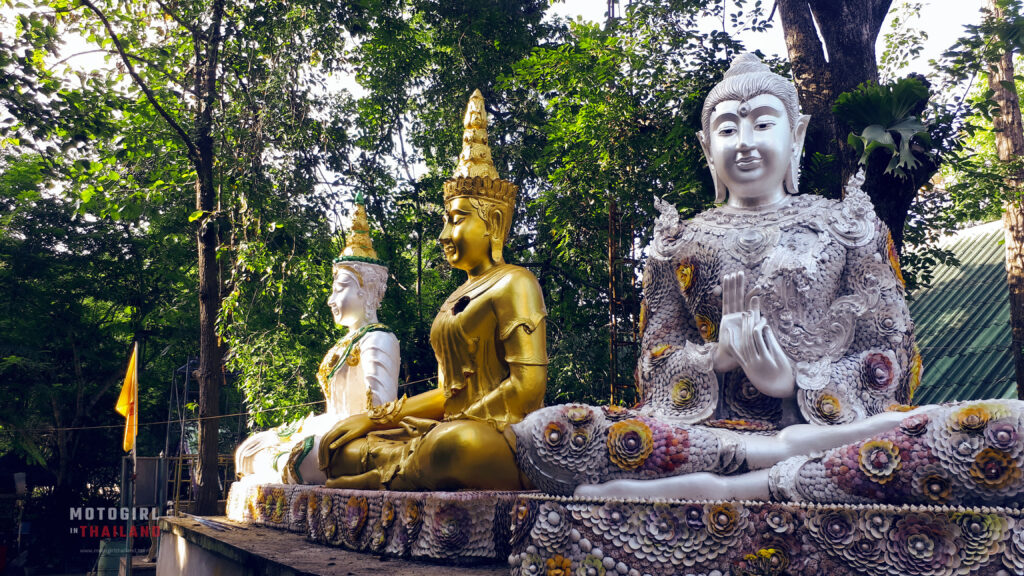
The serene San Pa Gu Meditation Centre is located in the tranquil outskirts of Chiang Mai city, offering a peaceful retreat for those seeking spiritual solace. It remains a lesser-known sanctuary for both locals and visitors and is ideal for quiet reflection and mindfulness practice.

Historical and Cultural Aspects:
San Pa Gu Meditation Centre is a practising meditation retreat, emphasising traditional Buddhist teachings and mindfulness practices. Surrounded by nature, the centre provides an environment conducive to meditation and introspection, preserving the spiritual heritage of the region.
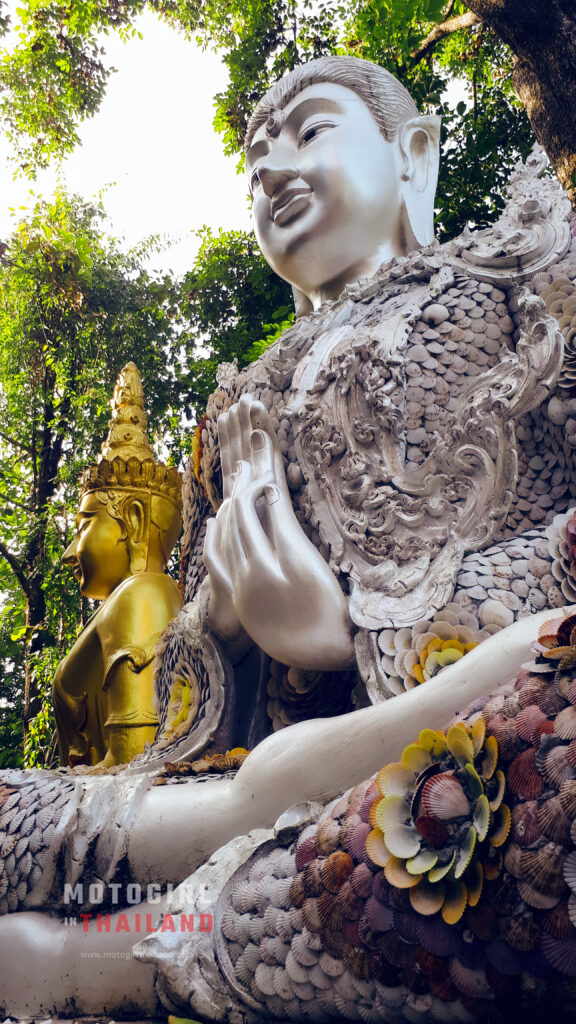
Architectural Features:
One of its most iconic elements is the long stairway lined with colourful Buddhist flags, leading upward toward the main meditation area. This symbolic ascent represents the path to spiritual elevation and mindfulness.

At the top of the stairs, you’ll find a simple meditation venue, built in a minimalist yet traditional northern Thai style. The open-air centre allows for fresh breezes and birdsong, creating a peaceful atmosphere for quiet reflection.

Scattered across the grounds are small thatched-roof pavilions, Buddhist statues, shaded seating areas, and peaceful garden nooks that offer ideal spots for walking meditation or silent contemplation. The entire complex is designed to foster stillness, spiritual discipline, and a deep connection with the natural world.
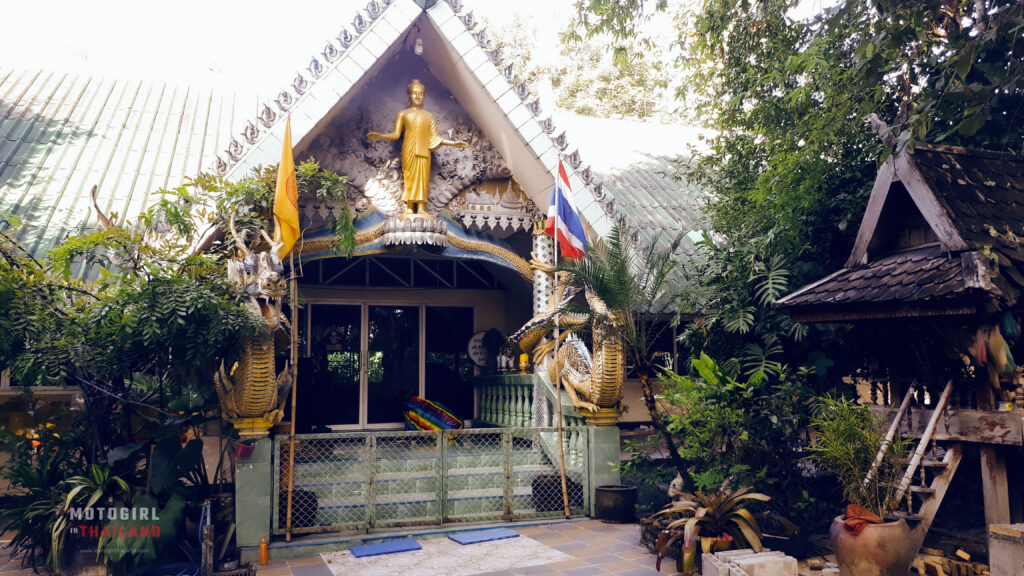
Architectural Notes:
The route to San Pa Gu eventually leads you through lush rice paddy fields lined with amazing cafes and eateries.
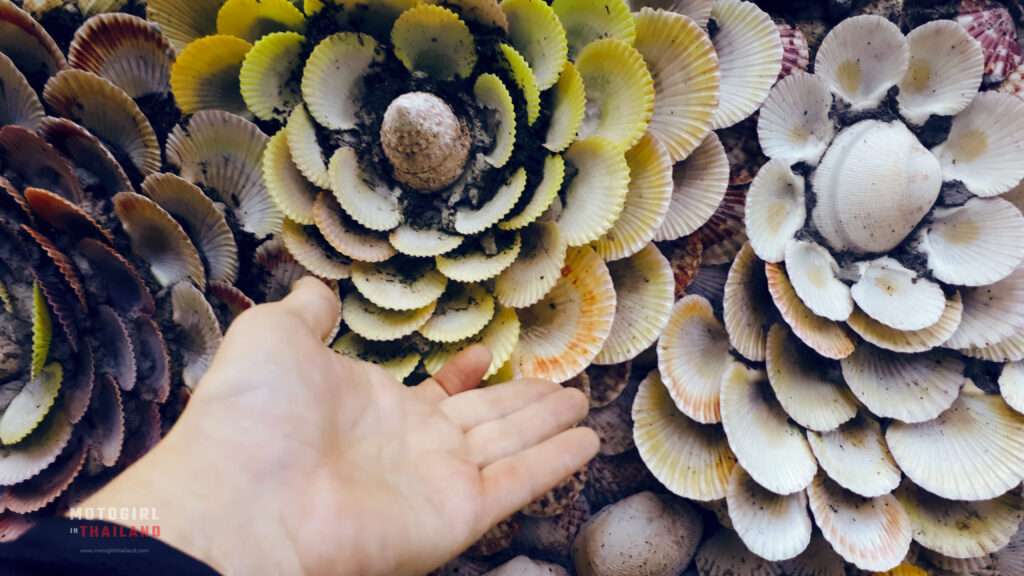
If you’re seeking a serene, off-the-beaten-path experience, San Pa Gu Meditation Centre offers a unique opportunity to connect with nature and the spiritual traditions of Chiang Mai.
4: Wat Doi Sapphanyu
วัดดอยสัพพัญญู / Wat Doi Sapphanyu in the Mae Wang areastands out for its harmonious integration of natural beauty and spiritual significance. Its off-the-beaten-path location ensures a tranquil atmosphere.
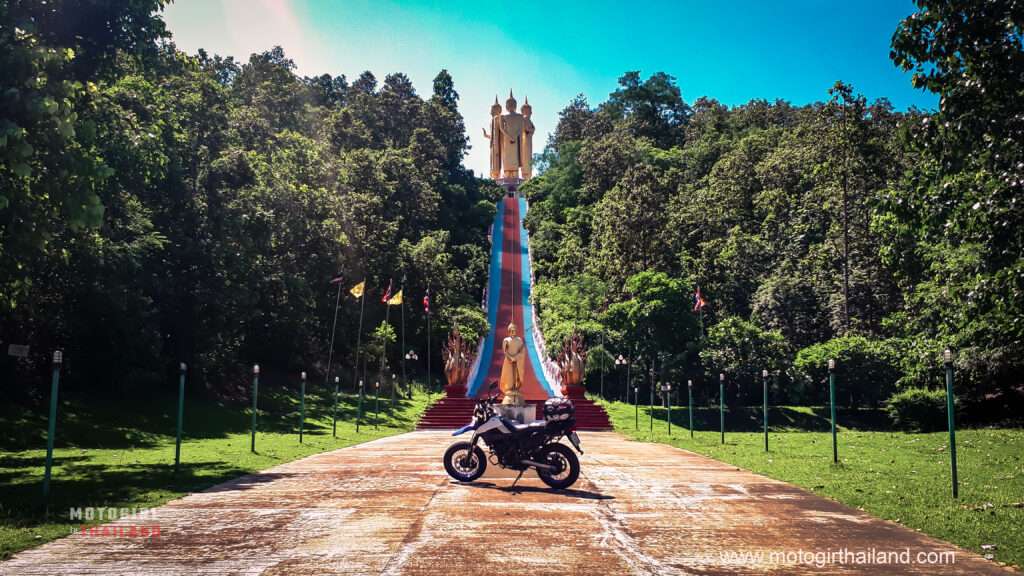
Details
- Location: 40 km from the City. (Map).
- Opening Hours: Daily, 6:00 AM – 6:00 PM
- Entry: Free (donations welcomed)
- Best Time to Visit: Early morning for a peaceful experience and cooler temperatures.
- Parking: Ample parking is available on the temple grounds near the stairs (and further up if you prefer not to walk up via the staircase).
- Food/Drinks: Nothing on site and limited facilities in this area; it’s advisable to bring water and snacks.
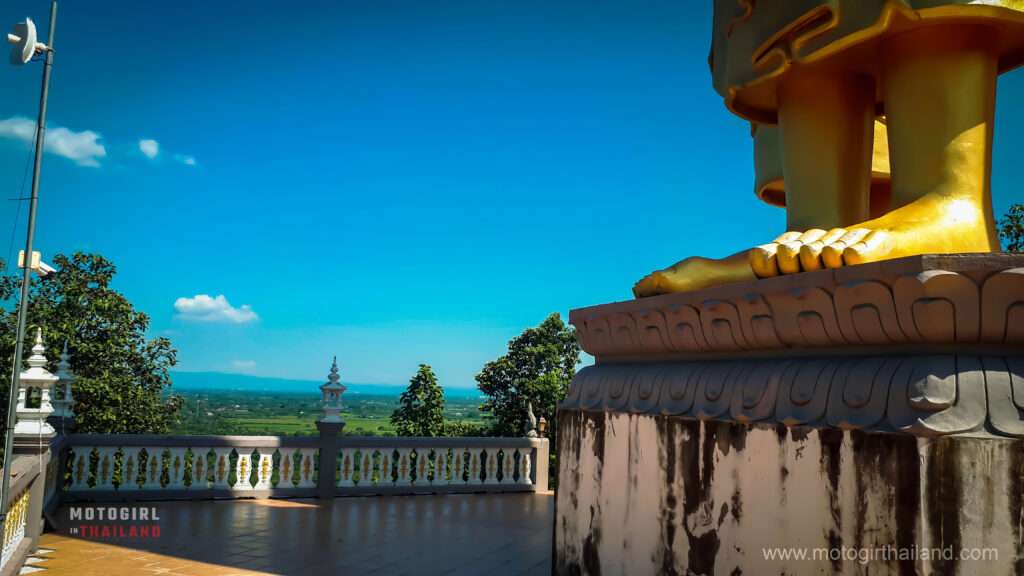
Wat Doi Sapphanyu, also known as Wat Nam Bo Tib, is tucked away in the lush hills of Mae Wang District, Chiang Mai. Perched atop a serene hill, this tranquil temple offers panoramic views of the landscape.
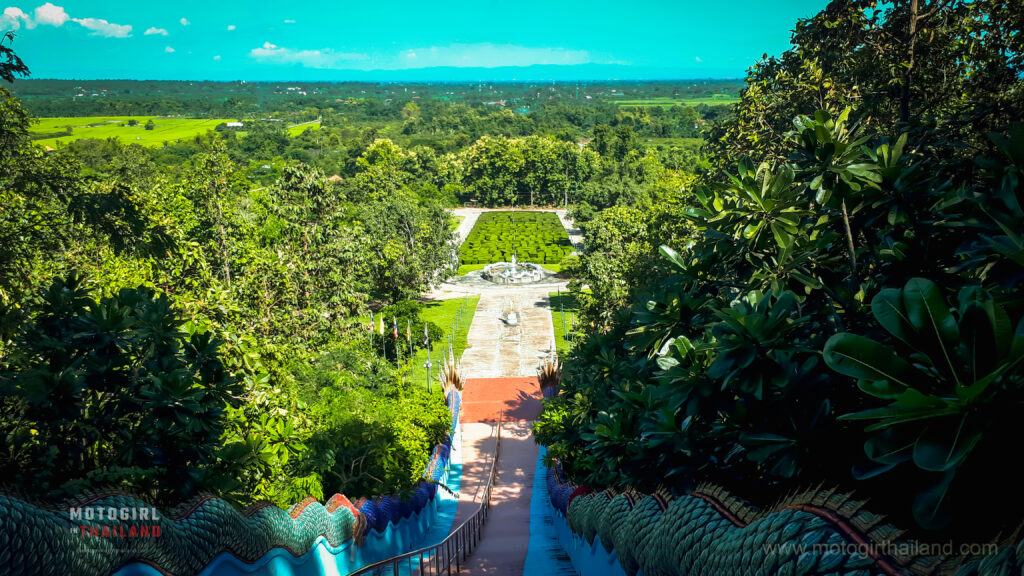
Historical and Cultural Aspects:
Originally established in the 14th century during the reign of King Kue Na of the Lanna Kingdom, the temple served as a significant religious and cultural centre. However, over time, it fell into disuse and was eventually left deserted.
In 1994, Wat Doi Sapphanyu was revitalised by Phra Ratcharat Rattanakorn, the former abbot of Wat Phra That Doi Suthep, along with dedicated supporters. This restoration transformed it into a vibrant spiritual centre, preserving its historical significance.
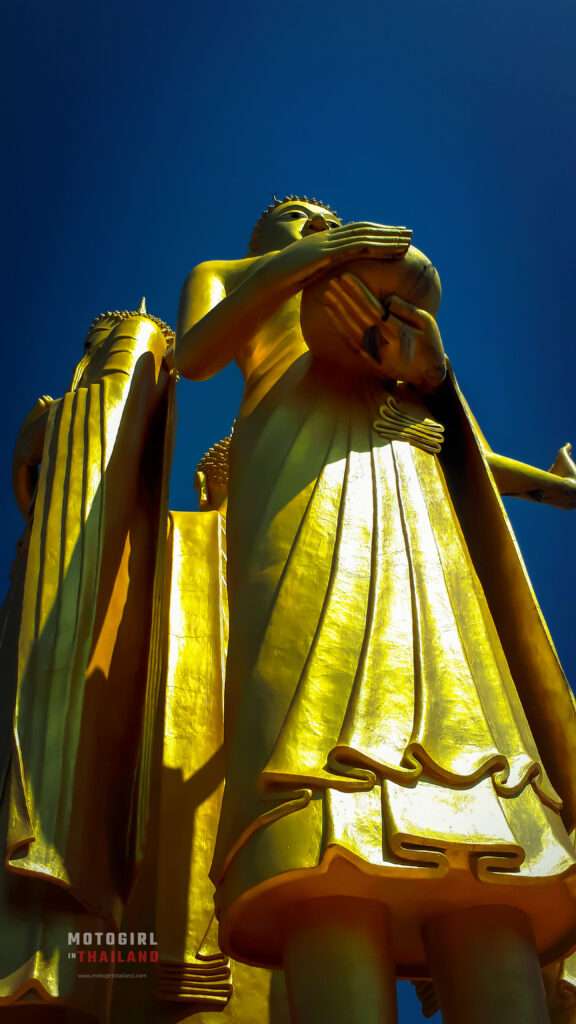
Architectural Features:
Wat Doi Sapphanyu showcases traditional Thai architectural elegance, highlighted by four giant standing Buddha statues, each facing a cardinal direction. These statues are not only remarkable for their size but also for the unique beehives nestled under their arms, adding a touch of natural wonder to the sacred site.
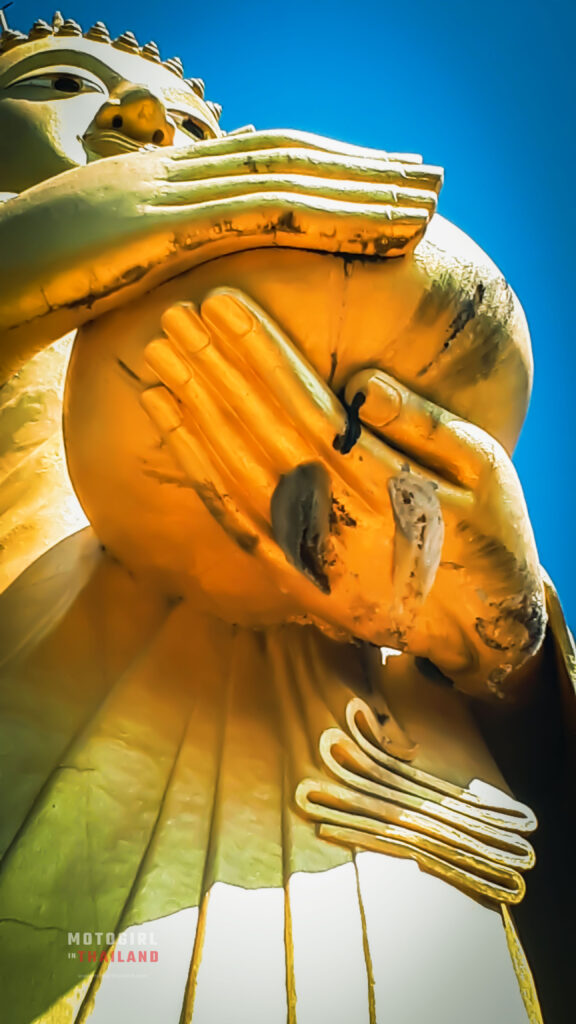
The three Buddhas together symbolise the continuity of the Buddhist teachings across time—past, present, and future. The three figures remind worshippers of the impermanence of the world and the enduring nature of enlightenment.
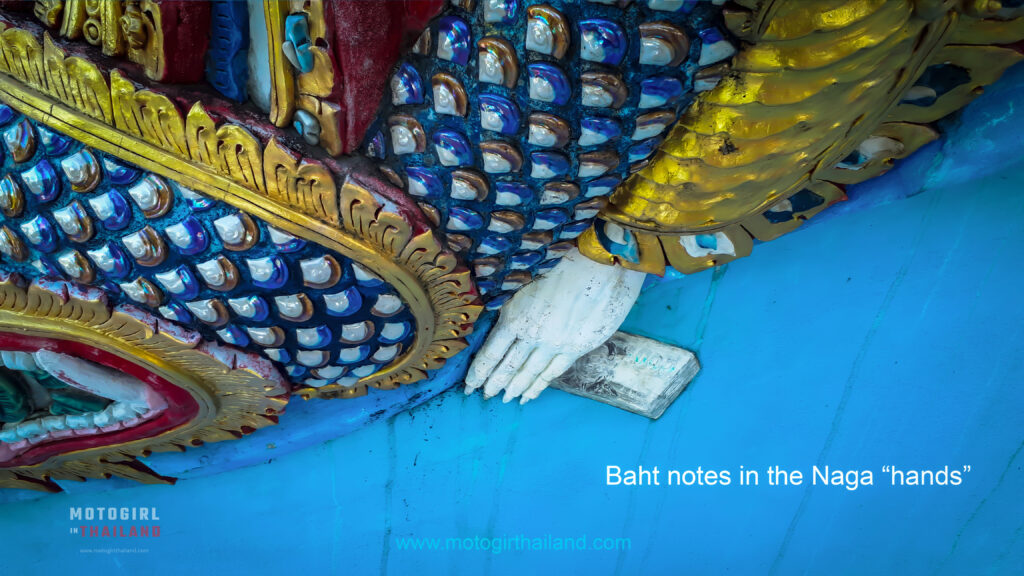
Additional Notes:
The journey to Wat Doi Sapphanyu takes you through scenic rural landscapes, culminating in a peaceful retreat away from the city’s hustle.
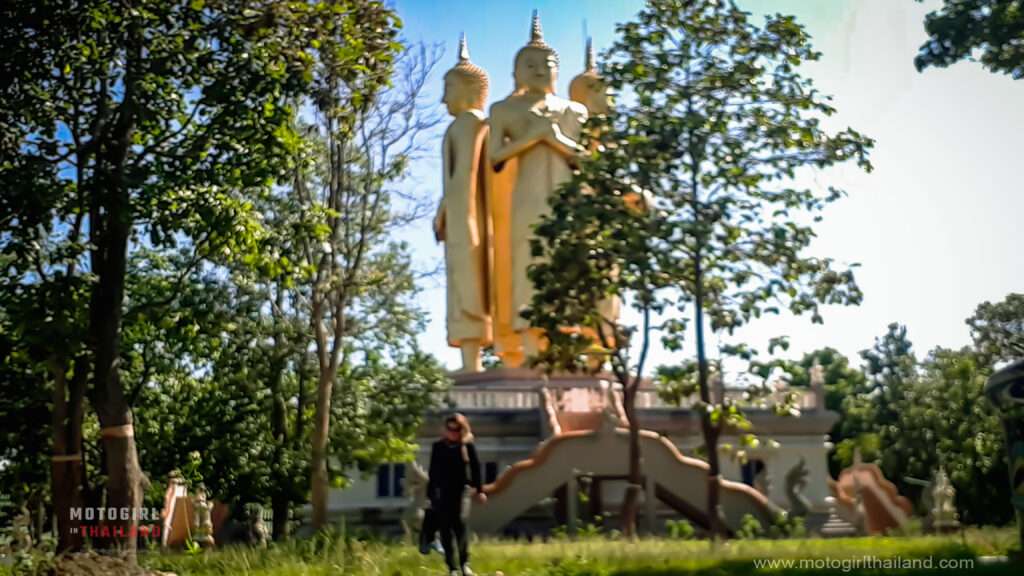
5: Wat Phra That Sri Somdet
สำนักวิปัสสนาพระธาตุศรีสมเด็จพระพุทธชินวงศ์ / Wat Phra That Sri Somdet, (also known as Phra Buddha Chinwong), in Mae Wang, houses one of the more unusual and unique Buddha statues in the region.
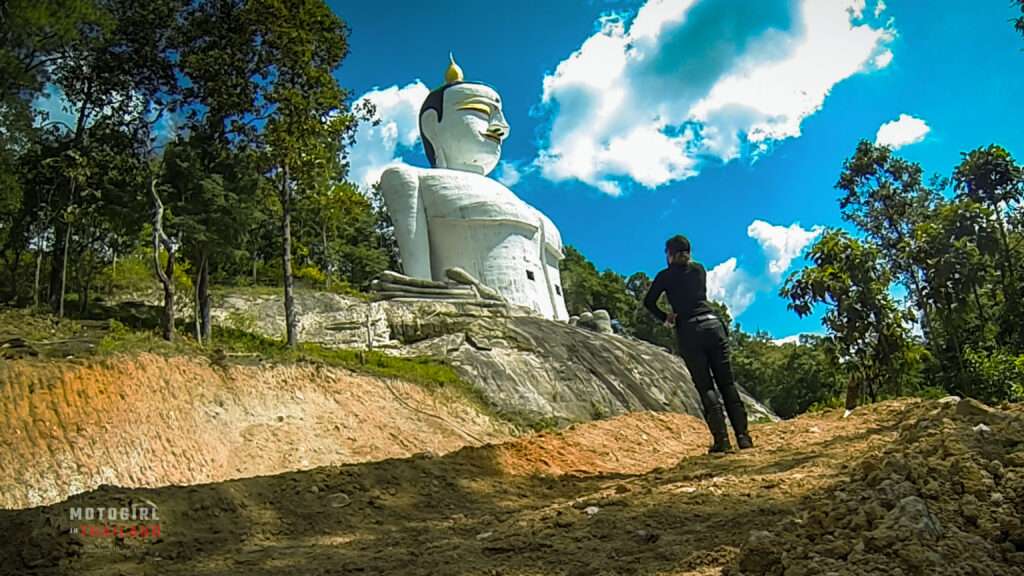
Details
- Location: 70 km from the City. (Map)
- Opening Hours: Daily, 6:00 AM – 6:00 PM
- Entry: Free (donations welcomed)
- Best Time to Visit: Early morning or late afternoon for cooler temperatures and a peaceful experience.
- Parking: available opposite the temple stairwell.
- Food/Drinks: Limited facilities; it’s advisable to bring water and snacks.

The awe-inspiring Wat Phra That Sri Somdet Phra Buddha Chinwong is a remarkable meditation centre located in the serene hills of Mae Wang District. Dominating the landscape is a colossal white Buddha statue, visible from afar, symbolising peace and enlightenment.

I first spotted this Buddha statue from a distance when out exploring on my motorbike, but had no idea it would turn out to be so huge!

What makes this Buddha even more interesting is that you can walk inside the statue. The interior is adorned with murals and sacred imagery, and often a resident artist is painting or restoring religious art, as this is an ongoing process. The murals depict interesting scenes from the Buddha’s life, and also, some fun superhero and Marvel characters mixed in, to entertain younger visitors

Historical and Cultural Aspects:
Established in 2012, Wat Phra That Sri Somdet Phra Buddha Chinwong serves as a centre for Vipassana meditation, attracting practitioners seeking inner peace and mindfulness. The temple’s name reflects its dedication to the revered Buddha Chinwong, and it has become a significant spiritual site for both locals and visitors. The ongoing development of the temple complex showcases the community’s commitment to preserving and promoting Buddhist teachings.
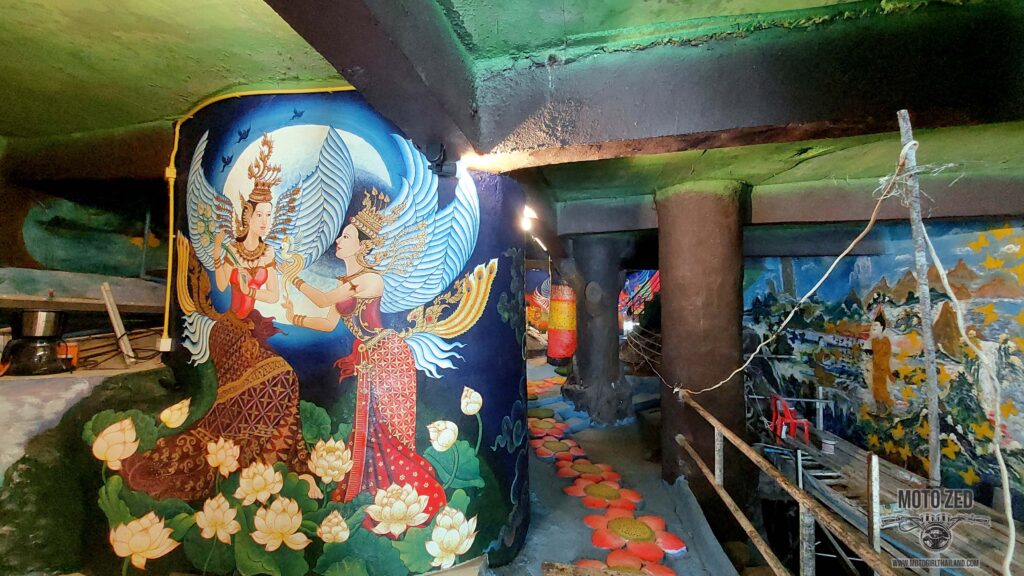
Architectural Features:
The temple’s most striking feature is the giant white Buddha statue.. The statue’s immense size and pristine whiteness make it a captivating sight against the backdrop of greenery.

Additional Notes:
The back route to Wat Phra That Sri Somdet Phra Buddha Chinwong takes you through picturesque rural landscapes via a thrilling twisty route. Upon arrival, visitors are greeted by the temple’s serene ambience, the gentle sounds of nature, and breathtaking panoramic views. There are several steep and sometimes slippery steps to the temple, so best to wear grippy shoes and bring water.

The presence of the towering white Buddha statue, coupled with its off-the-beaten-path location, ensures a tranquil atmosphere, allowing visitors to immerse themselves fully in the temple’s serene environment.
– Facebook page for this amazing temple illustrates the ongoing work for producing this incredible statue.
6: Wat Sukhavati
วัดสุขาวดี / Wat Sukhavati (also known as Cực Lạc Cảnh Giới Tự) is a Vietnamese Mahayana Buddhist temple hidden away in the hills of Samoeng District, Chiang Mai. Founded in 2005 by Vietnamese monk Thích Hạnh Nguyện, the temple was created as a spiritual retreat and meditation centre for practitioners of Pure Land Buddhism. I’m particularly fond of this truly hidden gem, having “discovered” it some years ago while out exploring this area on my bike. It was an incredible find — at the time, the temple was in some disrepair, but I’m happy to say it has since experienced a beautiful revival. (In fact, I’m proud to say I put this stunning sanctuary “on the map,” so to speak, in terms of outside visitors.)
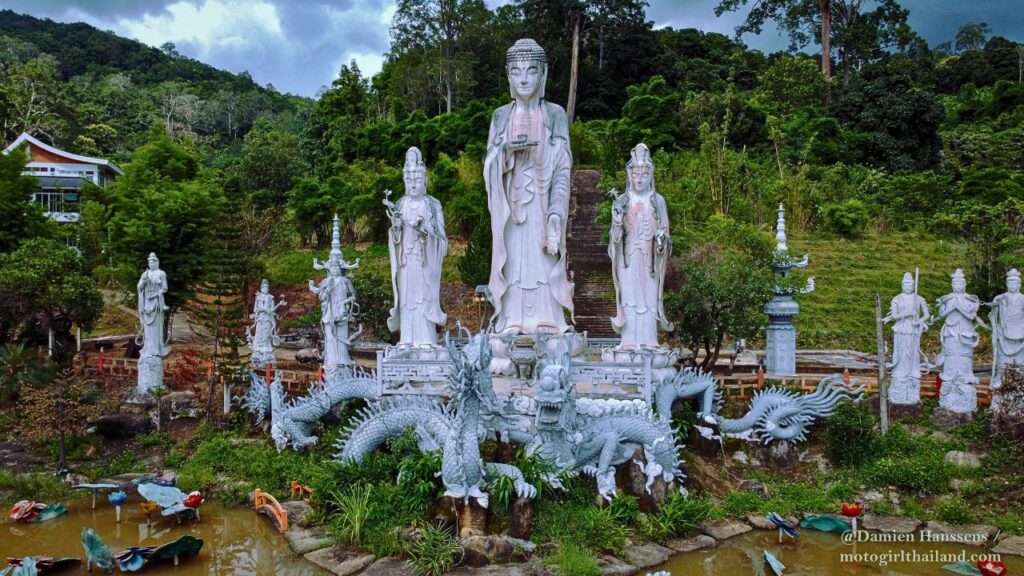
Details
- Location: 60 km from the City. (Map)
- Opening Hours: Daily, 6:00 AM – 6:00 PM
- Entry: Free (donations welcomed)
- Best Time to Visit: Early morning or late afternoon for cooler temperatures and a peaceful experience.
- Parking: available opposite the temple stairwell.
- Food/Drinks: Nothing within the grounds and limited facilities nearby; it’s advisable to bring water and snacks. There are, however, great eateries further out.
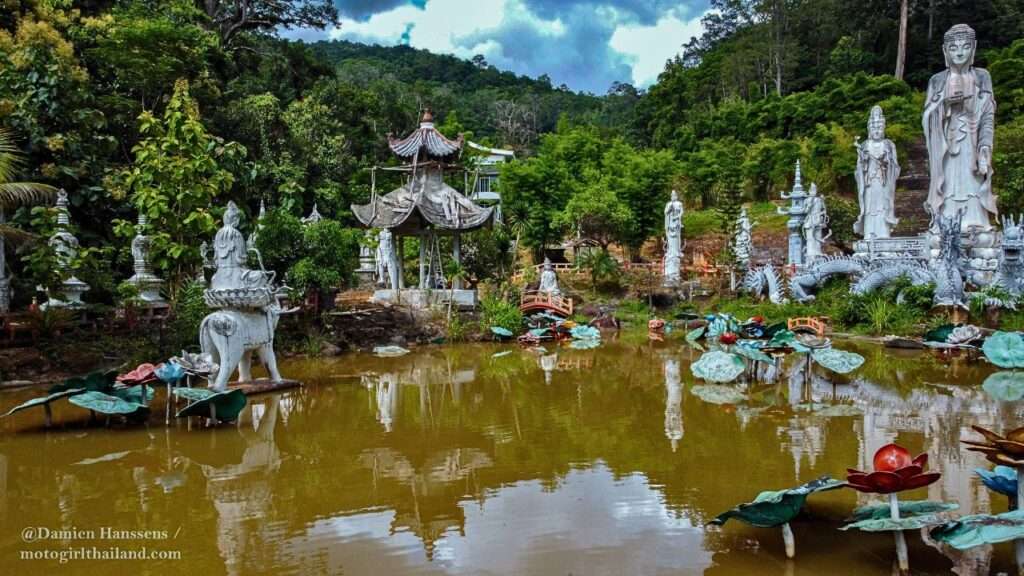
When you enter the temple grounds, it is like entering Narnia. From the outside, you could not imagine that the unassuming lane could lead to this 7-hectare sanctuary.
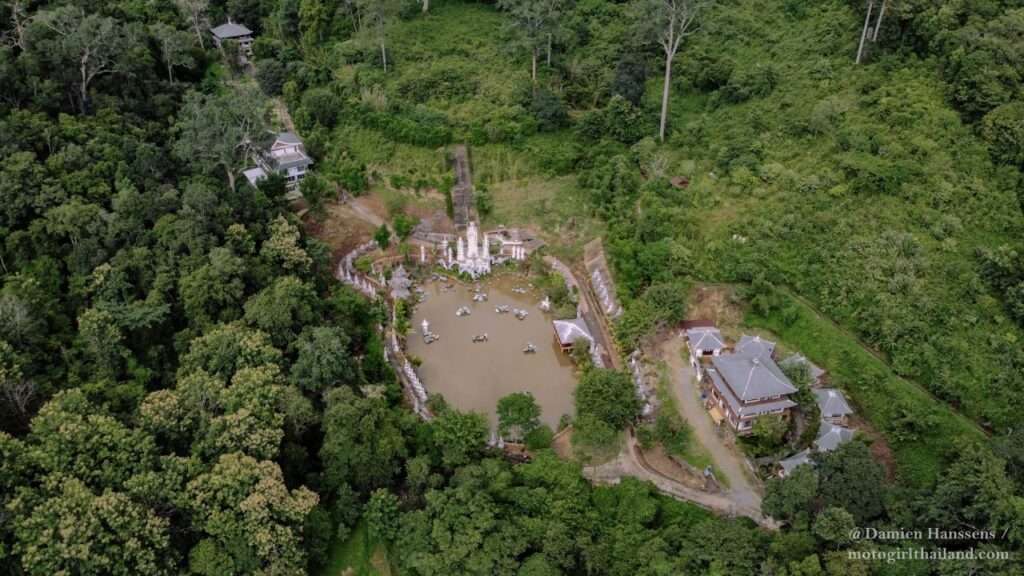
Historical and Cultural Aspects:
Wat Sukhavati was founded as a sanctuary for both monastic and lay practitioners following the teachings of Amitabha Buddha (Phật A Di Đà). Its name, “Sukhavati,” refers to the Western Pure Land in Mahayana belief — a peaceful realm where enlightened beings guide devotees toward liberation.
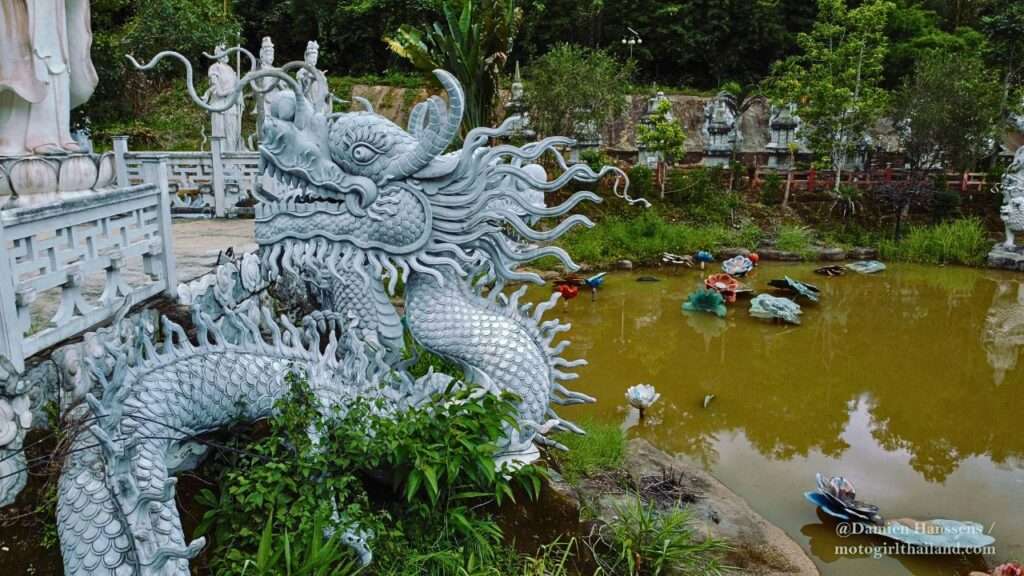
Architectural Features:
Wat Sukhavati’s striking Vietnamese Mahayana Buddhist architecture is designed to harmonise spiritual elements with the natural mountain landscape.
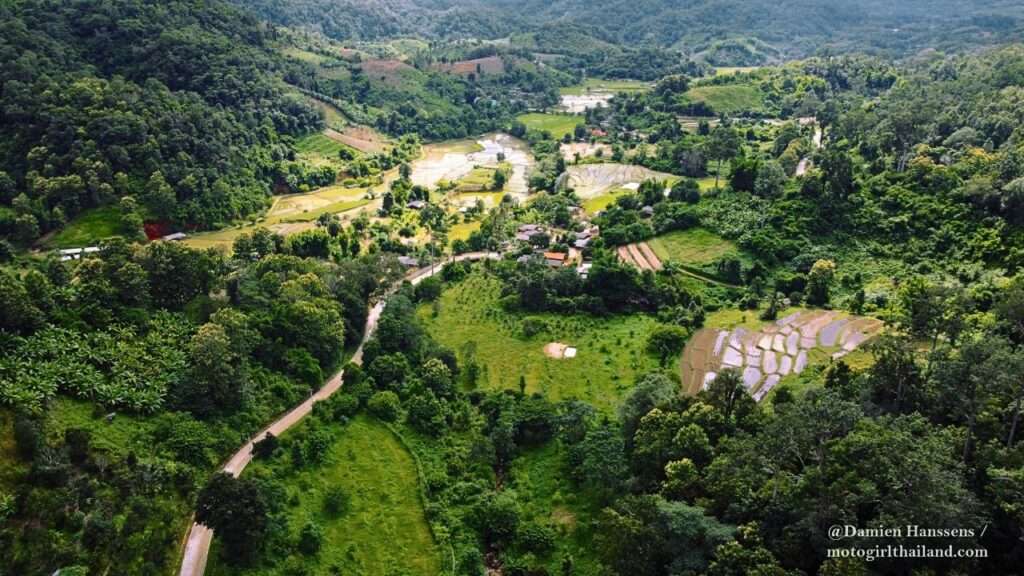
One of its most captivating features is the large symbolic lotus pond representing purity, spiritual awakening.
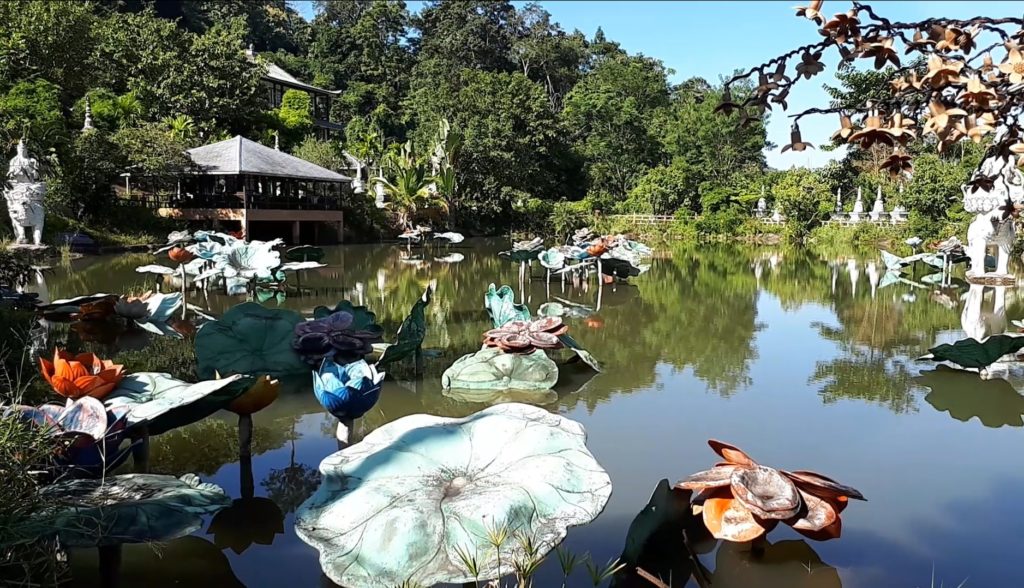
At night, the pond is illuminated with soft solar lighting.
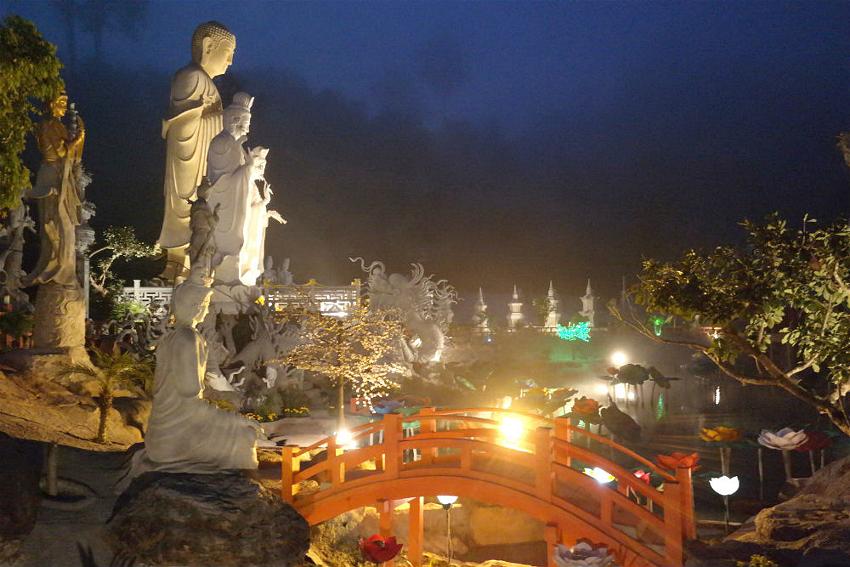
Towering white statues surrounding the pond illustrate the Buddha’s journey to enlightenment, while soft background recordings of sacred chants and stories add depth and atmosphere to the experience.
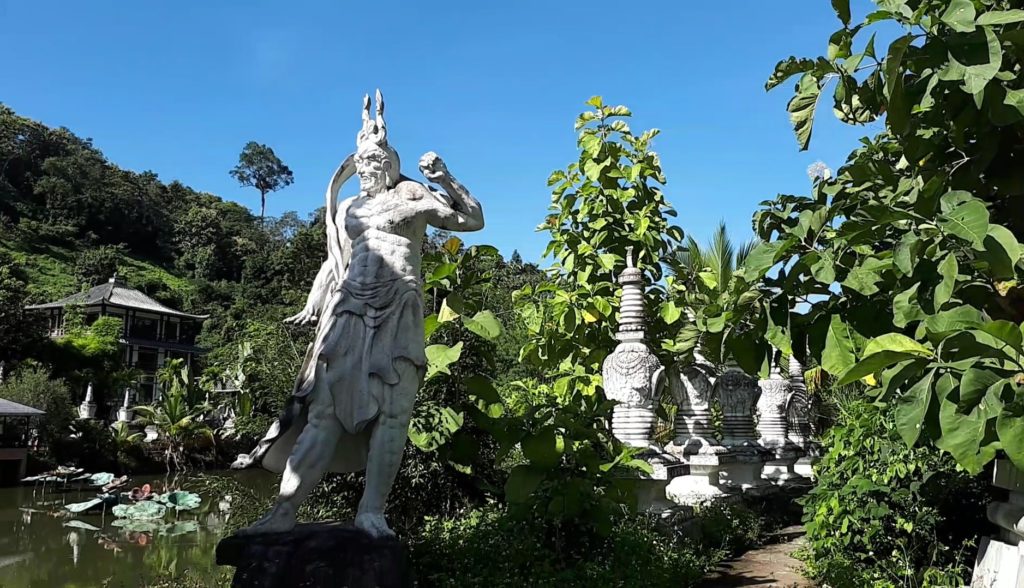
The temple also includes dedicated accommodation areas and a spacious meditation hall. While visitors are welcome, it’s important to ask permission before entering the hall.
Additional Notes:
The entranceway is hard to spot. You may think the GPS location is wrong. Look for the white sign and follow the narrow path to the temple gates. Once inside, you may encounter monks or volunteers engaged in daily activities, and it’s not uncommon to witness chanting or mindfulness practices taking place. Keep in mind that they may not wish to engage with visitors.
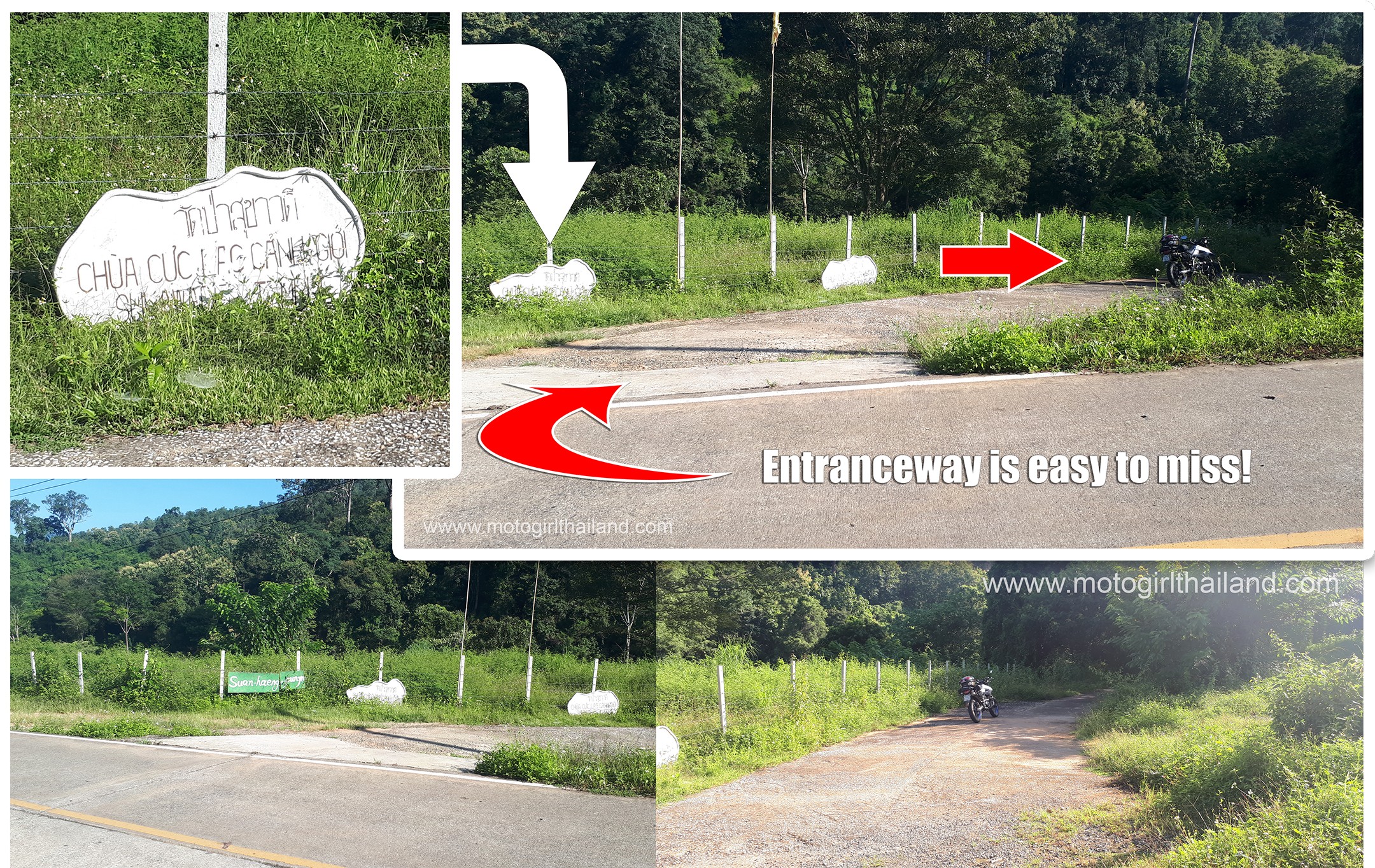
Note that on special observance days, the main gates may be temporarily closed. If so, you will need to return to visit at another time. Thankfully, the ride/drive to the temple is enjoyable, and there are other places you can visit in the general area.
7: Wat Ban Pong
Perched atop a forested hill along the scenic Samoeng 1269 Road, “วัดบ้านปง” Wat Ban Pong is a serene temple complex, renowned for its striking White Pagoda — a gleaming structure that stands out beautifully against the lush green backdrop of the surrounding hills.
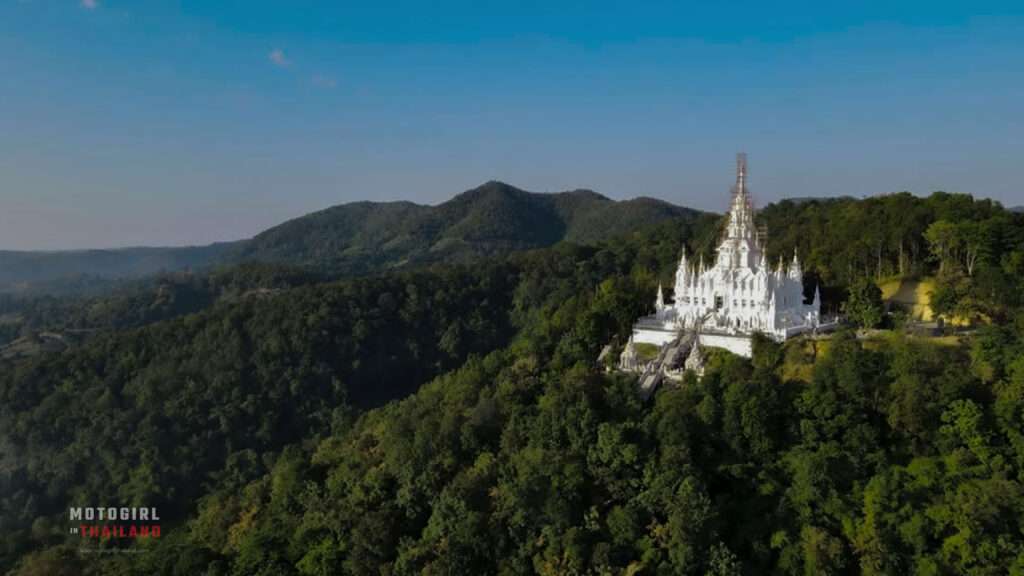
Details
- Location: 20 km from the City. (Map)
- Opening Hours: Daily, 8:00 AM – 6:00 PM
- Entry: Free (donations welcomed)
- Best Time to Visit: Early morning or late afternoon for cooler temperatures and softer lighting.
- Parking: Available at the base of the temple; limited parking near the summit.
- Food/Drinks: There may be vendors on-site, however, it is advisable to bring water and snacks
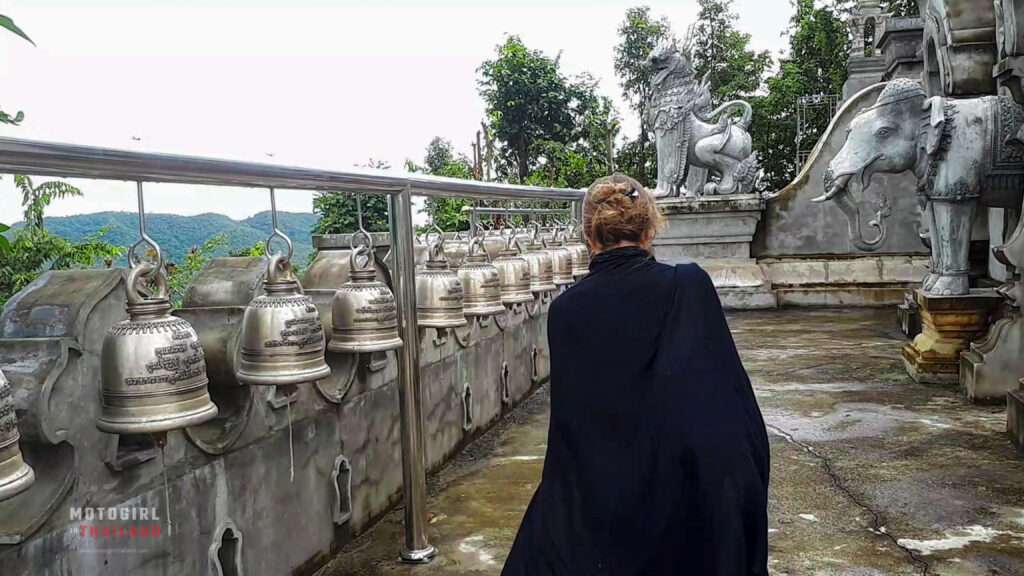
The gleaming white and gold temple was constructed over 15 years. It enshrines an ancient stupa and features a three-tiered design with 120 spires, symbolising core Buddhist principles. The structure’s design incorporates elements representing the Four Noble Truths and the Triple Gem (Buddha, Dhamma, Sangha).
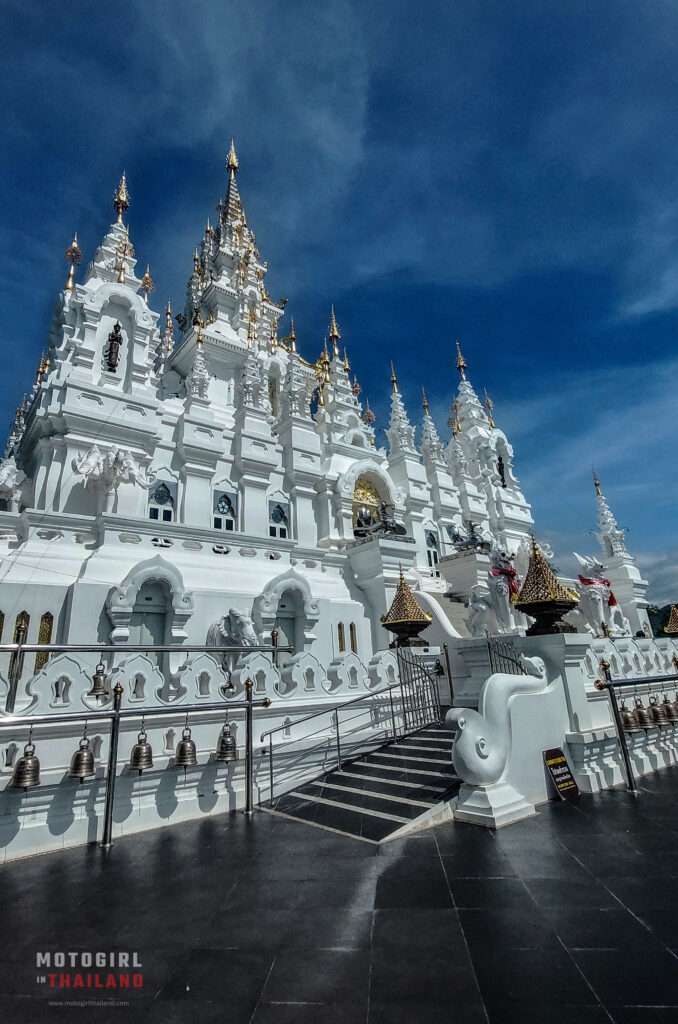
Visitors can reach the site by ascending a serene 900-step staircase or driving up a winding road, both offering panoramic views of the surrounding landscape. (You can also park at the base temple and use one of the red songtaew trucks to take you up to the summit.)
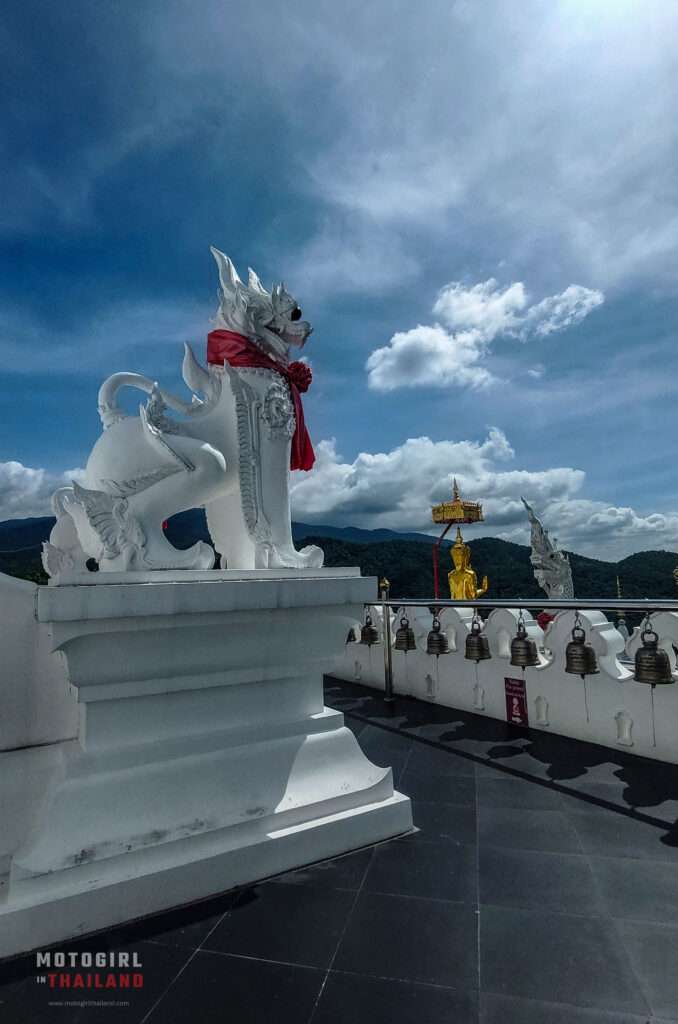
Historical and Cultural Aspects:
Wat Ban Pong has been a spiritual site for the local community for many years. The temple complex includes traditional Northern Thai architectural elements and serves as a centre for meditation and religious activities.
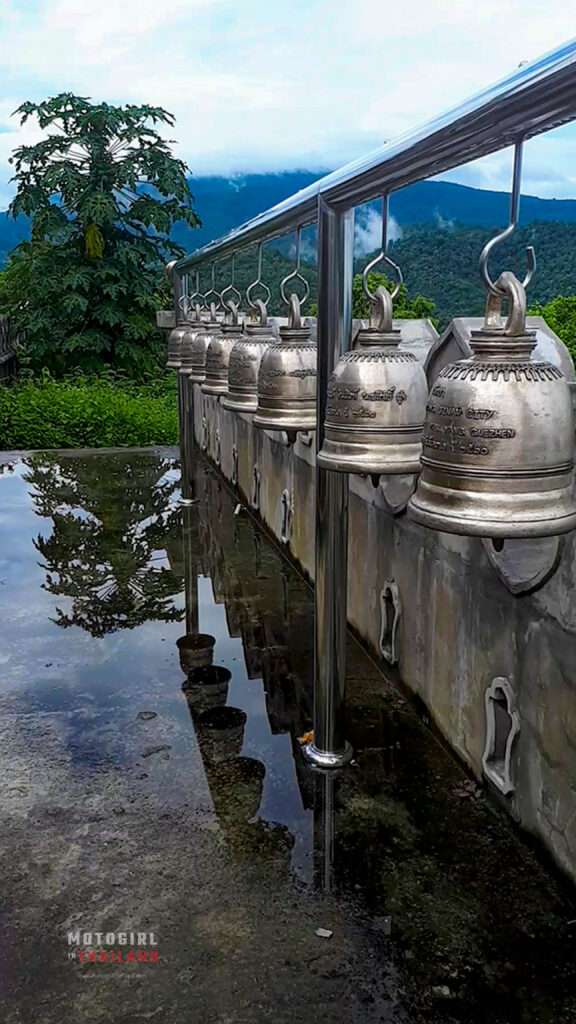
The White Pagoda, visible from afar, symbolises purity and enlightenment, aligning with Buddhist teachings. The temple grounds are well-maintained by resident monks and volunteers, reflecting the community’s dedication to preserving this sacred space.
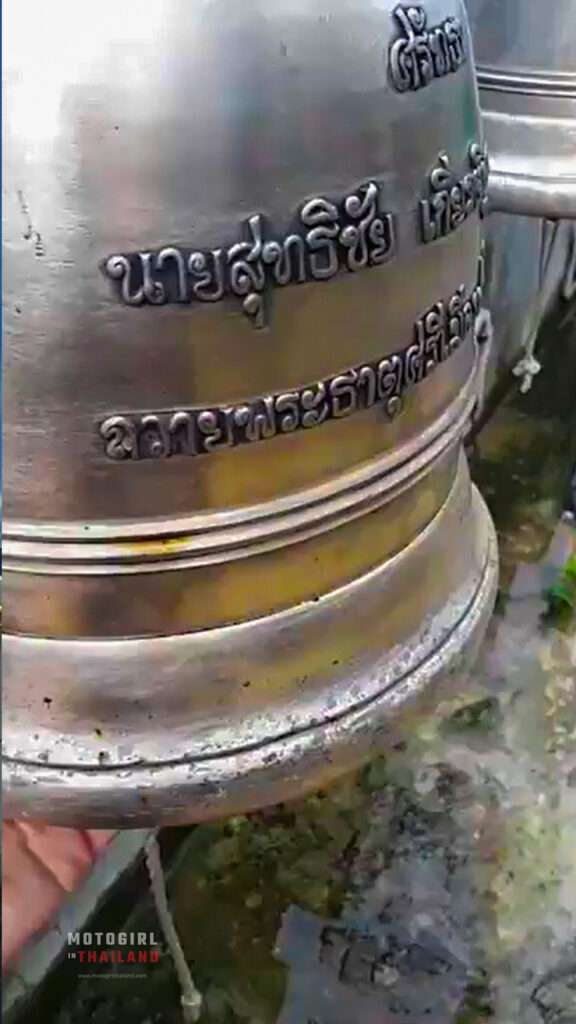
Architectural Features:
The White Pagoda is the centrepiece of Wat Ban Pong. Its pristine white exterior contrasts beautifully with the surrounding greenery, creating a picturesque scene. The pagoda’s design incorporates traditional Thai elements, and its elevated position offers visitors sweeping views of the valley below.
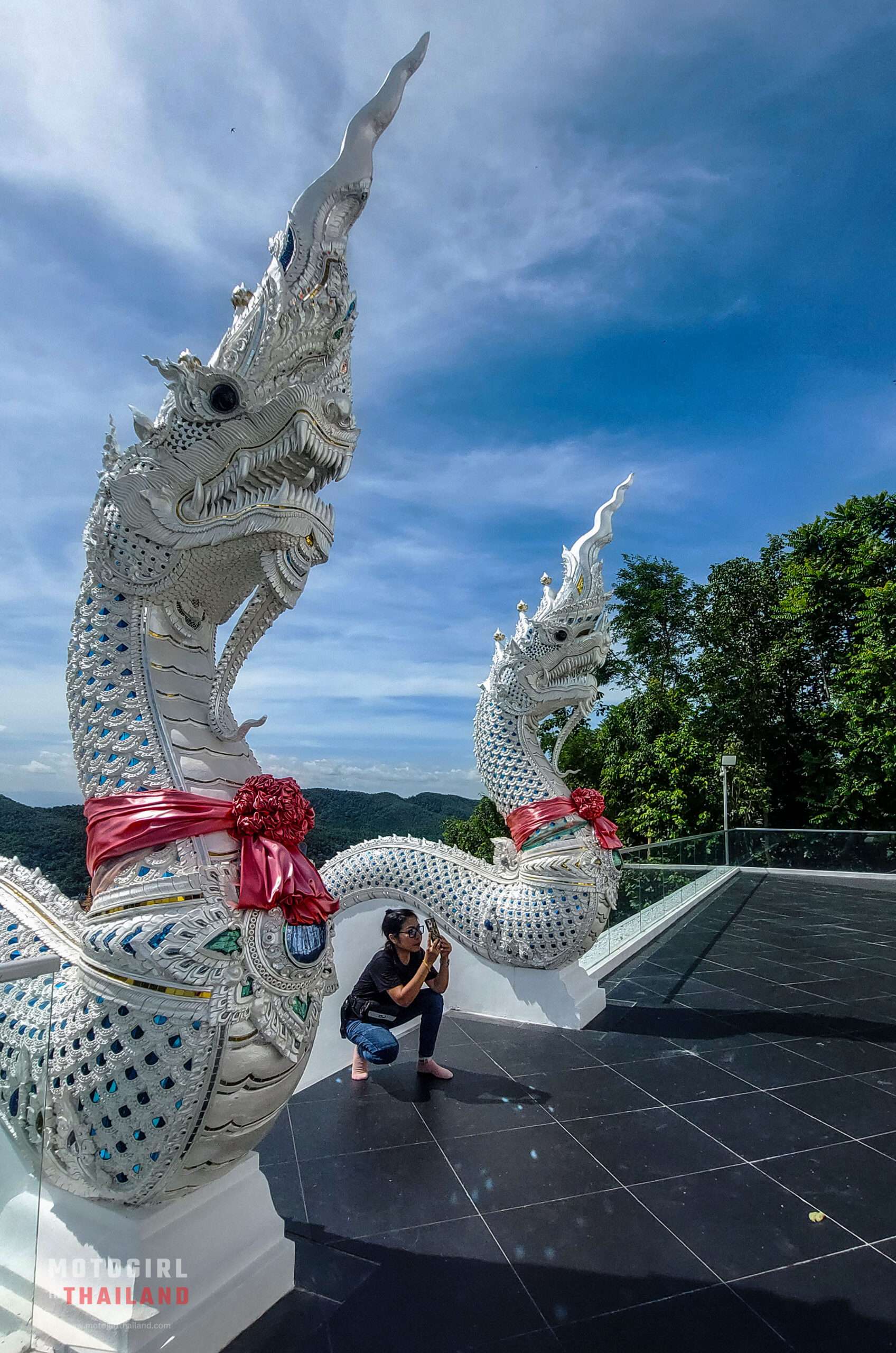

Additional Notes:
It’s common to see monks engaged in daily routines, and visitors are encouraged to observe respectfully. On certain religious observance days, access to specific areas may be restricted.
8: Wat Luang Khun Win
Nestled deep within the lush forests of Mae Wang District, Chiang Mai, is the ancient teak temple of “วัดหลวงขุนวิน” – Wat Luang Khun Win. Believed to be over 700 years old, it is renowned for its exquisite Lanna-style wooden architecture and harmonious integration with the surrounding natural landscape.

Note: This temple involves riding on dirt. If you are not confident or comfortable on dirt, you can hire a driver to take you there or join a tour group.
Details
- Location: 60 km from the City. (Map)
- Opening Hours: Daily, 6:00 AM – 6:00 PM
- Entry: Free (donations welcomed)
- Best Time to Visit: Dry season (November to February) for easier access and cooler temperatures.
- Parking: Available outside the temple grounds.
- Food/Drinks: It is advisable to bring your own.
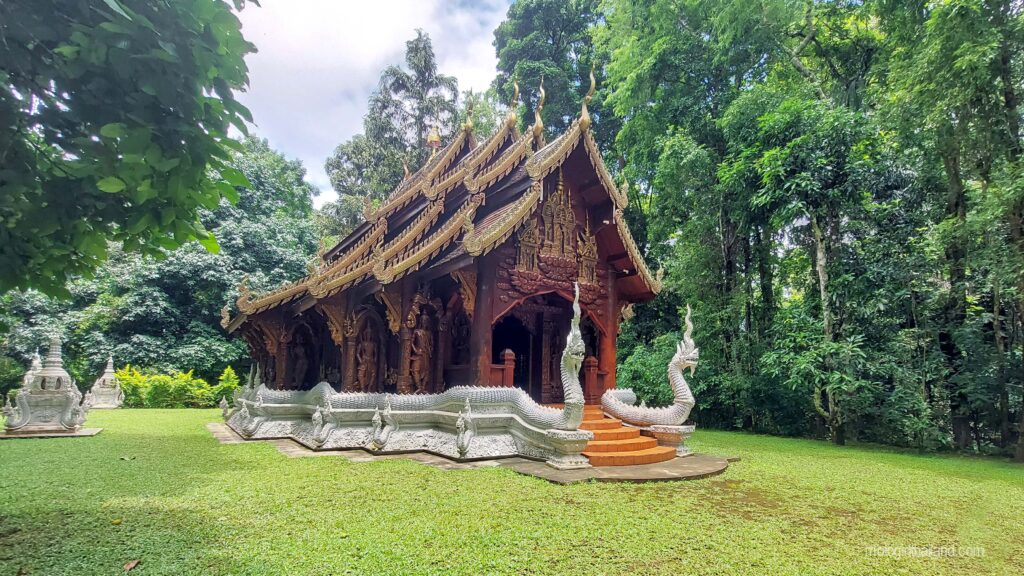
The secluded Wat Luang Khun Win houses the world’s largest wooden Buddha statue, carved from a wild champee tree. The site also features a reclining Buddha and a pagoda enshrining sacred relics.

Historical and Cultural Aspects:
Established over seven centuries ago, Wat Luang Khn Win has served as a place of worship and meditation for generations. Its remote location has helped preserve its authenticity and spiritual ambience.
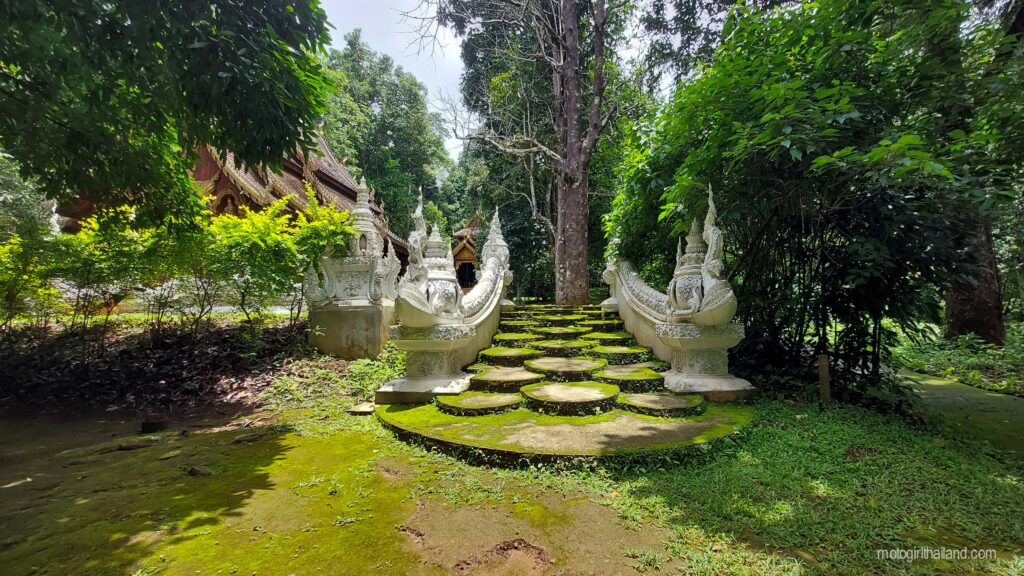
Architectural Features:
The temple complex showcases traditional Lanna-style wooden structures, intricately carved from teak wood. A highlight is the towering standing Buddha statue, measuring approximately 9 meters in height and 2 meters in width, reputed to be the largest wooden Buddha image in the world.
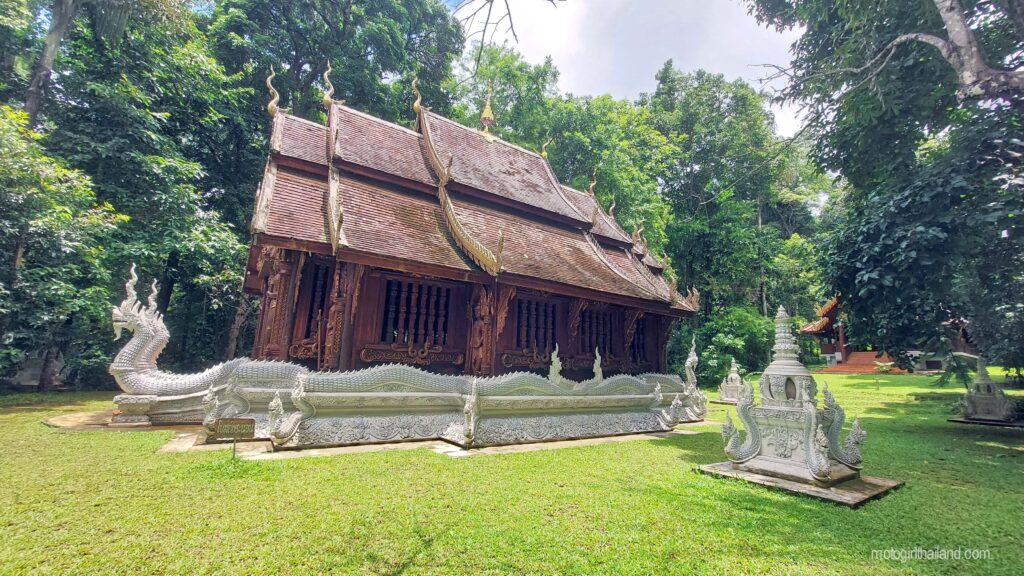
The entrance is marked by a beautifully crafted Naga staircase, with serpent figures that appear lifelike in their detail, guiding visitors into the sacred space.
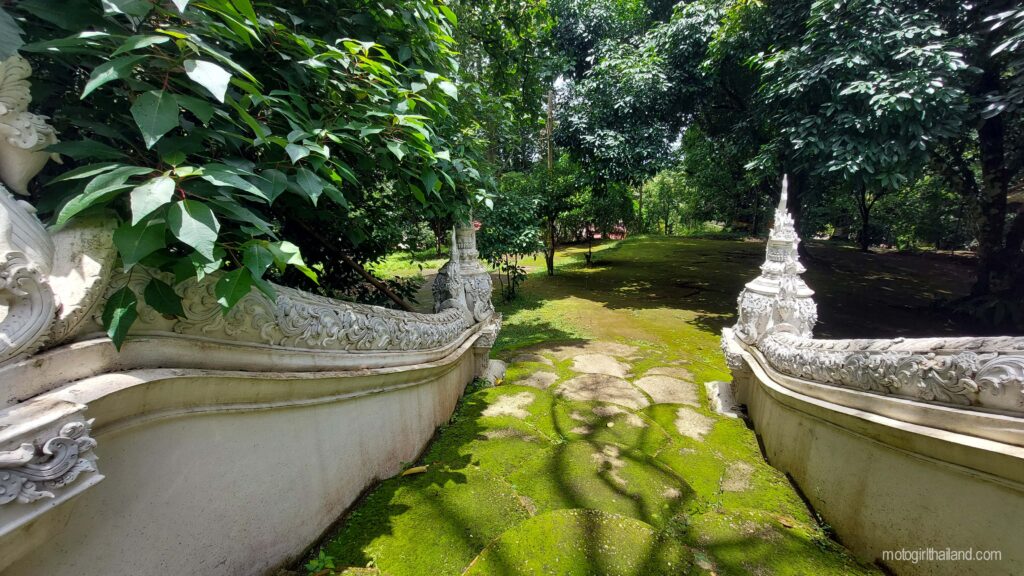
Additional Notes:
The route to the temple involves some dirt roads. It is best to have previous experience riding/driving on dirt roads. Alternatively, hire a local transportation service to take you there. As with all temple grounds, respectful attire and behaviour are expected.
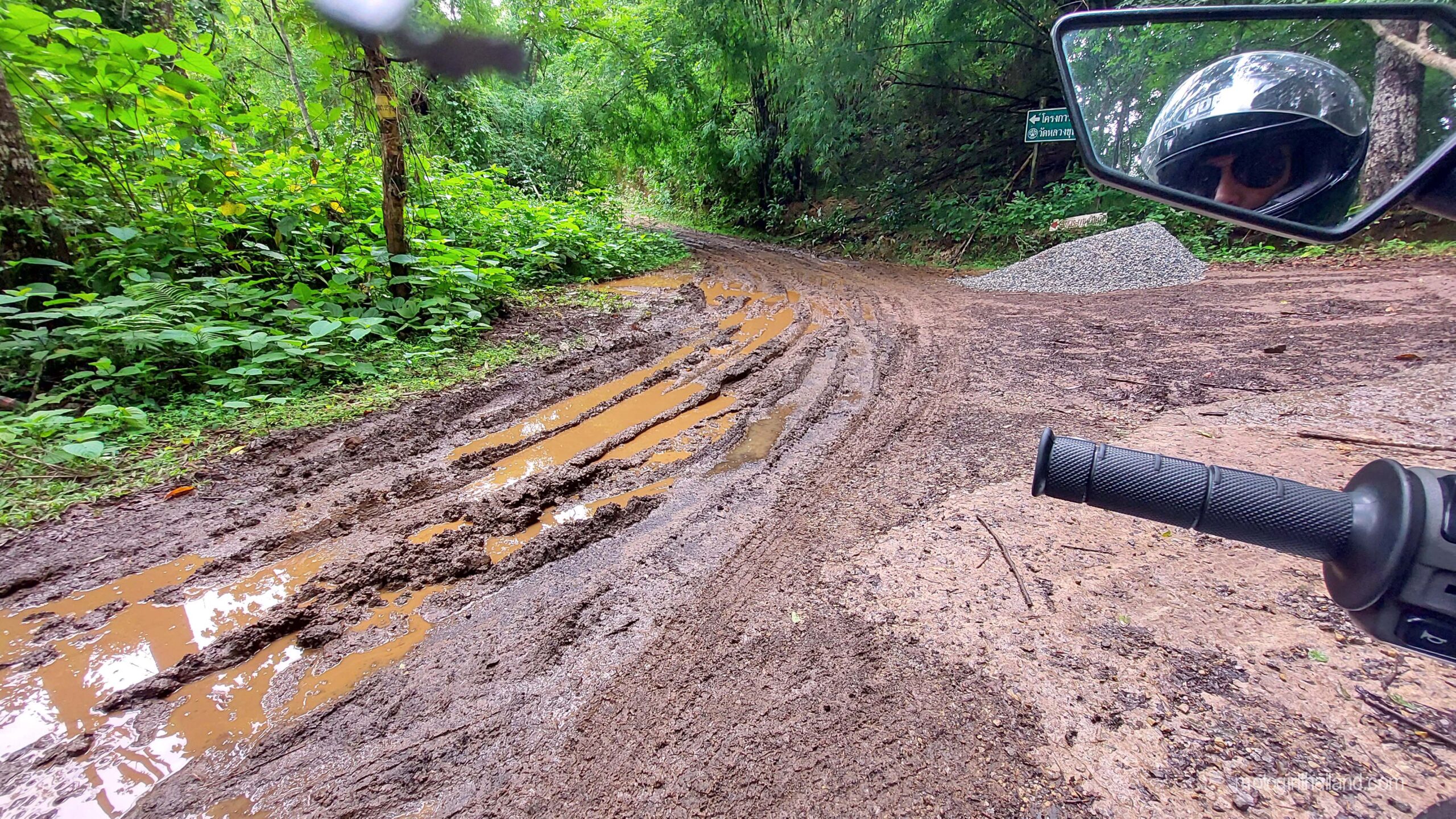
For a visual glimpse into the serene beauty of Wat Luang Khun Win, you will find this video insightful:
9: Wat Doi Udom Tham
“วัดดอยอุดมธรรม“/ Wat Doi Udom Tham is a peaceful, hidden temple located in the lush hills of Mae Taeng District. The temple grounds and facilities are pretty simple (as is the interior), but what makes it special is the mountainous tea plantation location and the unusual temple style. Inspired by ancient Indian and Mon Buddhist architecture, the temple was designed to remind visitors of the roots of Buddhism and the timeless path to enlightenment
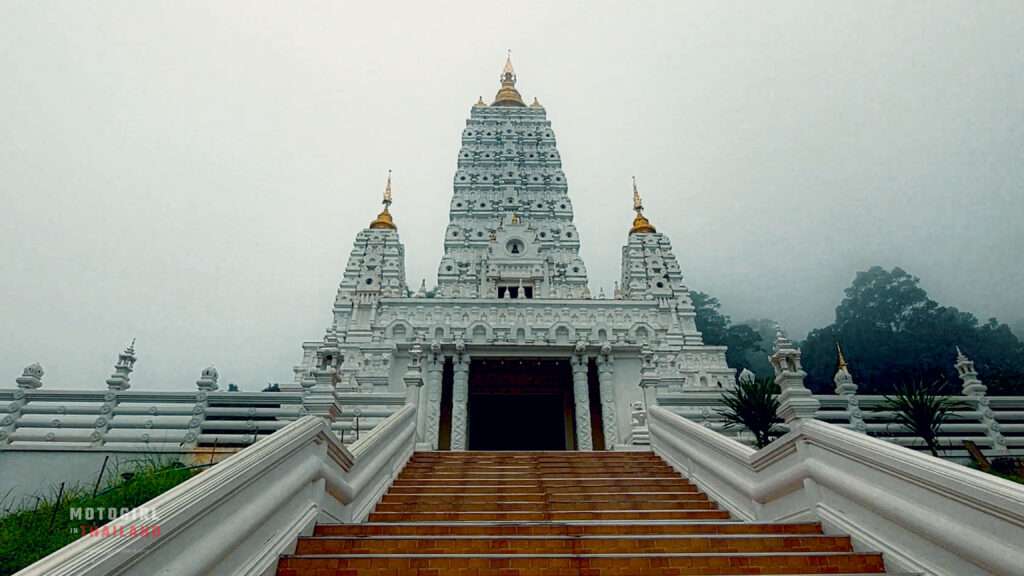
Note: The route to this temple is steep, twisty, and potentially hazardous, especially in wet conditions. It is recommended for experienced riders/drivers. (The video at the end of the ‘more details’ section can give a better idea of the rote condition.)
Details
- Location: 60 km from the City. (Map)
- Opening Hours: Daily, 6:00 AM – 6:00 PM
- Entry: Free (donations welcomed)
- Best Time to Visit: Early morning for misty mountain views and cooler temperatures.
- Parking: Available on the temple grounds.
- Food/Drinks: It is advisable to bring your own.
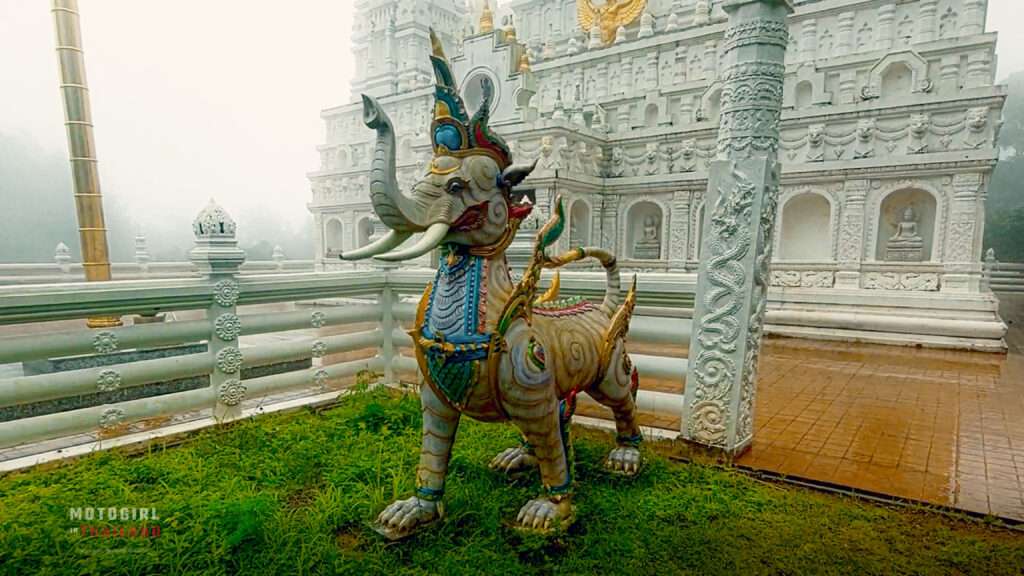
Wat Doi Udom Tham is an unusual hidden temple, set deep in the Mae Taeng Tea Plantation mountains.
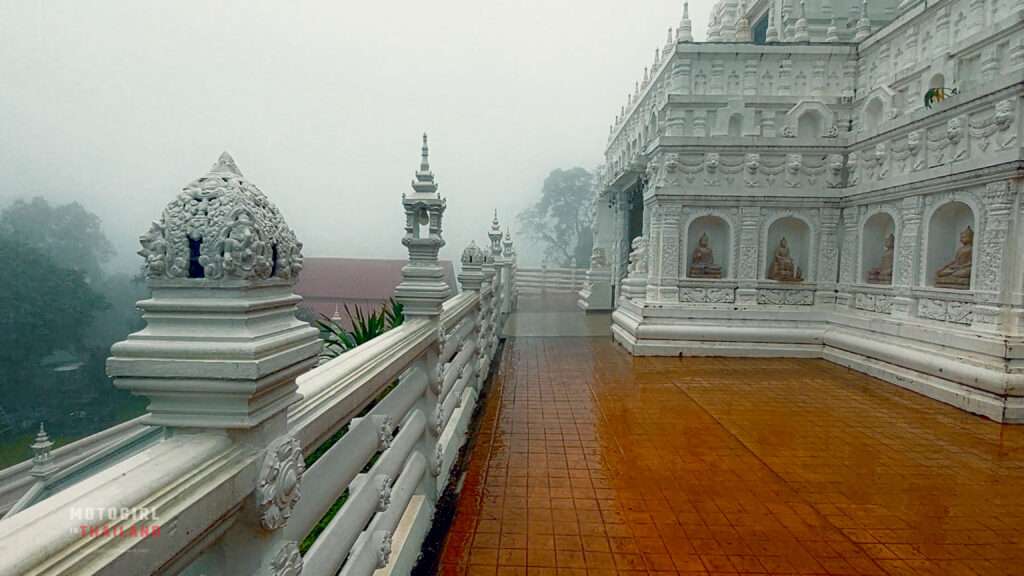
Historical and Cultural Aspects:
The temple is revered for its tranquillity and connection to nature, serving as a quiet haven for meditation, Buddhist practice, and reflection.

While the exact history of Wat Doi Udom Tham is not widely documented, it is believed to be a peaceful retreat for locals and visitors seeking spiritual solace. “Udom Tham” translates to “the ultimate Dharma” or “the ultimate truth,” reflecting the temple’s purpose as a place for profound practice and understanding of Buddhist teachings.
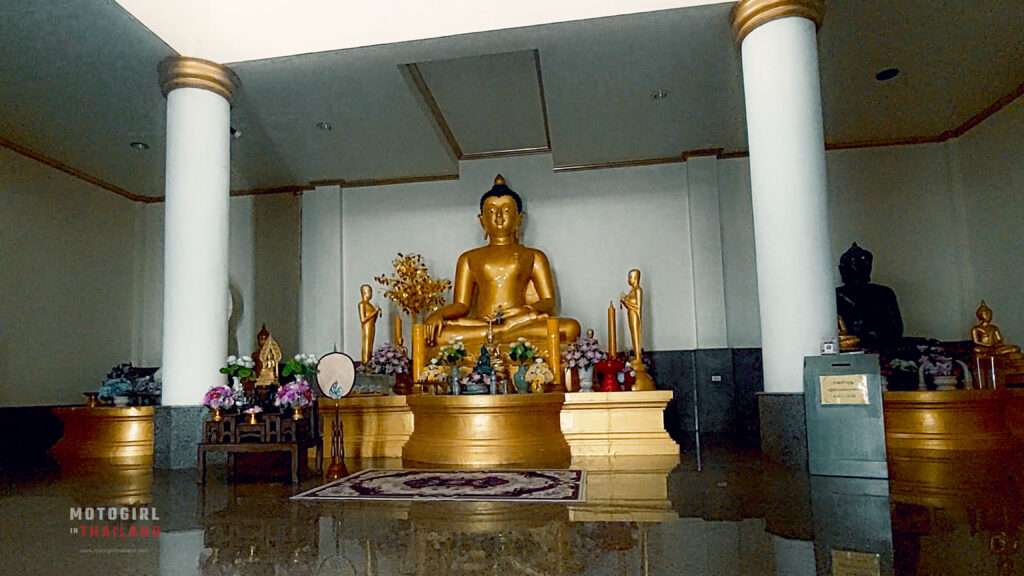
Architectural Features:
The architecture of Wat Udom Tham blends traditional Thai Buddhist design with influences from Indian and Mon styles, creating a striking and serene structure. The tall, slender stupa-like form, painted in pure white with golden accents, symbolises spiritual ascension, purity, and enlightenment.
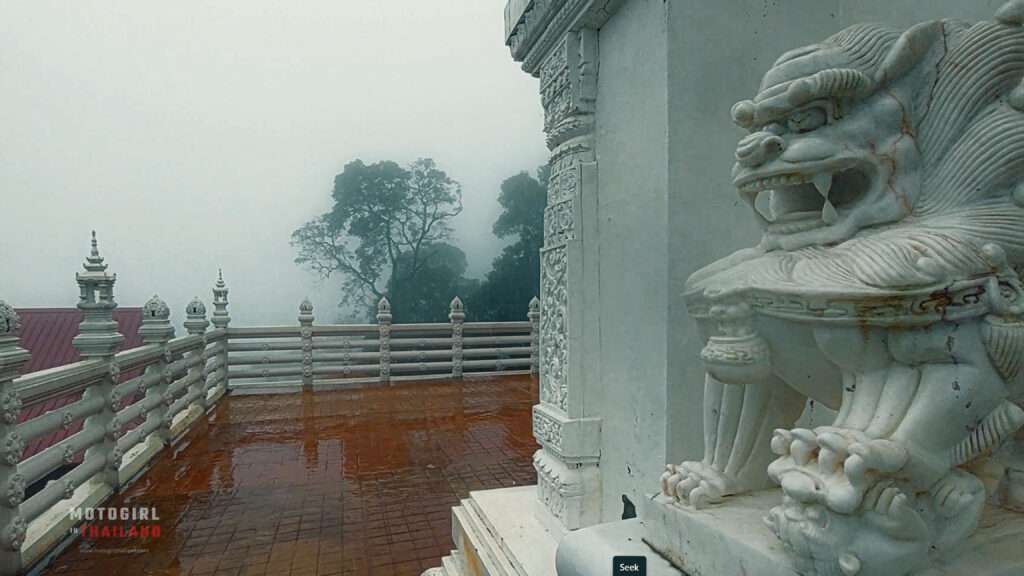
Intricate carvings of deities, mythical creatures, and floral patterns cover the surfaces, reflecting fine craftsmanship and cosmic symbolism. The symmetrical layout and the grand staircase leading up to the entrance represent the spiritual journey toward wisdom and balance between the earthly and divine.
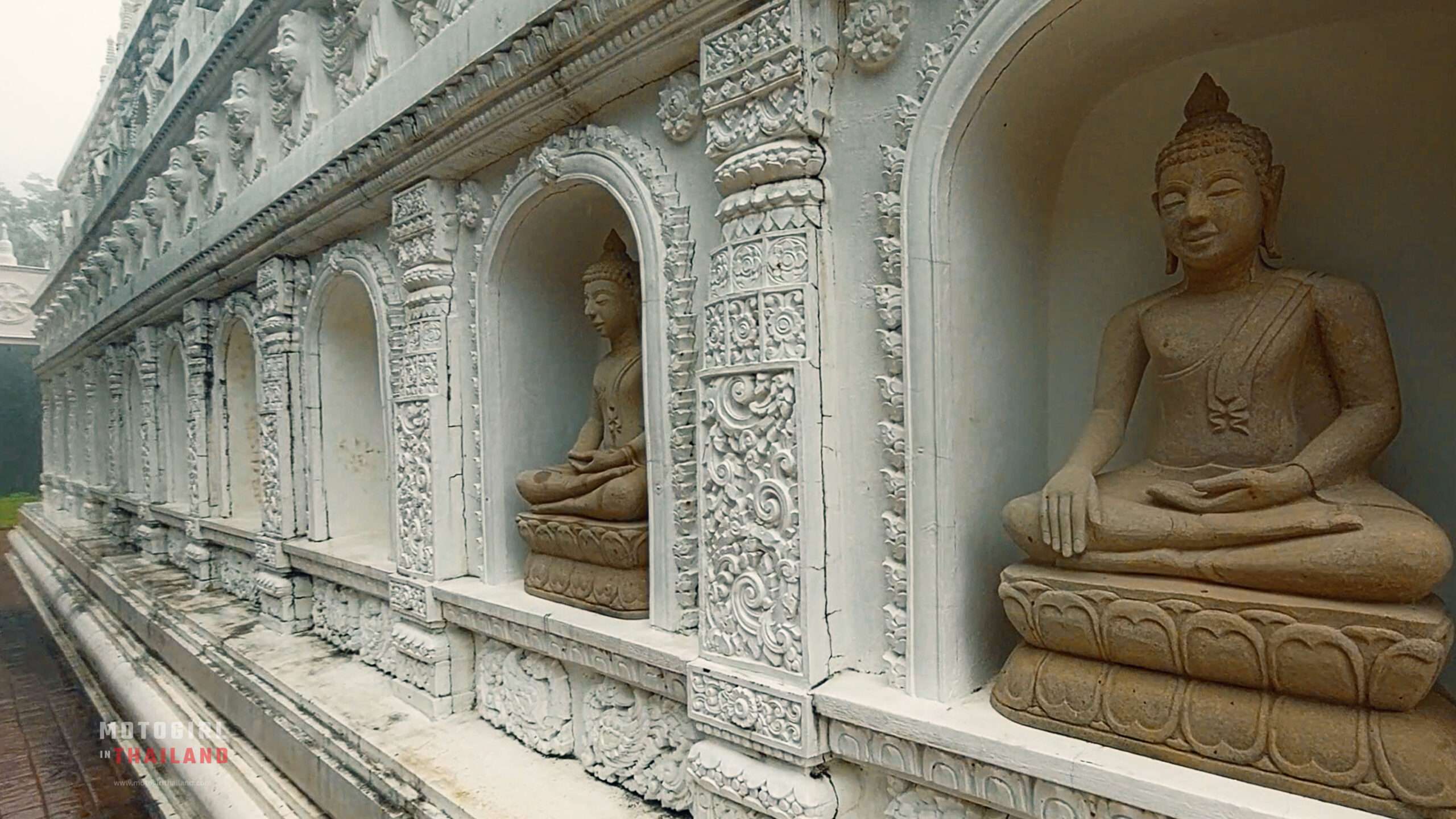
Set against a misty, mountainous backdrop, the temple’s ethereal appearance enhances its sacred, otherworldly atmosphere.
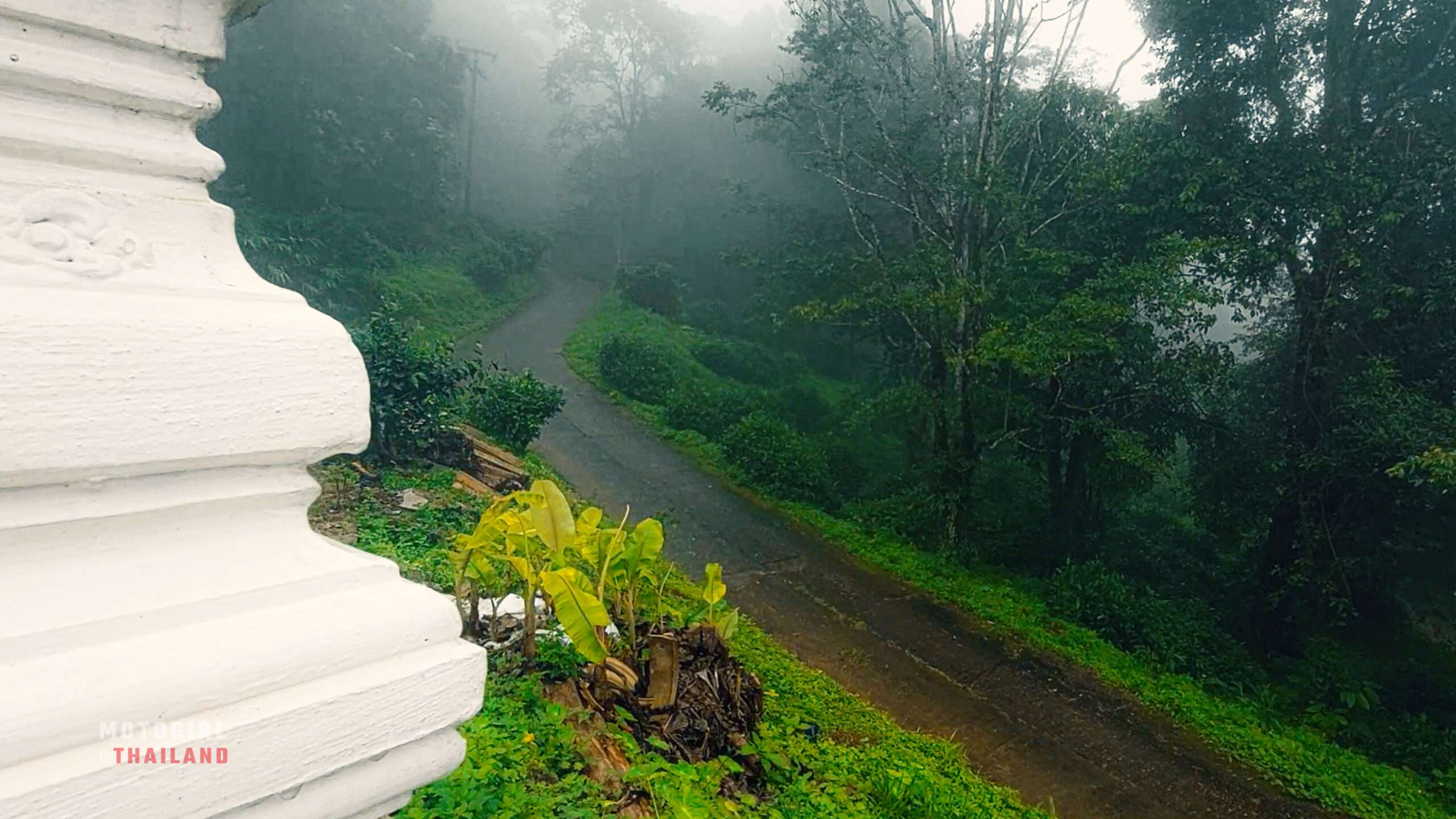
Additional Notes:
Expect an abundance of nature and a serene environment. This temple is truly an off-the-beaten-path experience.
10: Wat Ban Den
“วัดบ้านเด่น” / Wat Ban Den, also known as Wat Den Sali Si Mueang Kaen, is a striking Buddhist temple located in the Mae Taeng District. Once a modest village temple, it has transformed into a colourful and expansive temple complex. The temple is renowned for its harmonious blend of traditional Lanna architecture and vibrant, whimsical design elements, earning it nicknames such as “Thailand’s Blue Temple” and “the Electric Kool-Aid Acid Temple”!
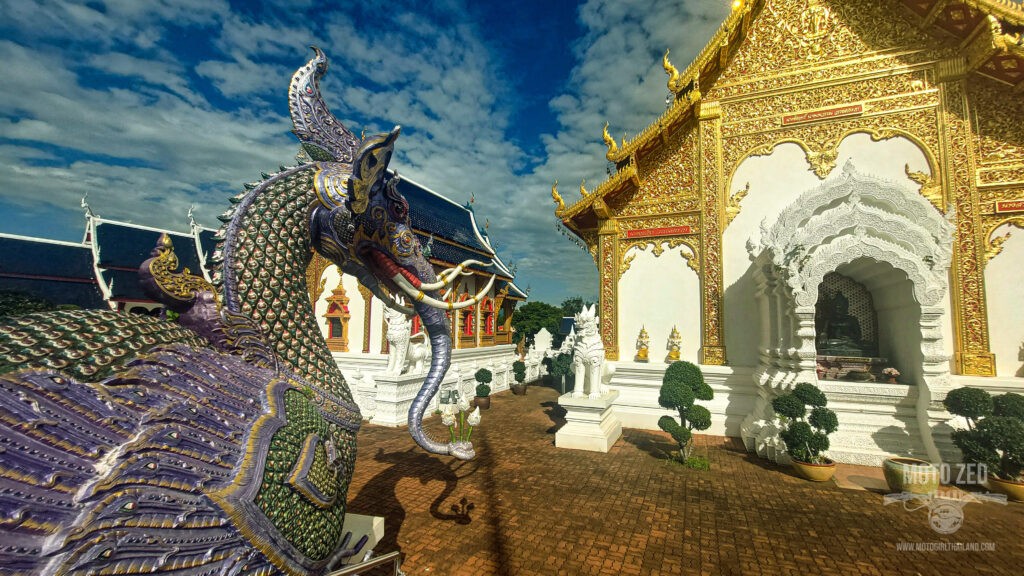
Details
- Location: 45 km from the City (Map)
- Opening Hours: Daily, 6:00 AM – 6:00 PM
- Entry: Free (donations welcomed)
- Best Time to Visit: Early morning or late afternoon for optimal lighting and cooler temperatures.
- Parking: Ample parking is available at the temple grounds
- Food/Drinks: Many local cafes and eateries in the area.
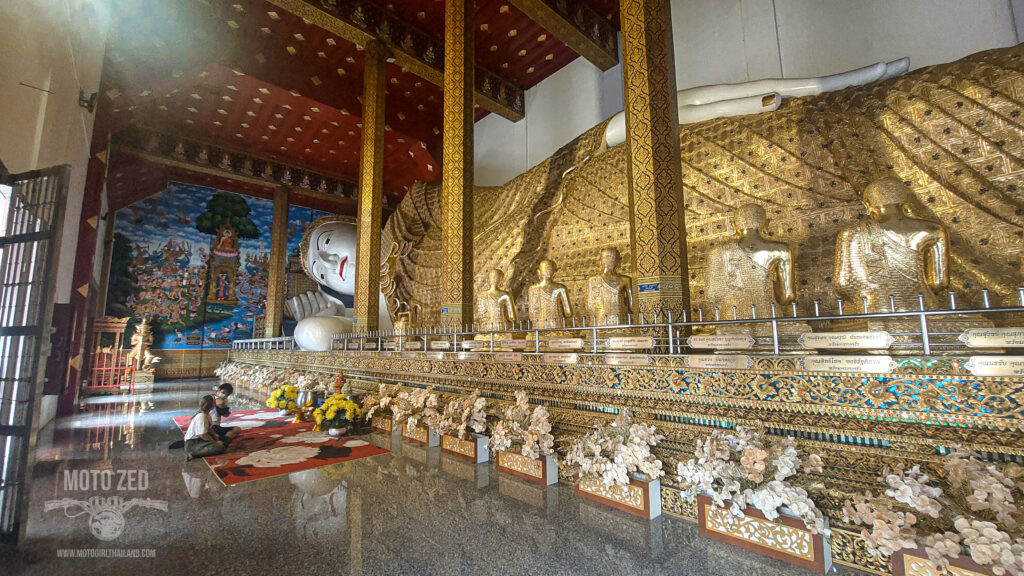
Wat Ban Den is certainly one of the more unusual temples you will ever see in Thailand. Well worth visiting for the experience and visual delights!
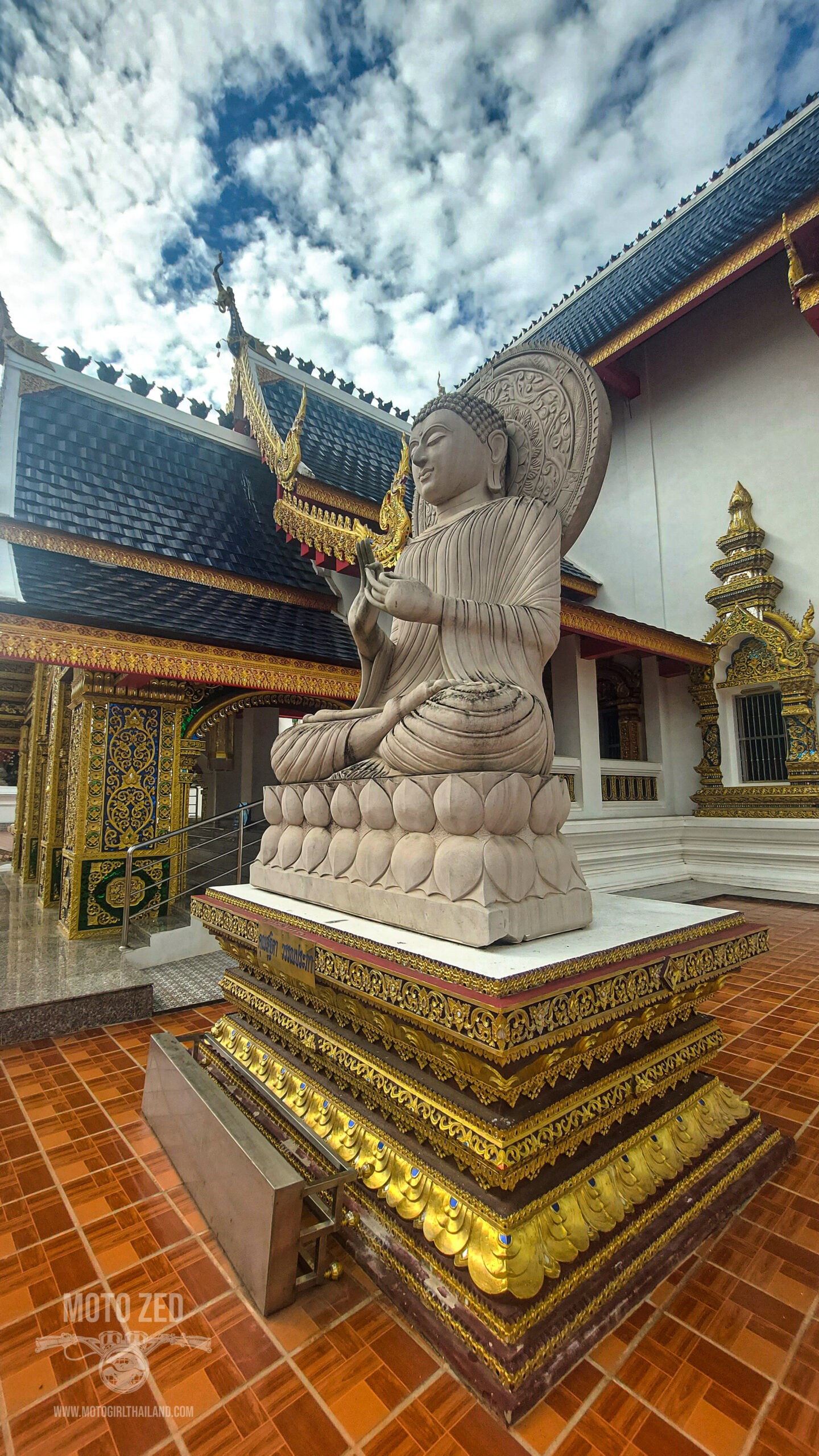
Historical and Cultural Aspects:
Established over 500 years ago as a modest village temple, Wat Ban Den underwent significant renovations beginning in 1988 under the guidance of Phra Kru Ba Tuang, a revered abbot. His vision was to create a grand spiritual complex that would attract visitors and serve as a centre for Buddhist practice.
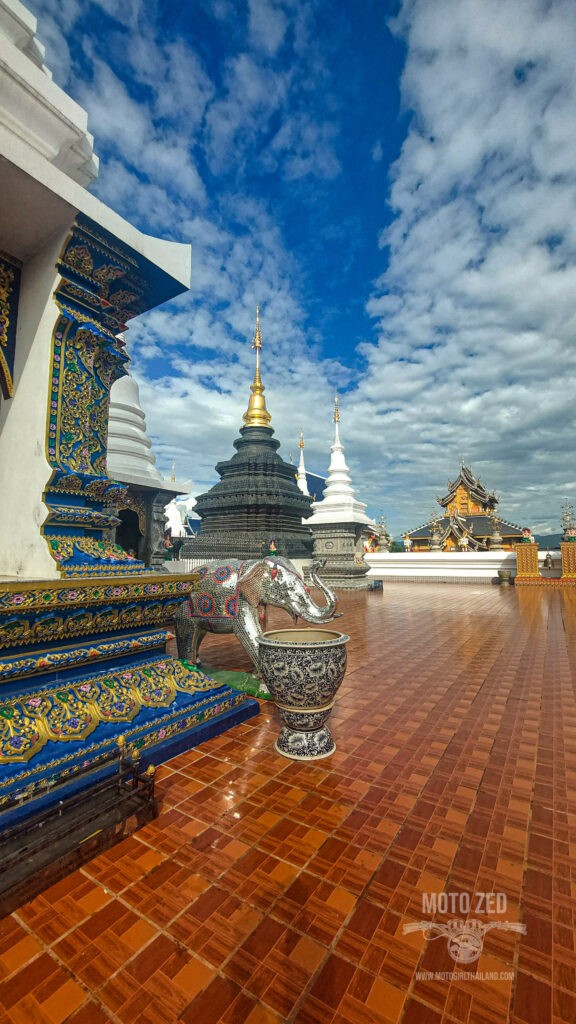
The temple’s transformation was largely funded through donations, including a notable contribution of 39 “money trees” during the abbot’s 39th birthday celebration.

Architectural Features:
The temple complex at Wat Ban Den blends Lanna, Burmese, and Thai architectural styles, featuring multi-tiered roofs adorned with intricate wood carvings, vibrant stucco work, and colourful details.
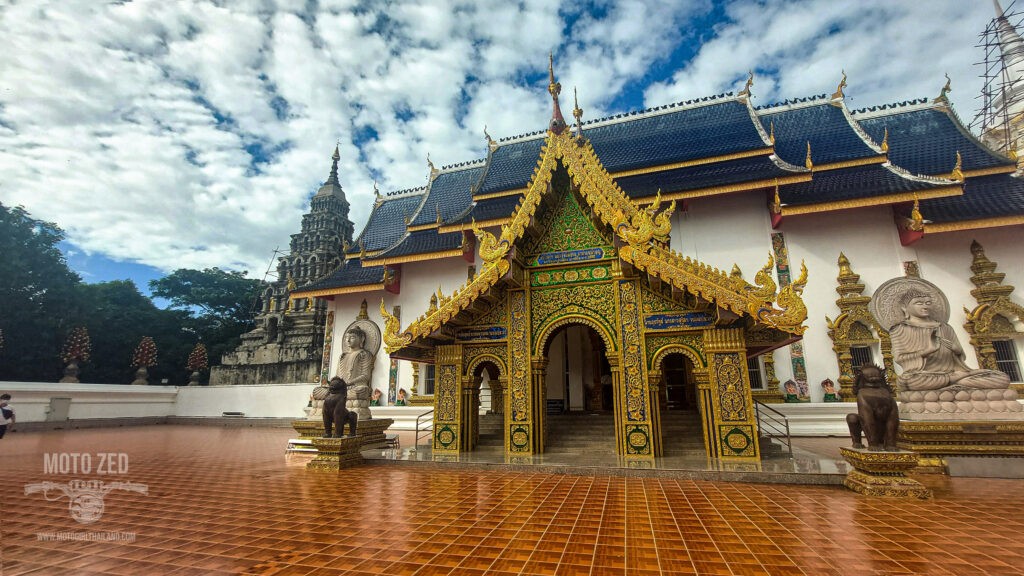
The design includes 12 stupas (chedis) representing the Chinese zodiac, mythical creature sculptures like dragons and lions guarding entrances, and a grand teak viharn with a three-tiered roof, blue tiles, and golden bargeboards.
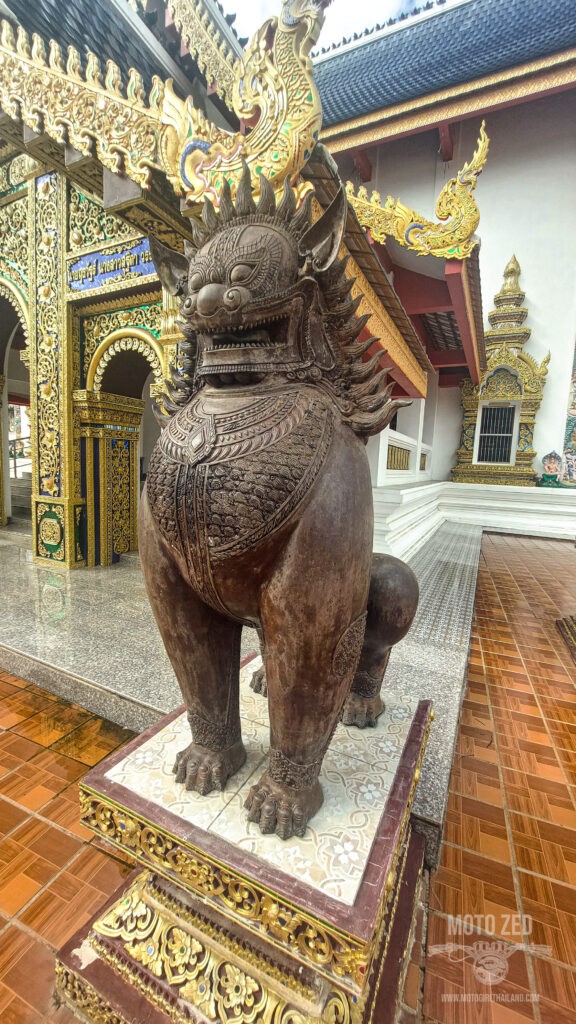
These elements combine to create a visually stunning and fantastical environment, often compared to a Buddhist theme park.
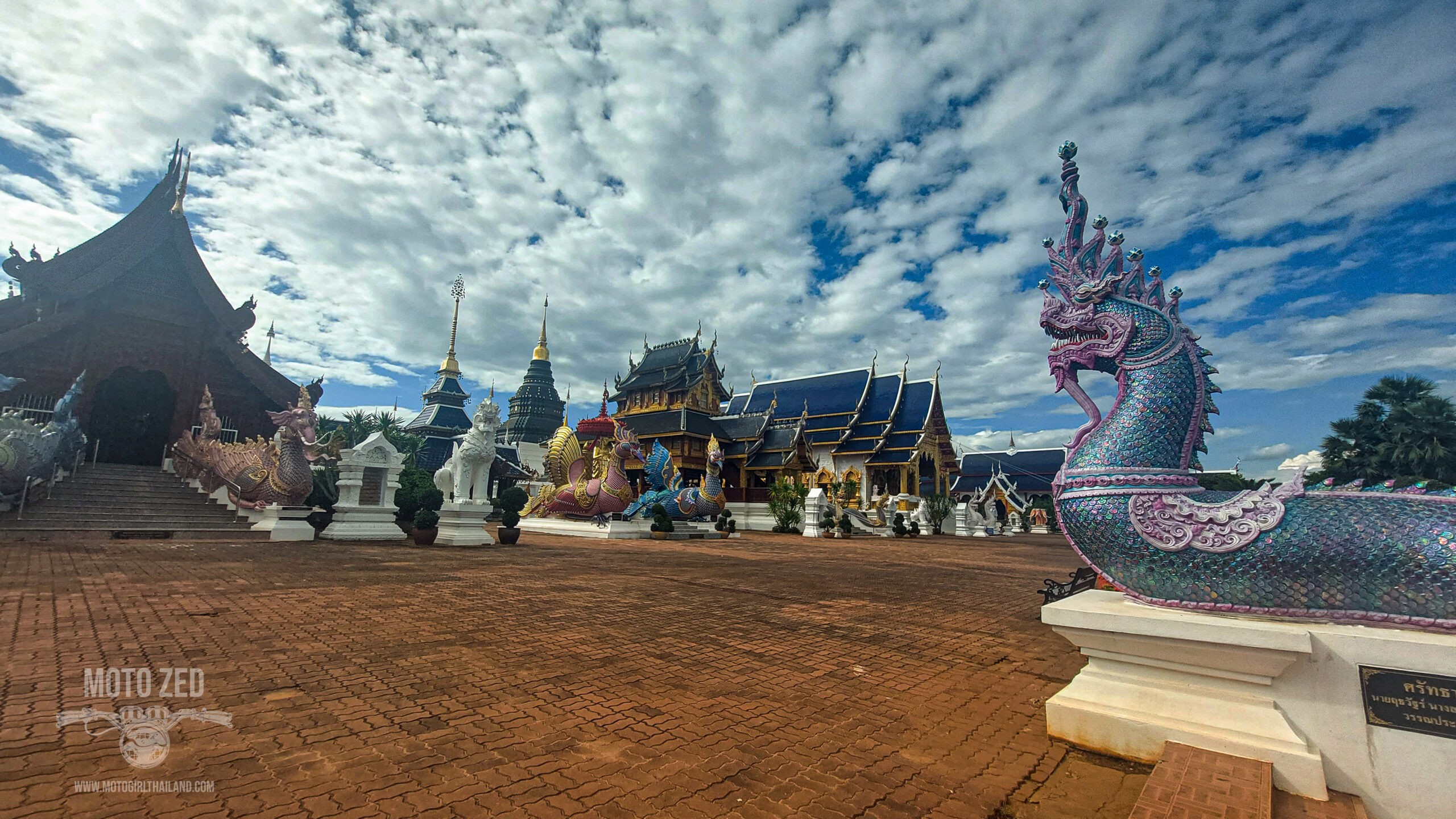
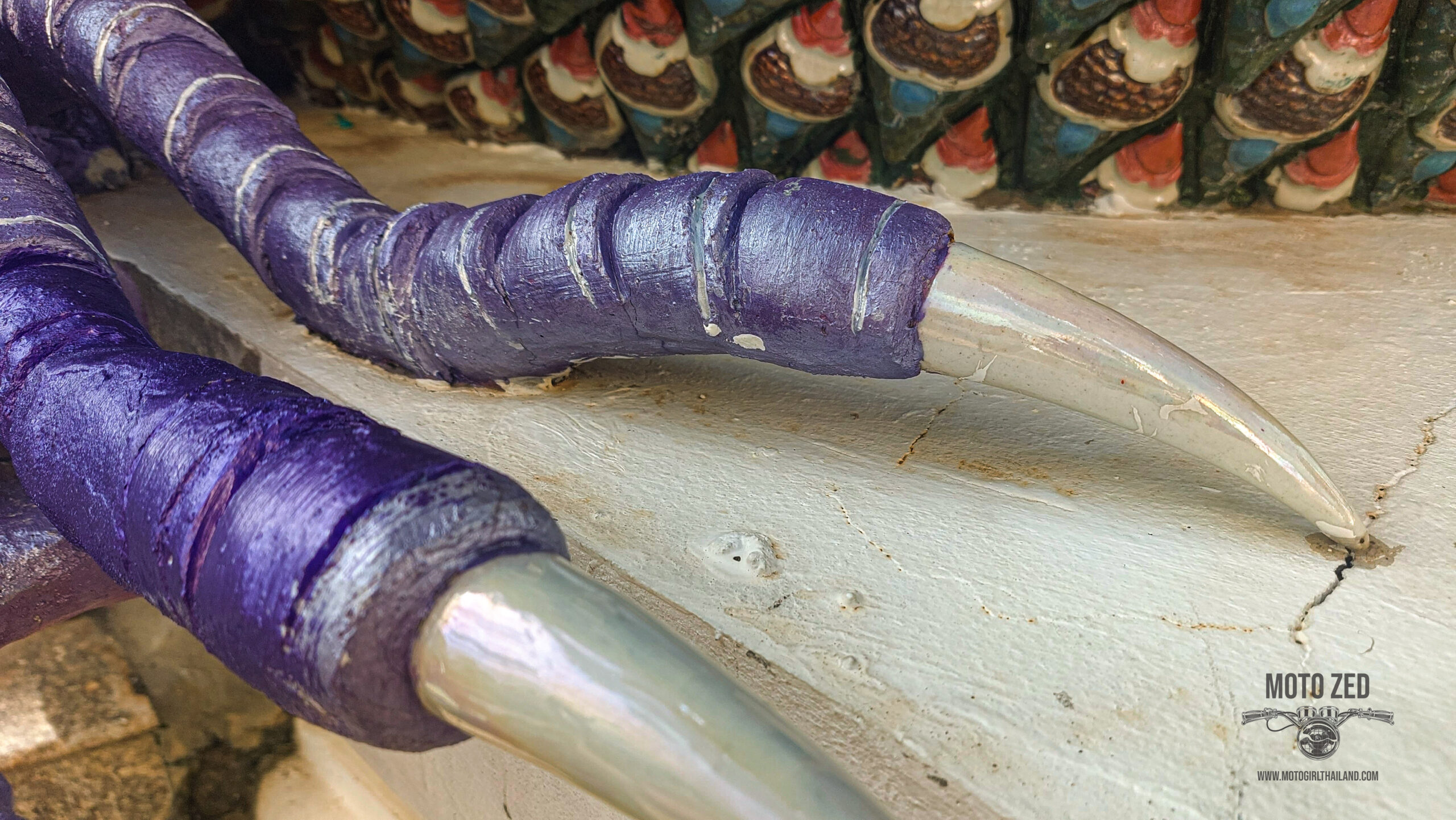
Additional Notes:
Although playful and vibrant in design, Wat Ban Den is an active place of worship, and visitors should dress modestly and maintain a respectful noise level during their visit.
11: Wat Khantha Phueksa
“วัดคันธาพฤกษา” / Wat Khantha Phueksa, also known as Wat Mae Kampong, is a tranquil Buddhist temple nestled in the lush village of Mae Kampong, Mae On District. Established around 1925 as a hermitage, it was transformed into a temple in 1930 under the guidance of Kruba Insom Khanthornso.
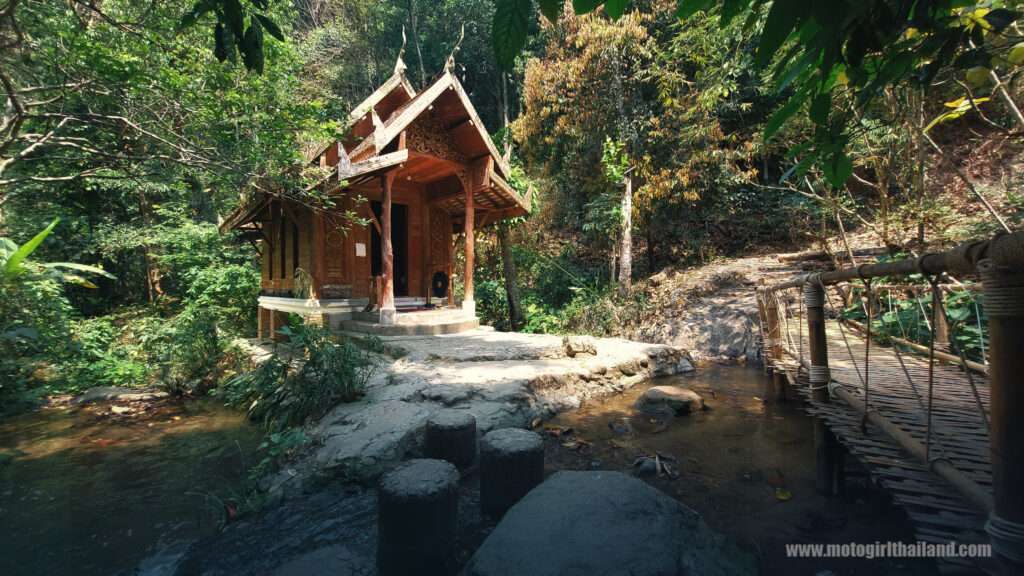
Details
- Location: 50 km from the City. (Map)
- Opening Hours: Daily, 6:00 AM – 6:00 PM
- Entry: Free (donations welcomed)
- Best Time to Visit: Morning hours, especially during the Cool Season when mist drifts through the hills.
- Parking: Limited parking is available near the temple and village.
- Food/Drinks: A small selection of cafes and local eateries are available in Mae Kampong village.
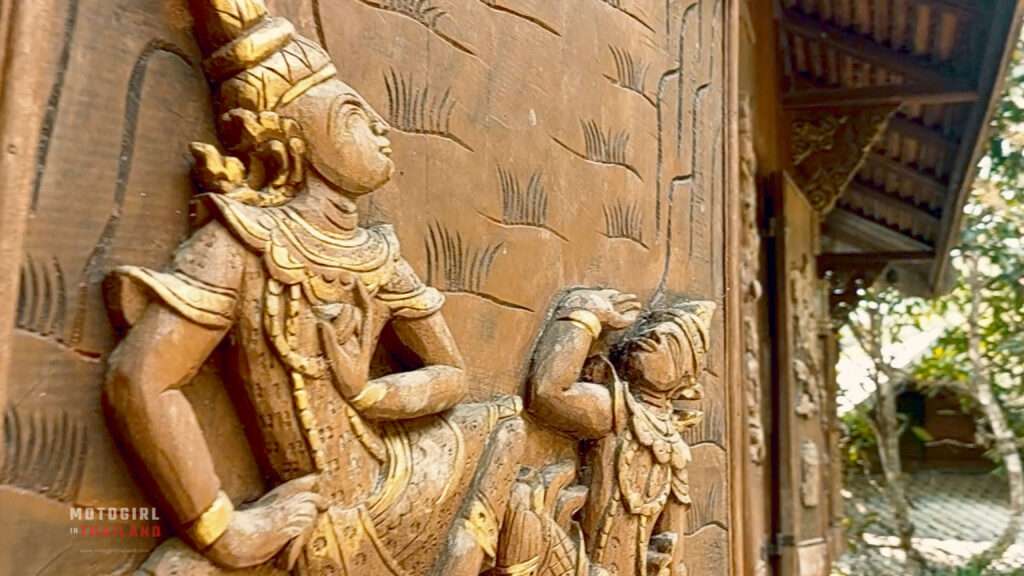
Wat Khantha Phueksa is a unique and charming hidden temple within Mae Kampong village, offering a peaceful, authentic Lanna village experience.

Historical and Cultural Aspects:
Wat Khantha Phueksa was originally established as a hermitage in the early 20th century and became an official temple in 1930. It is a deeply spiritual centre for the local community, reflecting the quiet, slow-paced traditions of Mae Kampong village.
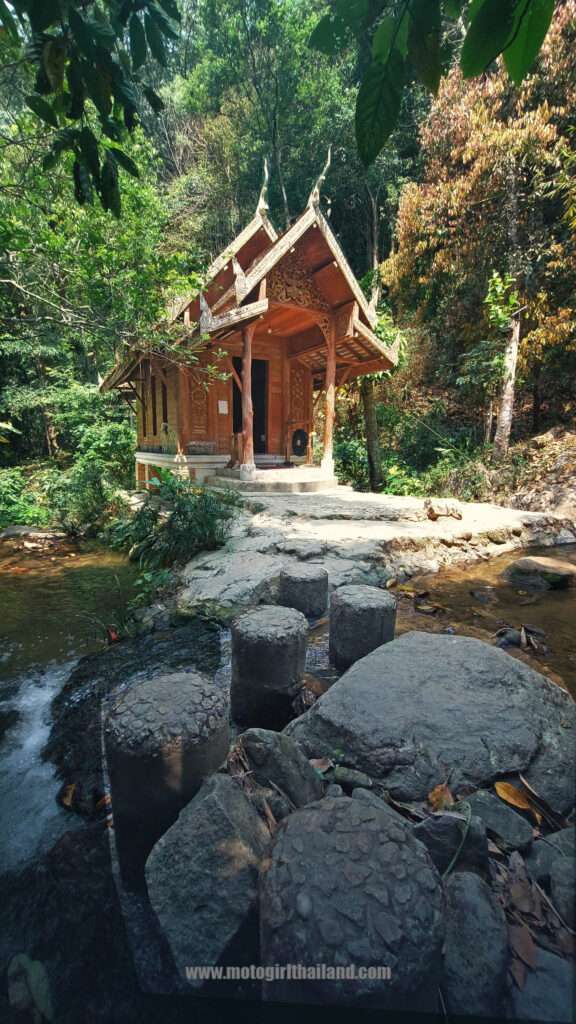
Architectural Features:
The most striking feature of Wat Khantha Phueksa is its ordination hall (Ubosot), which is uniquely built in the middle of a pond — a rare design found only in a few temples in Northern Thailand. This symbolises purity and separation from the secular world.
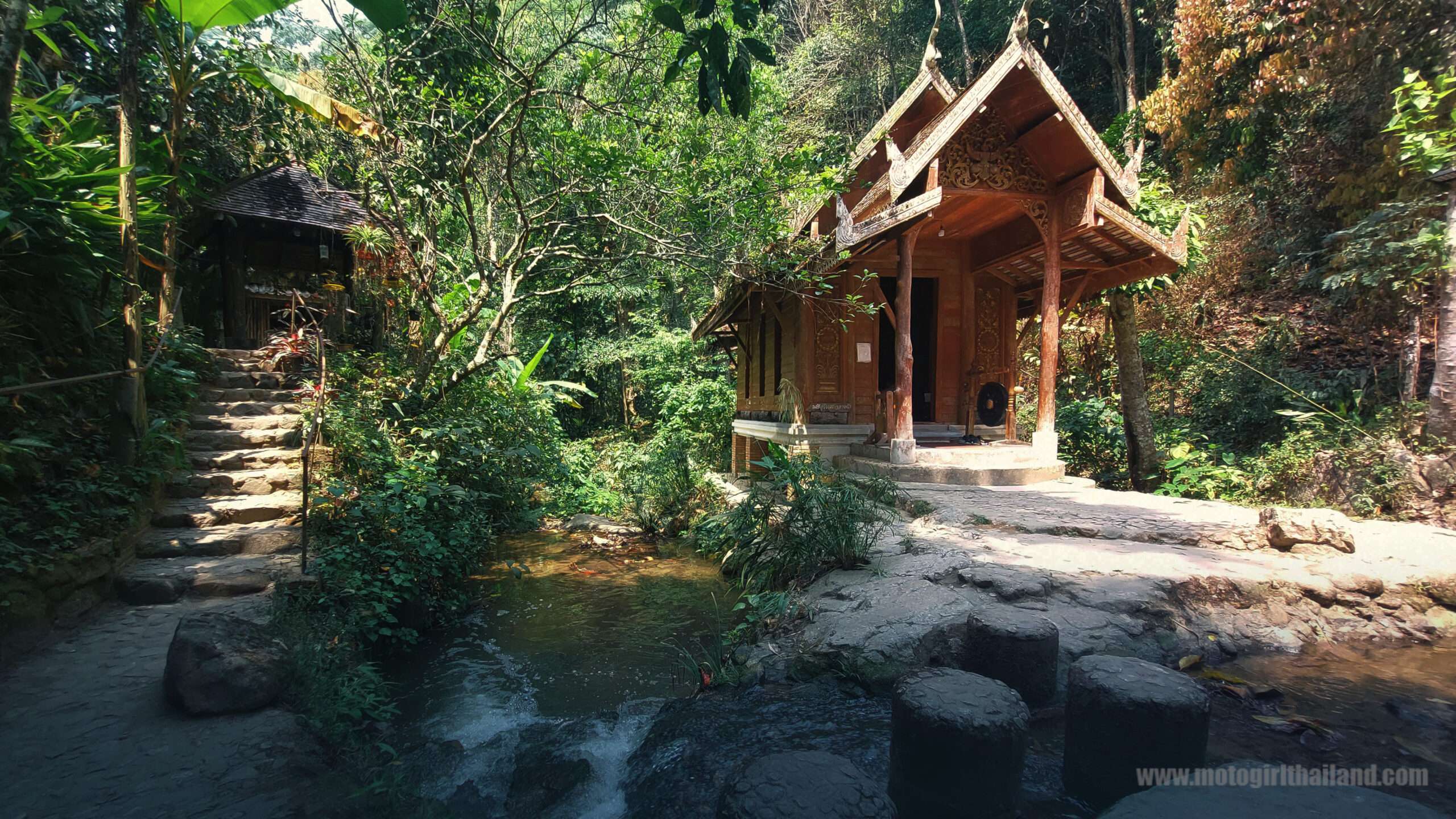
The Viharn (assembly hall) is built from richly carved teak wood, showcasing exquisite traditional Lanna craftsmanship.
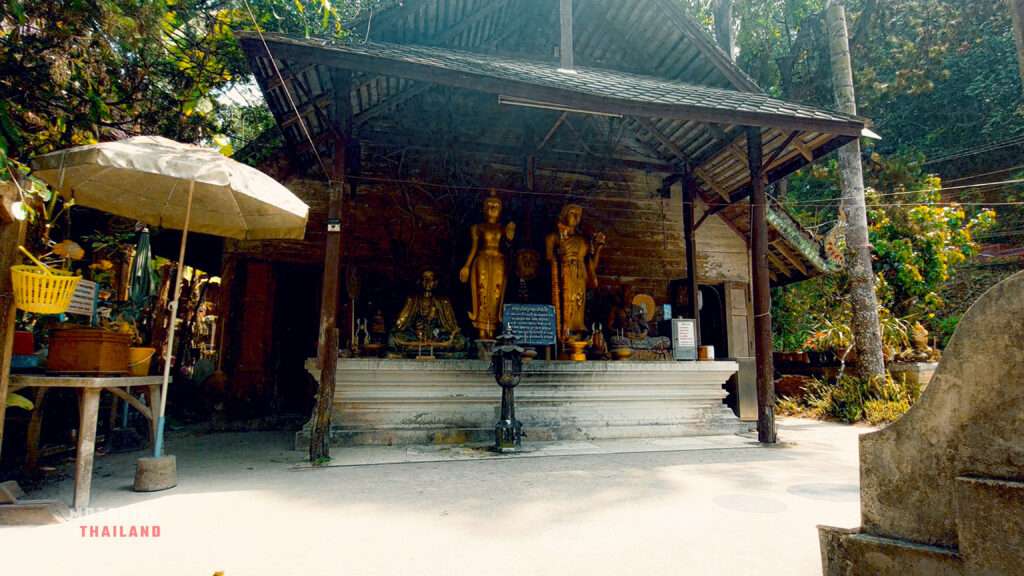
Additional Notes:
Visitors to the temple will also go through Mae Kampong village = a quaint mountain village which stands at around 1,300 meters above sea level.
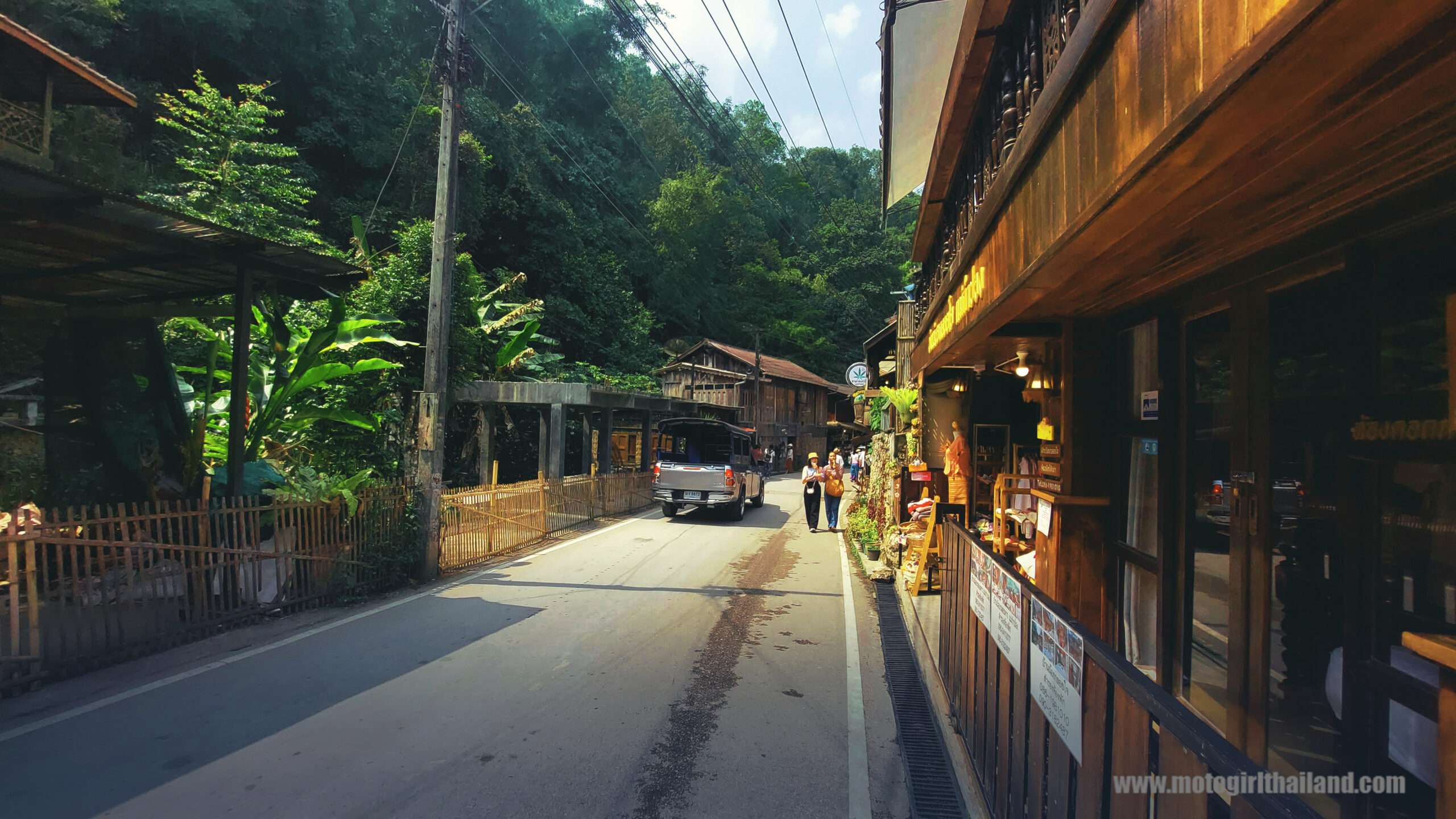
Known for its cool climate, lush forest surroundings, and charming wooden homes, the village offers a glimpse into traditional Northern Thai life.

It’s famous for eco-tourism, coffee plantations, homestays, and its peaceful, slow-paced atmosphere — perfect for visitors seeking nature, culture, and authentic local experiences.
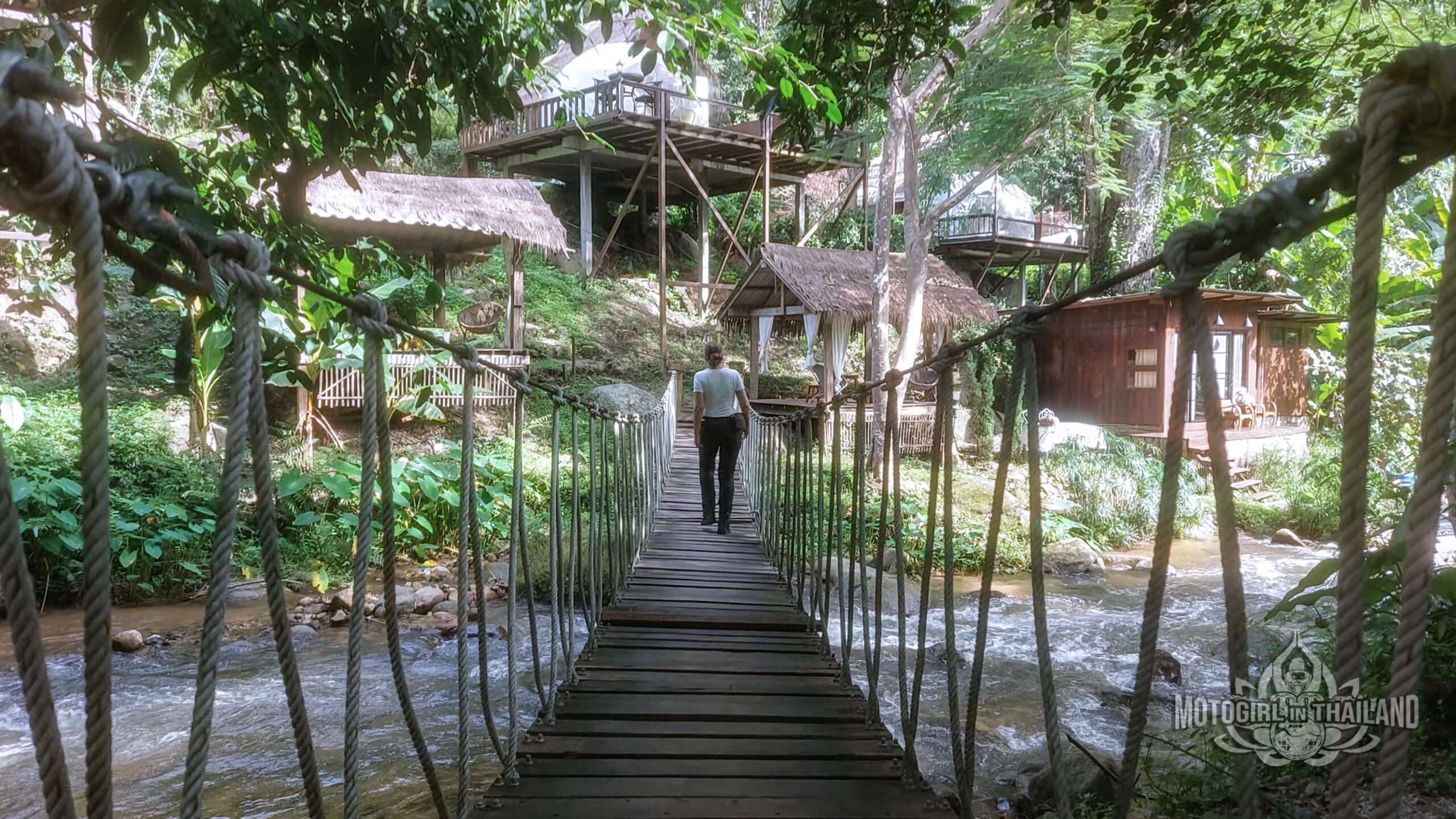
This video shows some of the beauty on offer at Mae Kampong, including the stunning Khantha Phueksa temple.
12: Kuan Im Chokchai
พระแม่กวนอิมมหาโพธิสัตว์/ Kuan Im Chokchai is a Chinese temple surrounded by serene gardens and traditional Chinese-style architecture, which includes an interesting giant dragon statue.
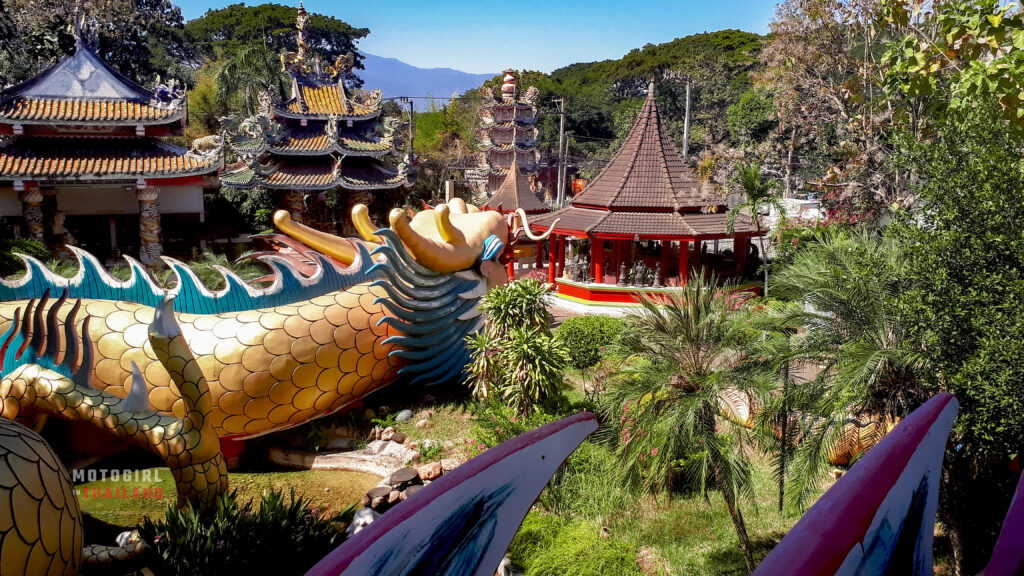
Details
- Location: 10 km from the City. (Map)
- Opening Hours: Daily, 7:00 AM – 5:30 PM
- Entry: Free (donations welcomed)
- Best Time to Visit: Early morning for cool and pleasant weather.
- Parking: Available streetside.
- Food/Drinks: It is advisable to bring your own.
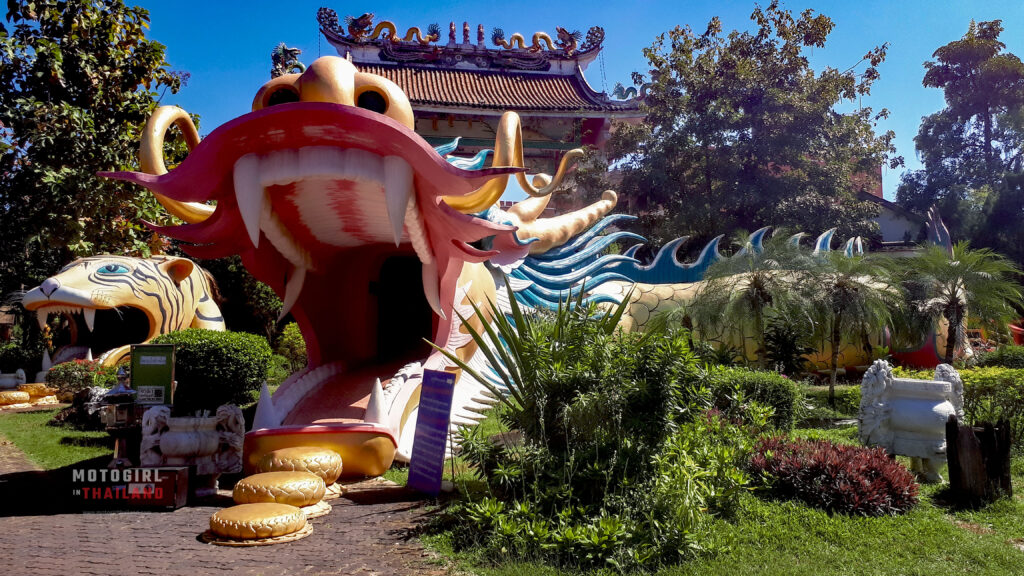
Surrounded by lush gardens and traditional Chinese architecture, this unique and interesting temple is well worth a visit.
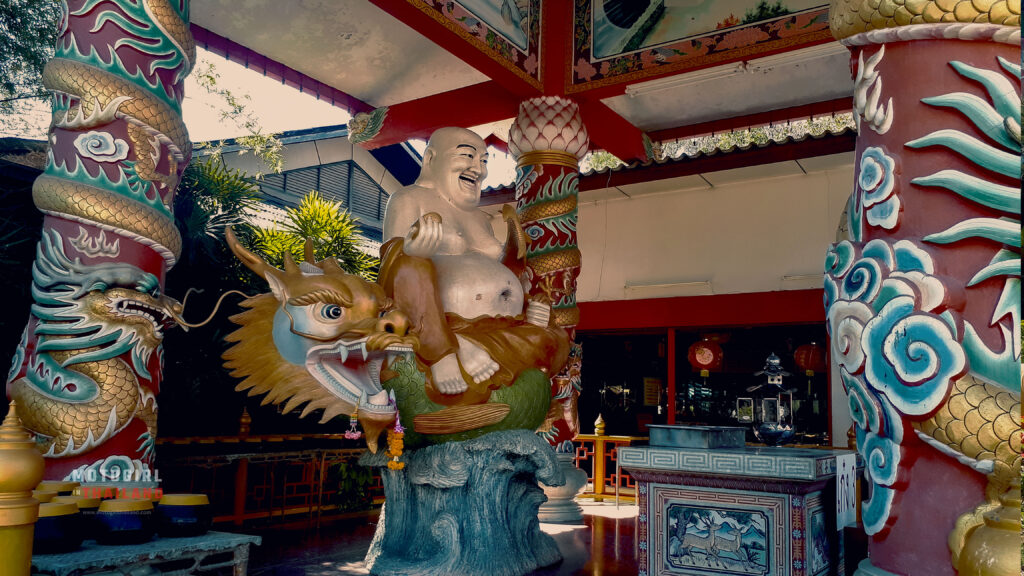
Historical and Cultural Aspects:
While not ancient, Kuan Im Chokchai reflects the strong cultural influence of Chinese Buddhism in Thailand. It serves as a centre for worshippers who seek blessings, peace, and healing under the compassion of Guan Yin.
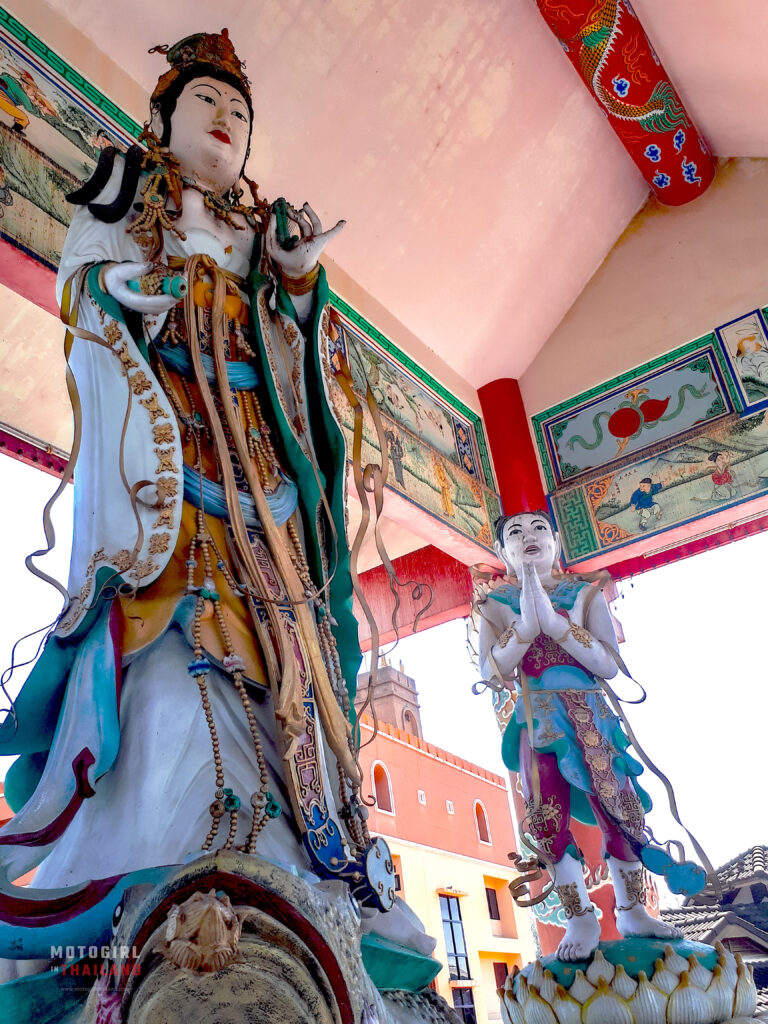
Architectural Features:
Traditional Chinese motifs such as lotus flowers, colourful pavilions and large interesting statues can be found in the temple, including a large dragon statue with detailed murals inside its body.

You can walk through the body of the dragon to enjoy the depicted story within.
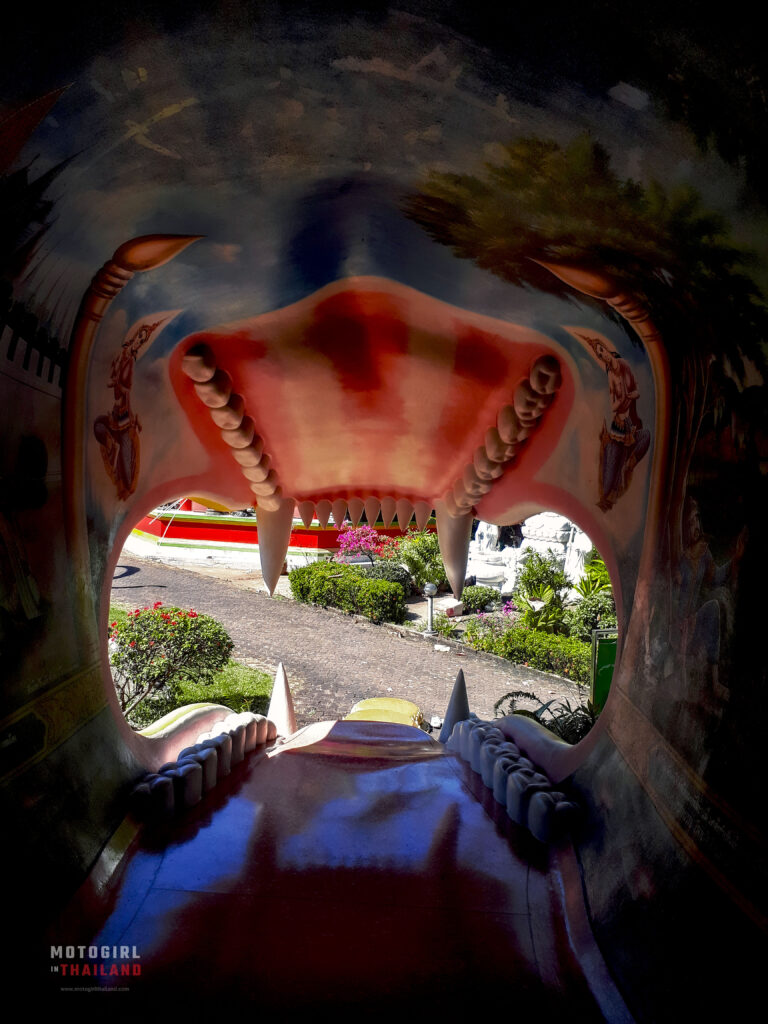
There is also an additional tiger statue that you can enter.

The careful landscaping, including small ponds and flowering plants, adds to the tranquil atmosphere, inviting visitors to slow down and reflect.
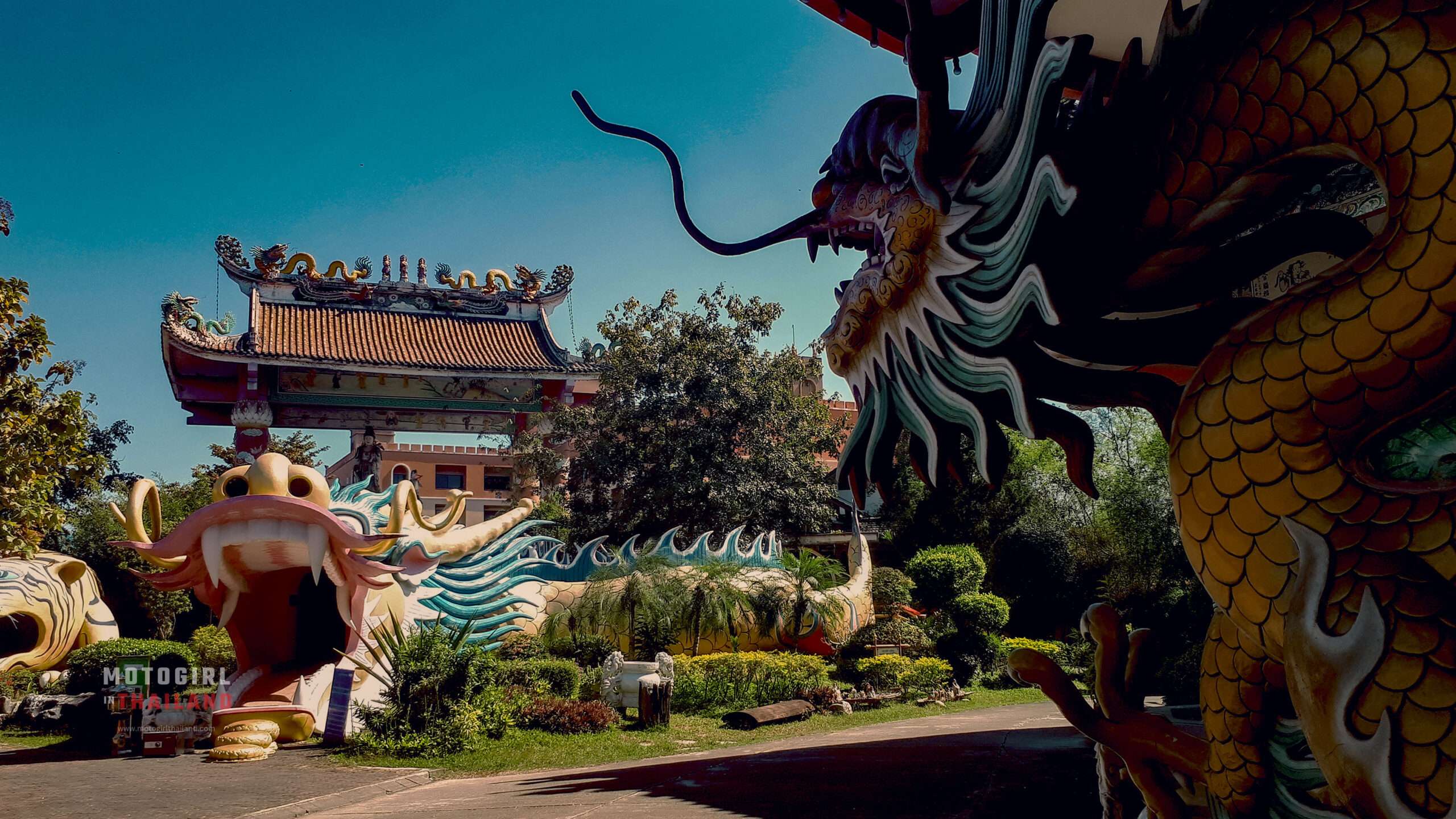
13: Wat Phra Borommathat
วัดพระบรมธาตุดอยผาส้ม / Wat Phra Borommathat Doi Pha Som is a temple sanctuary that harmoniously blends spiritual devotion with environmental stewardship. The temple offers visitors a peaceful Buddhist retreat and a glimpse into the integration of sustainable living principles.

Details
- Location: 80 km from the City (Map)
- Opening Hours: Daily, 6:00 AM – 6:00 PM
- Entry: Free (donations welcomed)
- Best Time to Visit: Early mornings for a serene atmosphere and soft lighting.
- Parking: Available at the base of the temple grounds.
- Food/Drinks: No food or drink available onsite; consider bringing your own or visiting local eateries in Samoeng town.

Wat Phra Borommathat Doi Pha Som is home to not only eco-issues and spiritual serenity, but also a fun surprise—a giant yak guardian!
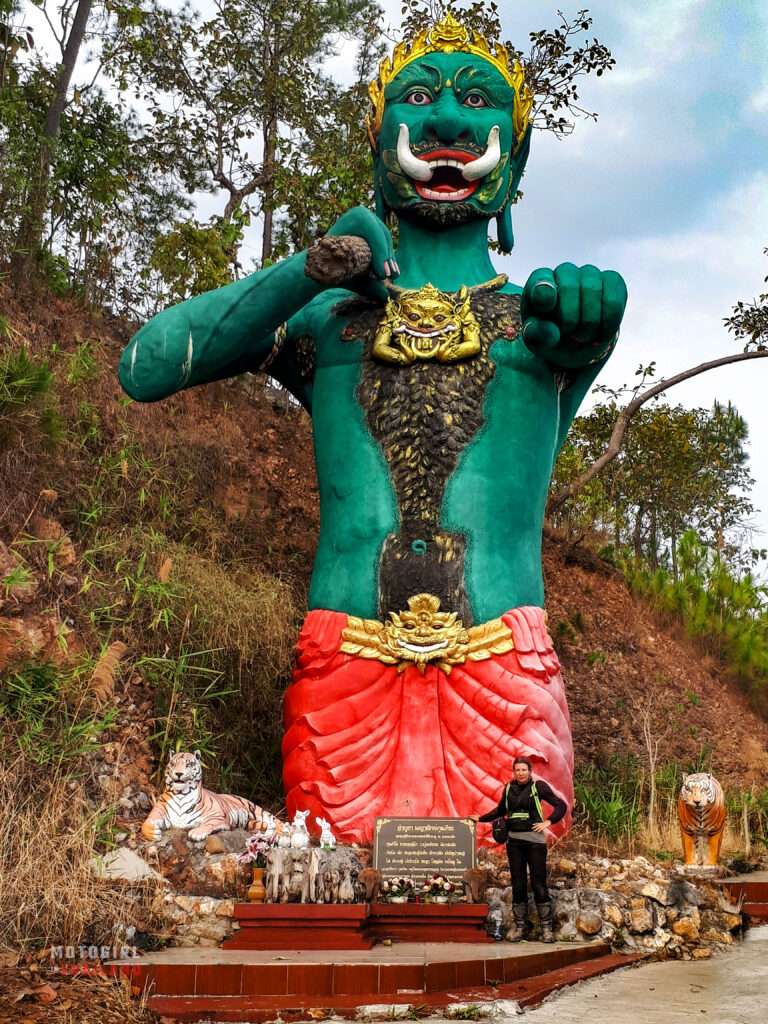
This towering, colourful figure watches over the temple with a fierce expression, making it an iconic feature that visitors can’t help but admire.
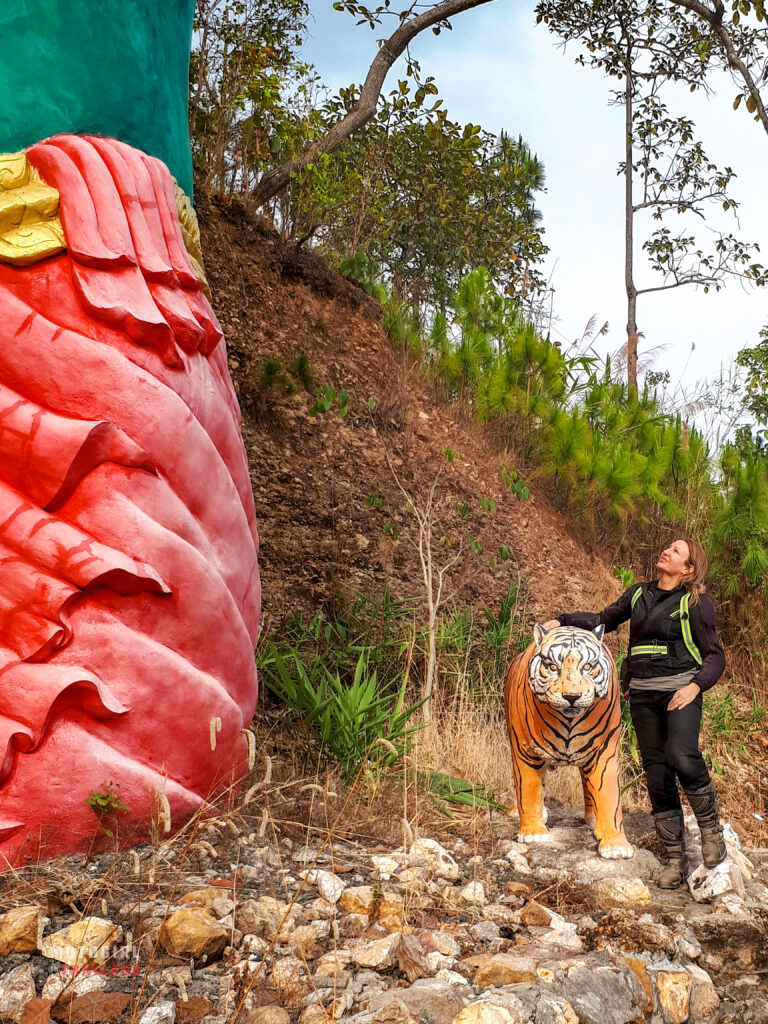
Historical and Cultural Aspects:
Wat Phra Borommathat Doi Pha Som is believed to house sacred relics of the Buddha, making it a revered site for local devotees. However, beyond its religious significance, the temple serves as a model for sustainable living, embodying the late King Bhumibol Adulyadej’s philosophy of sufficiency economy.
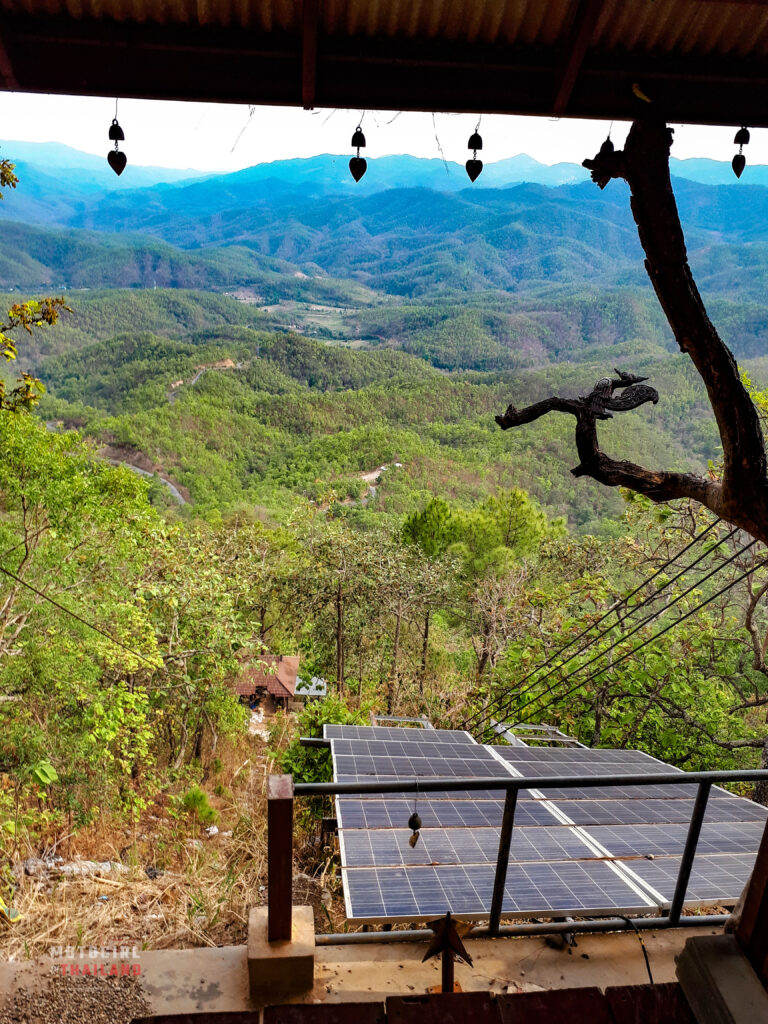
Since 2008, under the guidance of Abbot Phra Sorayut Chaiyapanyo, the temple has implemented initiatives such as forest conservation, water resource management, and community education programs, fostering a self-reliant and environmentally conscious community.
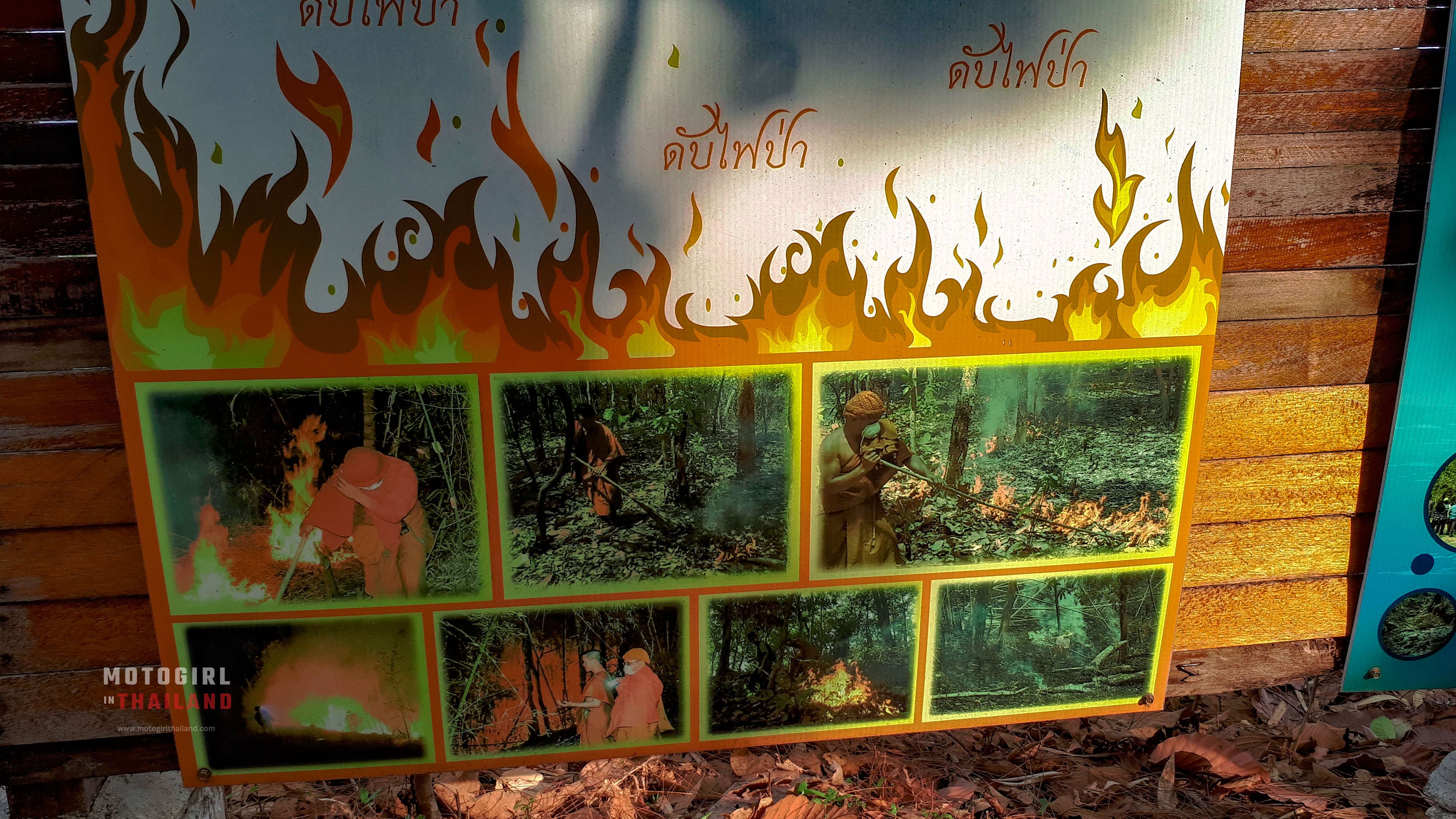
Dotted around the temple grounds is evidence of sustainability education and practices.
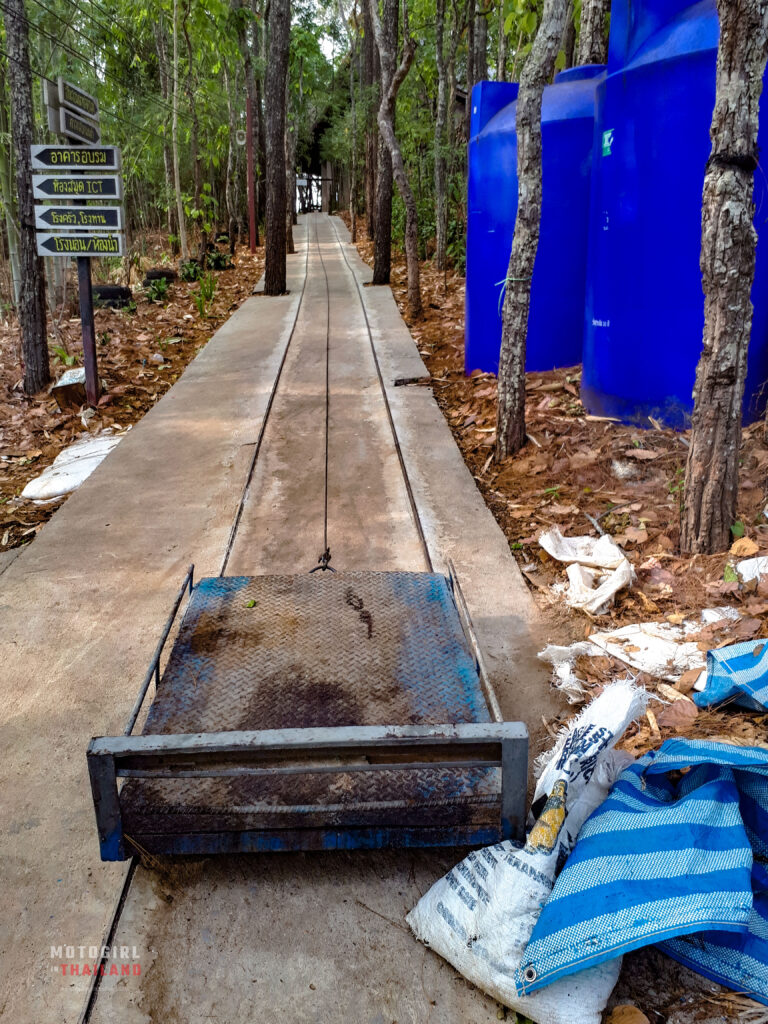
Architectural Features:
The temple grounds are thoughtfully integrated with the natural landscape, featuring check dams, terraced gardens, and areas designated for environmental education, all exemplifying the harmonious coexistence of spiritual practice and ecological mindfulness.

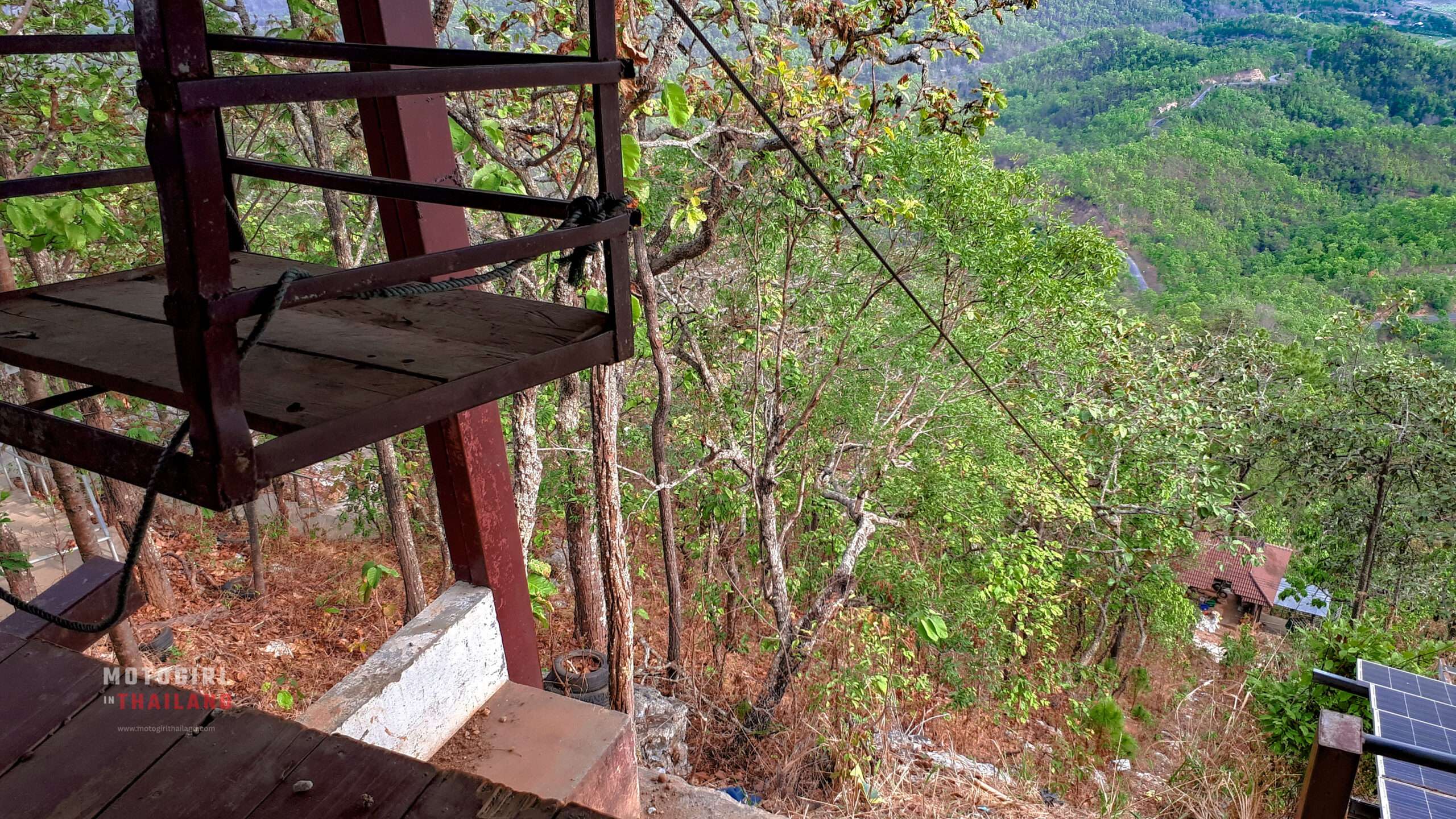
It is an interesting mix of both sustainability and Buddhist art, making it a unique and interesting local community temple.
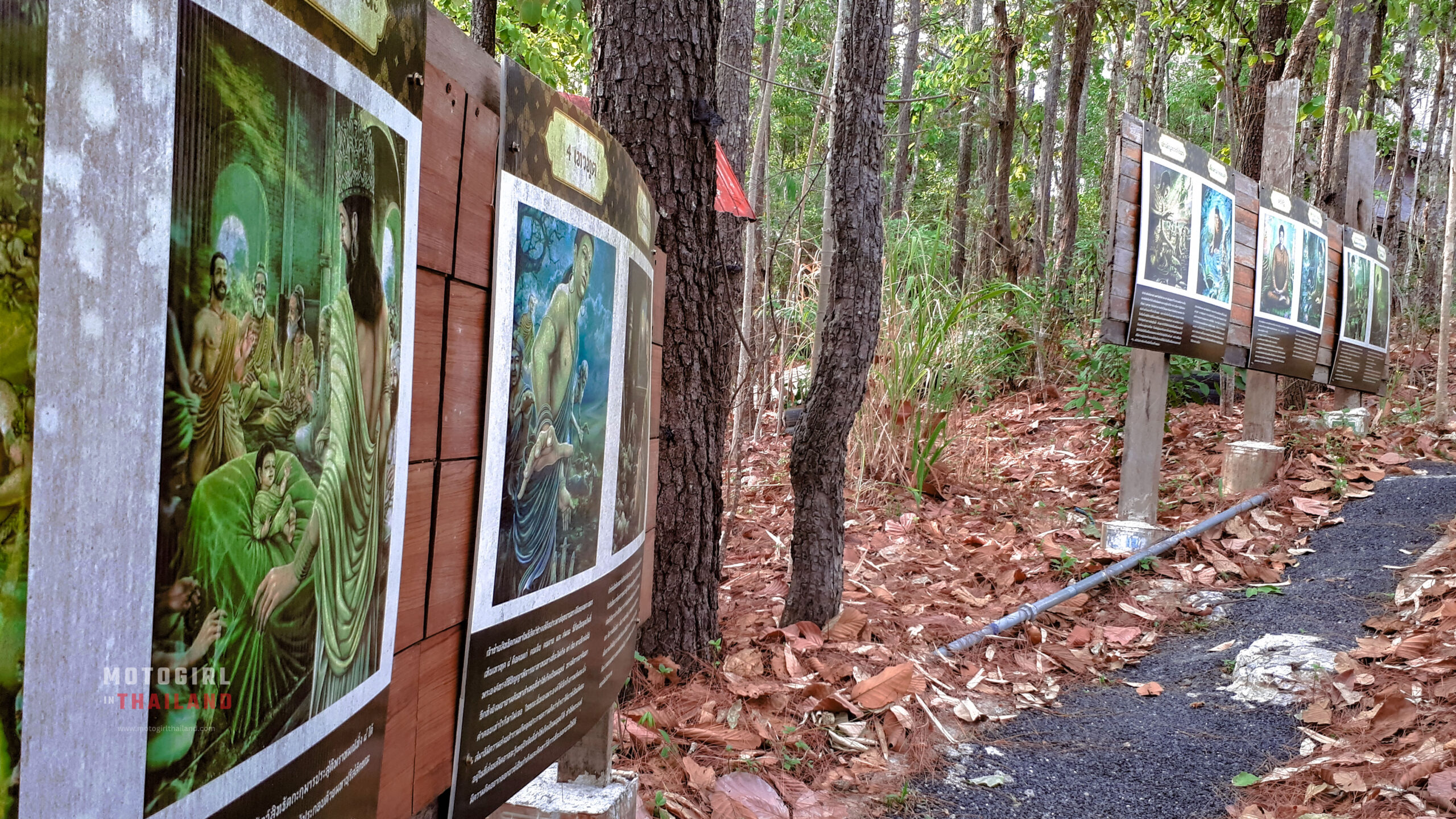
Additional Notes
It is a long walk up to the top of the temple grounds, so keep that in mind if visiting. Take water! However, there does seem to be a pulley system set up – although I am unsure if it is suitable for transporting people!
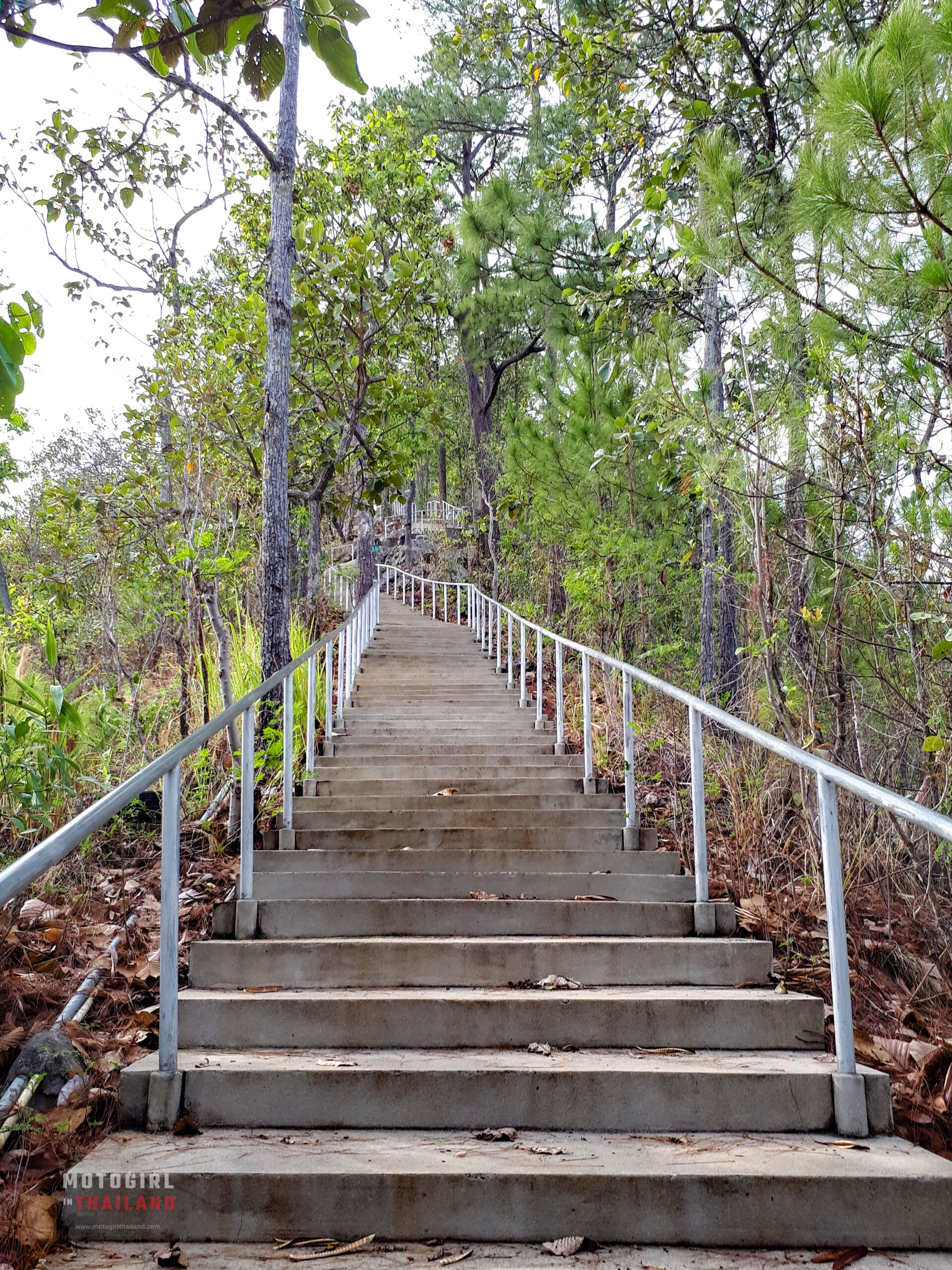
14: Shiva Brahma Narayan
Located in the San Pa Tong District of Chiang Mai, the Shiva Brahma Narayan Temple is a unique spiritual destination that harmoniously blends Hindu and Thai architectural elements. Dedicated to the Hindu Trimurti—Shiva (the destroyer), Brahma (the creator), and Narayan (Vishnu, the preserver)—this temple offers visitors a serene environment for reflection and worship. Its distinctive design and tranquil ambiance make it a noteworthy site for those interested in diverse religious traditions and cultural integration.

Details
- Location:
- Opening Hours: Daily, 9:30 AM – 4:00 PM
- Entry: Free (donations welcomed)
- Best Time to Visit: Weekday mornings for a peaceful experience
- Parking: available outside the temple.
- Food/Drinks: Cafe on site for drinks and snacks.




Historical and Cultural Aspects:
Established in 2022, the Shiva Brahma Narayan Temple serves as a spiritual haven that reflects the syncretism of Hindu and Thai religious practices. It has quickly become a popular site for Thai visitors seeking to pay respects to the Trimurti. The temple’s design and rituals are influenced by both Hindu traditions and local Thai customs, offering a unique perspective on the cultural interplay between these two rich heritages.

Architectural Features:
The temple showcases a harmonious blend of Hindu and Thai architectural styles. Upon entering the compound, visitors are greeted by intricately designed structures adorned with traditional motifs. The central sanctum houses statues of the Trimurti—Shiva, Brahma, and Narayan—each depicted with symbolic attributes that represent their respective roles in the cosmic cycle. The temple’s layout and ornamentation reflect a thoughtful integration of artistic elements from both cultures, creating a visually captivating and spiritually enriching environment.



What to Expect:
Visitors can anticipate a tranquil atmosphere conducive to meditation and contemplation. The temple grounds are well-maintained, offering peaceful surroundings that encourage introspection. Occasionally, religious ceremonies and festivals are held, providing opportunities to witness traditional rituals and community gatherings. As with all sacred sites, respectful attire and behavior are expected.
15: Wat Sampathaya Wanaram
Nestled in the tranquil forests of Mae On District, Chiang Mai, Wat Sampathaya Wanaram is a serene Dhamma practice center that offers a peaceful environment for meditation and spiritual reflection. Established by Mr. Sirawat and Mrs. Jiratcha Thepkongkham, the center embodies their deep faith in Buddhism and commitment to a simple, mindful lifestyle. Surrounded by lush greenery and the gentle sounds of nature, this retreat provides an ideal setting for those seeking solace and inner peace.

Details
- Location:
- Opening Hours: Daily, 6:00 AM – 6:00 PM
- Entry: Free (donations welcomed)
- Best Time to Visit: Early morning or late afternoon for cooler temperatures and a peaceful experience.
- Parking: on-site.
- Food/Drinks: It’s advisable to bring water and snacks.




Historical and Cultural Aspects:
Wat Sampathaya Wanaram began as a personal retreat for its founders, who moved to the area in 2010 seeking a life immersed in nature and spiritual practice. Initially living in a tent without modern amenities, they gradually developed the site into a Dhamma practice center, constructing facilities to accommodate visiting practitioners and monks. The center emphasizes the practice of Anapanasati (mindfulness of breathing) meditation and adheres to traditional Buddhist principles.

Architectural Features:
The center’s architecture reflects its commitment to simplicity and harmony with nature. Structures are modest and constructed using natural materials, blending seamlessly with the surrounding forest. Facilities include meditation halls, simple accommodations, and communal areas designed to support a contemplative lifestyle. The emphasis on minimalism and sustainability creates an environment conducive to introspection and spiritual growth.



What to Expect:
Visitors can expect a tranquil atmosphere ideal for meditation and self-reflection. The center welcomes individuals interested in practicing mindfulness and participating in Dhamma activities. While the facilities are basic, they are thoughtfully designed to support a focused and undisturbed practice. As a place dedicated to spiritual development, visitors are encouraged to observe silence and respect the center’s guidelines.
For more information, please visit the official website: www.sampathaya-wanaram.com
16: Wat Hua Dong Samakkhitham
Nestled in the tranquil village of Ban Hua Dong in Rim Nuea Subdistrict, Mae Rim District, Chiang Mai Province, Wat Hua Dong Samakkhitham serves as a spiritual and communal hub for local residents. While not widely known among tourists, this temple embodies the essence of a traditional Thai Buddhist temple, offering a serene environment for meditation and community gatherings.

Details
- Location:
- Opening Hours: Daily, 6:00 AM – 6:00 PM
- Entry: Free (donations welcomed)
- Best Time to Visit: Early morning or late afternoon for cooler temperatures and a peaceful experience.
- Parking: available on-site.
- Food/Drinks: Limited facilities; it’s advisable to bring water and snacks.




Historical and Cultural Aspects:
According to local elders, the area where Wat Hua Dong Samakkhitham now stands was once a dense forest adjacent to a cemetery, characterized by tall trees and a quiet, somewhat mysterious atmosphere. Over time, villagers began to use the space for spiritual gatherings, and a small shrine was built. Through local dedication and community effort, the temple evolved into a full-fledged monastery. The word “Samakkhitham” (สามัคคีธรรม) reflects the spirit of unity and harmony that shaped its founding. Today, the temple plays a vital role in preserving local Buddhist traditions, hosting festivals, meditation events, and merit-making ceremonies throughout the year.

Architectural Features:
Wat Hua Dong Samakkhitham features a mix of modest Lanna-style architecture and modern additions. The main viharn (ordination hall) is adorned with traditional northern Thai roof tiers, while colorful murals and Buddha statues reflect local artistic influences. A newly built ubosot (ordination hall) serves as the heart of religious ceremonies. Surrounding structures include monk living quarters, a community kitchen, and an open-air pavilion often used for dhamma talks and communal meals. The setting—surrounded by farmland and gently rolling hills—enhances the temple’s peaceful ambiance.



What to Expect:
Expect a warm and inviting community atmosphere where visitors are welcome to quietly observe daily temple life. You may encounter local villagers making merit, sweeping the temple grounds, or preparing offerings. Chanting and meditation take place regularly, especially during Buddhist holy days. While not a major tourist destination, the temple offers a genuine cultural experience and a chance to witness how Thai Buddhism continues to thrive in rural communities.
at Hua Dong Samakkhitham is a hidden gem that beautifully illustrates how spiritual life and rural tradition intersect in Northern Thailand. Its foundation, rooted in local unity and quiet resilience, makes it more than just a religious site—it is a symbol of togetherness, mindfulness, and community spirit. For visitors seeking an authentic, less-commercial temple experience, this is a meaningful and enriching stop.
17: Wat Mae Kaet Noi
!!***WARNING*** – DISTURBING IMAGES/VIDEO !!
Do NOT watch if you are sensitive to disturbing images or if you are under 13 years old.
Located in the San Sai District of Chiang Mai, Wat Mae Kaet Noi is renowned for its vivid and graphic depictions of Buddhist hell, known as Naraka. This temple offers a stark contrast to the serene and peaceful ambiance typically associated with Thai temples. The temple’s “Hell Garden” features life-sized statues and scenes illustrating the consequences of immoral actions, serving as a visual representation of karmic retribution and a moral lesson for visitors.

Details
- Location: 20 km from City. (Map)
- Opening Hours: Daily, 8:00 AM – 6:00 PM
- Entry: 10 Baht (coin-operated gate). Bring plenty of 10 Baht coins if you wish to trigger the coin-operated statues.
- Best Time to Visit: Weekday mornings to avoid crowds..
- Parking: Available in the main temple section or park roadside.
- Food/Drinks: Nothing on-site; it’s advisable to bring water and snacks.




Historical and Cultural Aspects:
The temple’s Hell Garden was conceptualized by the abbot, Phra Kru Vishanjalikon, who, inspired by a vivid dream, sought to create a physical representation of Buddhist hell to educate people about the consequences of sinful actions. Over two decades, he collaborated with artists and sculptors to bring this vision to life, resulting in a unique and thought-provoking addition to the temple grounds.

Architectural Features:
While the main temple structures adhere to traditional Thai architectural styles, the standout feature is the Hell Garden. This area contains a series of sculptures depicting various punishments for sins such as lying, adultery, and theft. The graphic nature of these displays is intended to instill a sense of moral awareness and reflection among visitors.



What to Expect:
Visitors can expect a unique and immersive experience that combines traditional religious elements with stark moral lessons. The Hell Garden is not recommended for young children or those sensitive to graphic imagery. Despite its intense displays, the temple serves as a powerful reminder of the importance of ethical living and the consequences of one’s actions.
This “Hell Temple” in San Sai, is one of a few Hell Temples in Thailand depicting the Buddhist vision of Hell. No serene images of meditation and harmony for you here (well actually, there is later on in the temple, but only a small part of it). Instead you are faced with the punishment of your sins committed on earth, in all it’s gory forms. Tortured souls writhe in agony as they are put through horrific ordeals by grotesque demons. For additional effect you can listen to horror sounds and watch moving parts and flashing lights, for the cost of ten baht per display. So take plenty of ten baht coins for the slot machines dotted around the temple grounds, if you want to immerse in the full effect.
An interesting temple and only around 15km / 30 minutes from the center of Chiang Mai.
18: Wat Hua Dong Samakkhitham
Wat Hua Dong Samakkhitham serves as a community temple for local residents. While not particularly spectacular compared to the other temples mentioned, what makes this temple interesting, is the unexpected Kyaiktiyo (Golden Rock) replica. Which is why I decided to include it in the temple list. Other “Golden Rock” temples in the region include Wat Phrathat In Khwaen, in Lampang, and Phra That Inkhang, in Phrae.

Details
- Location: 20 km from City. (Map)
- Opening Hours: Daily, 6:00 AM – 6:00 PM
- Entry: Free (donations welcomed)
- Best Time to Visit: Early morning for cooler temperatures.
- Parking: Available on-site
- Food/Drinks: Limited options nearby; advisable to bring your own refreshments




Historical and Cultural Aspects:
According to local elders, the area where Wat Hua Dong Samakkhitham now stands was once a dense forest adjacent to a cemetery, characterized by tall trees and a quiet, somewhat mysterious atmosphere. Over time, villagers began to use the space for spiritual gatherings, and a small shrine was built. Through local dedication and community effort, the temple evolved into a full-fledged monastery. The word “Samakkhitham” (สามัคคีธรรม) reflects the spirit of unity and harmony that shaped its founding. Today, the temple plays a vital role in preserving local Buddhist traditions, hosting festivals, meditation events, and merit-making ceremonies throughout the year.

Architectural Features:
Wat Hua Dong Samakkhitham features a mix of modest Lanna-style architecture and modern additions. The main viharn (ordination hall) is adorned with traditional northern Thai roof tiers, while colorful murals and Buddha statues reflect local artistic influences. A newly built ubosot (ordination hall) serves as the heart of religious ceremonies. Surrounding structures include monk living quarters, a community kitchen, and an open-air pavilion often used for dhamma talks and communal meals. The setting—surrounded by farmland and gently rolling hills—enhances the temple’s peaceful ambiance.



What to Expect:
Expect a warm and inviting community atmosphere where visitors are welcome to quietly observe daily temple life. You may encounter local villagers making merit, sweeping the temple grounds, or preparing offerings. Chanting and meditation take place regularly, especially during Buddhist holy days. While not a major tourist destination, the temple offers a genuine cultural experience and a chance to witness how Thai Buddhism continues to thrive in rural communities.
The video is not the best quality as it is an old Facebook Live video. An interesting place to visit!
Wat Hua Dong Samakkhitham is a hidden gem that beautifully illustrates how spiritual life and rural tradition intersect in Northern Thailand. Its foundation, rooted in local unity and quiet resilience, makes it more than just a religious site—it is a symbol of togetherness, mindfulness, and community spirit. For visitors seeking an authentic, less-commercial temple experience, this is a meaningful and enriching stop.
19: Wat Pha Thamachart
Wat Pha Thamachart is a hidden forest sanctuary, which offers a tranquil retreat for those seeking spiritual solace amidst nature. This secluded temple, enveloped by lush forests and serene landscapes, provides an ideal setting for meditation and introspection.

Details
- Location: 20 km from City. (Map)
- Opening Hours: Daily, 6:00 AM – 6:00 PM
- Entry: Free (donations welcomed)
- Best Time to Visit: Early morning for cooler temperatures.
- Parking: Available on-site
- Food/Drinks: Nothing available on-site, but cafes and eateries are in the general area.



Historical and Cultural Aspects:
Wat Pha Thamachart, meaning “Temple of the Natural Cliff,” is renowned for its integration with the surrounding natural environment. The temple serves as a center for Buddhist practice, emphasizing harmony between spiritual development and nature. Monks and visitors alike engage in meditation and mindfulness practices, drawing inspiration from the serene surroundings.

Architectural Features:
The temple’s architecture harmoniously blends traditional Thai design with the natural landscape. Structures are thoughtfully positioned to complement the contours of the land, with meditation halls and living quarters nestled among trees and rock formations. Natural materials are used extensively, reinforcing the temple’s commitment to simplicity and environmental harmony.



What to Expect:
Visitors can expect a serene atmosphere conducive to meditation and reflection. The temple grounds are characterized by quiet walking paths, shaded areas for contemplation, and spaces designed for communal practice. While the temple is open to visitors, it is primarily a place of spiritual practice, so respectful behavior and attire are expected.
At the time I visited the temple it seemed almost abandoned but was obviously occupied and just a little neglected. No one was around and no real signs of life except some small laundry drying in the wind-down by accommodation huts. I have not been back in some time, so I have no idea of the current condition. This temple is worth a look. It has a lost in time feel about it (and a little eerie to be honest. Particularly because when I visited the ground was littered with flying ants, mostly dead or dying).
20: Wat Mok Khan Lan
Away from the tourist trail, วัดโมคคัลลาน / Wat Mok Khan Lan is also known as “The Temple of Dinosaurs”, due to the many unusual statues within. It also houses beautiful huge Buddha images, which can be seen at a distance on the roadside.

Details
- Location: 60 km from City. (Map)
- Opening Hours: Daily, 6:00 AM – 6:00 PM
- Entry: Free (donations welcomed)
- Best Time to Visit: Early morning for cooler temperatures.
- Parking: Available on-site
- Food/Drinks: Limited options nearby; advisable to bring your own refreshments



Historical and Cultural Aspects:
Wat Mok Khan Lan serves as a local center for Buddhist practice and community gatherings. Its distinctive feature is the integration of various sculptures, including dinosaurs and mythical creatures, alongside traditional Buddhist imagery. This eclectic mix reflects a creative approach to spiritual storytelling and community engagement.

Architectural Features:
Wat Mok Khan Lan features a massive golden reclining Buddha as a central highlight, surrounded by eclectic sculptures that set it apart from more traditional temples. Scattered throughout the lush garden grounds are whimsical statues, including dinosaurs, Godzilla, King Kong, and mythical creatures, creating a surreal and playful landscape. Traditional elements such as Buddha images, shrines, and pavilions are thoughtfully integrated among these modern sculptures, blending spirituality with imaginative artistry.



What to Expect:
The temple is called Wat Hua Dong and surprisingly the monks were wearing orange instead of red (red being the usual colour for Burmese Monks, so I believe). Thus, would appear to be a Thai temple..? Not quite sure, and regrettably forgot to ask the Abbot that I spoke to.
The video is not the best quality as it is an old Facebook Live video. An interesting place to visit!
This temple isn’t remote in the least and easily accessible, and yet it is surprising the number of people who are unaware of it. Even those who are familiar with Huay Tung Tao lake just pass it by as their focus is on the lake, rather than the temple. It is a very interesting temple though and very quiet. Last year my friends and I were lucky enough to be allowed a photo opportunity there (a promo photo op for TBB Tours). If you wish to do something similar make sure to ask permission first from the guard. I actually don’t have a lot of images of this temple, although I have been a few times. However, there are some fantastic images and a great write up on this temple on GT.Rider forum. There is information about the temple on-site, and occasionally a small tuck shop open (where I bought the tiniest Cornetto-style ice cream I have ever eaten in my life..!)

Temple Etiquette Guide for Visitors
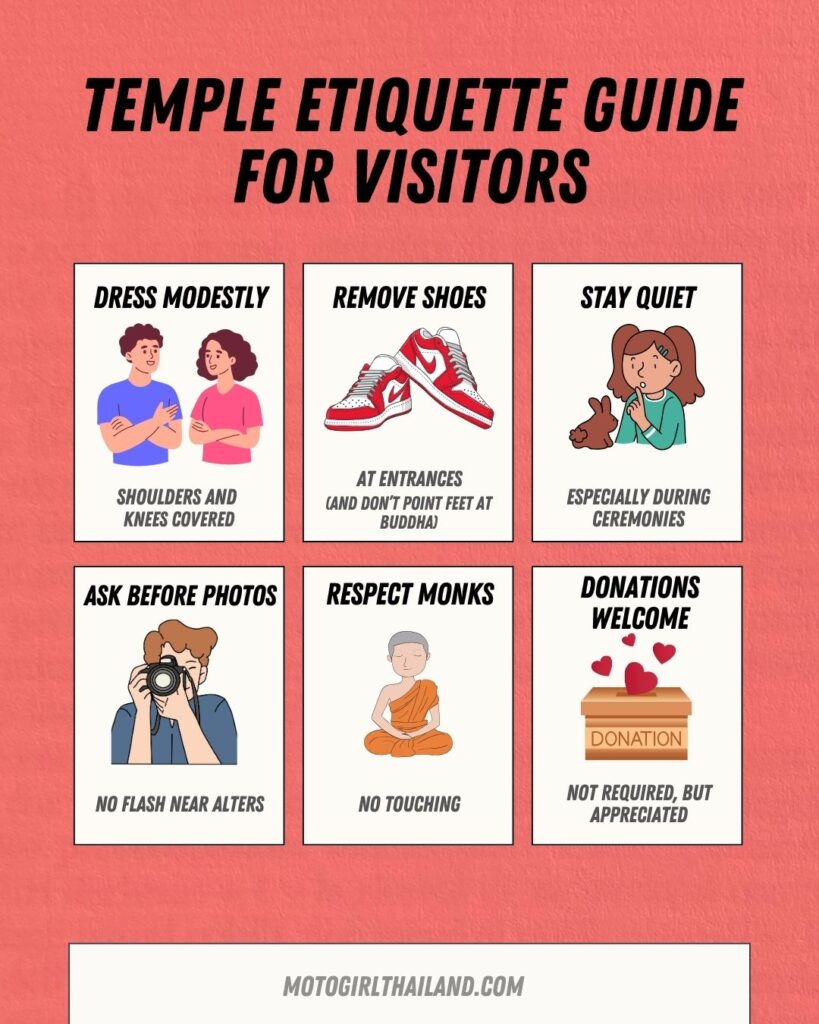
1. Dress Modestly
- Cover shoulders and knees.
- Avoid tight, sheer, or revealing clothing.
- Remove hats and sunglasses.
2. Remove Shoes
- Always take off your shoes before entering the temple buildings (viharn, ubosot, etc.).
3. Be Respectful
- Speak softly.
- Avoid loud laughter or shouting.
- Turn your phone to silent mode.
4. Mind Your Posture
- Don’t point your feet at Buddha images, monks, or people.
- Sit politely (legs to the side or cross-legged).
5. Respect Buddha Images
- Never climb on or touch Buddha statues for photos.
- Always show reverence when near Buddha images.
6. Interact Respectfully with Monks
- Women should not touch monks or hand items directly.
- If offering something, place it on a cloth or nearby surface.
7. Photography
- Always ask permission before taking photos, especially during ceremonies.
- Avoid using flash inside sacred areas.
8. Donations
- Donations are welcome but not mandatory. Contribute only if you wish.
9. Stay Mindful
- Temples are active places of worship. Be mindful of ceremonies and prayer areas.
- Follow any posted signs or directions.
@Motogirlthailand
Riding solo in Thailand and sharing my adventures, insights, and tips is a passion of mine. If you’ve enjoyed my report, there are a few ways you can support me and help keep the wheels turning.
Say Thanks!:
Consider buying me a coffee through BuyMeACoffee.com/motogirlthailand or becoming a patron on Patreon.com/motogirlthailand. Your support helps me continue creating content, exploring new routes, and bringing you closer to the rich culture and landscapes of Thailand.
Motogirl Shop!:
Check out my shop page where you can find MotoSplore GPS Route Map guides, exclusive MotoGirlThailand merchandise and products I recommend for every rider. Every purchase gives you a great adventure and helps fund and support the running costs for Motogirlthailand.com


